Paul van Yperen's Blog, page 132
February 28, 2022
Helen Shapiro
From 1961 until 1963, Helen Shapiro (1946) was England's teenage pop music queen. At one point she sold 40,000 copies daily of her biggest single, 'Walkin' Back to Happiness', during a 19-week chart run. The singer and actress with her deep timbre and beehive hairstyle was only 14 when she was discovered, but she matured into a seasoned professional very quickly. She also appeared in a few teen musicals in the early 1960s.
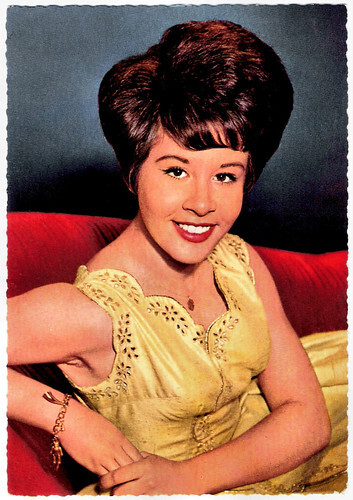
West-German postcard by Krüger, no. 902/175. Photo: Hansi Hoffmann.
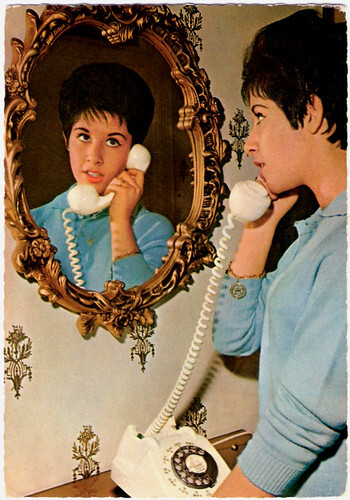
Dutch postcard by Gebr. Spanjersberg N.V., Rotterdam.
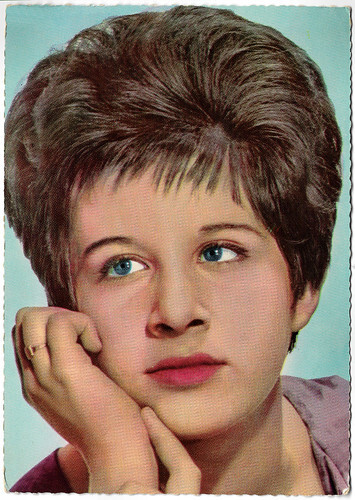
Belgian postcard by S. Best (SB), Antwerpen.
Foghorn
Helen Kate Shapiro was born in Bethnal Green in the East End of London in 1946. She is the granddaughter of Russian Jewish immigrants, and her parents, who were piece-workers in the garment industry, attended Lea Bridge Road Synagogue. They were too poor to own a record player but encouraged music in their home.
At age 9, Helen performed with a banjo in the school group Susie & the Hula Hoops, whose members included also her cousin, 1960s singer Susan Singer and a young Mark Feld aka Marc Bolan, later of glam-rock band T-Rex. Reportedly, they performed their own versions of Elvis Presley and Buddy Holly songs. She subsequently sang with her brother Ron Shapiro's trad jazz turned skiffle outfit at local clubs before enrolling in classes at Maurice Burman's Academy in London.
Shapiro had a deep timbre to her voice, unusual in a girl not yet in her teens. School friends gave her the nickname ‘Foghorn’. Maurice Burman was so enamoured of Helen’s talent that he waived the fees to keep her as a student. He wrote to several record labels to promote interest in his students. John Schroeder, a young songwriter and A&R man at EMI's Columbia Records, heard her at one of the classes. He was impressed enough to record a demo of Shapiro singing 'Birth of the Blues' and play it back for top EMI producer Norrie Paramor, who had signed Cliff Richard & the Shadows.
Helen Shapiro's voice on the rape was so mature that Paramor refused to believe that it belonged to a 14-year-old girl. So, Helen came to his office in her school uniform and sang 'St. Louis Blues'. Only a few weeks later, she cut her first single, 'Please Don't Treat Me Like a Child', composed by John Schroeder and Mike Hawker. It made number three in the UK charts in May 1961, and the record company’s publicity department made a great play on the novelty value of her age.
Shapiro’s second release, the ballad 'You don’t know', was issued three months later. In August 1961, it made 14-year-old Helen the youngest female artist to reach number one. The song stayed at the top of the charts for two weeks and eventually sold over a million copies. In September that year, she turned 15 and left school to pursue her career in earnest. Live appearances showcased Helen’s assuredness as a performer. She even headlined at the legendary London Palladium, virtually unheard of for such a young, inexperienced entertainer.
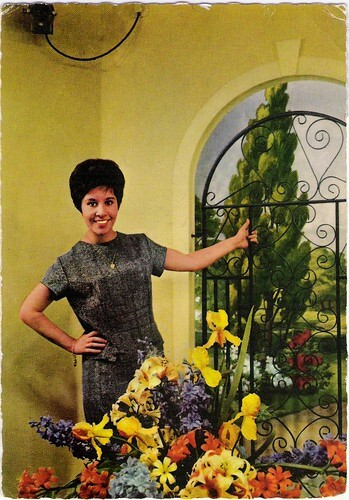
Dutch postcard by De Gruyter, no. 8.
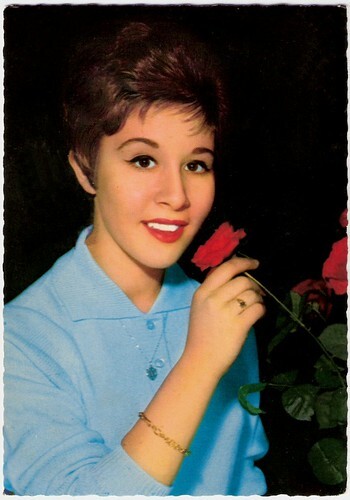
Dutch postcard by Gebr. Spanjersberg N.V., Rotterdam.
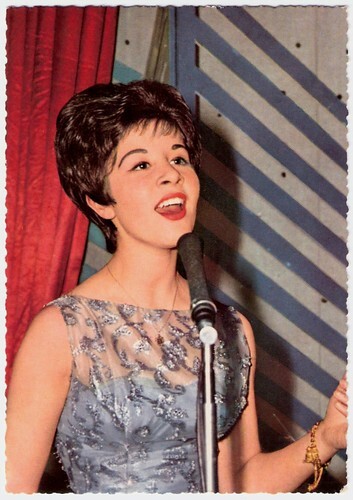
German postcard by Krüger, no. 902/176. Photo: EMI, London.
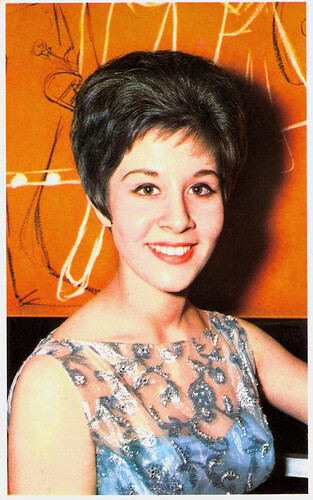
French postcard by Editions P.I., Paris, offered by Corvisart, Epinal, no. 1080. Photo: Ektochrome Anders.
A Little Dynamo
Helen Shapiro had her second number one hit in the UK with 'Walkin' Back to Happiness'. It is now her signature song. Her mature voice made her an overnight sensation. The song also became a hit in the rest of Europe and inspired an attempt to crack the American market. However, despite an appearance on the legendary Ed Sullivan Show, the record only reached # 100 in the US charts.
In 1962 she made her debut feature film, It's Trad, Dad!/Ring-A-Ding Rhythm (Richard Lester, 1962). This musical comedy was one of the first films put out by predominantly horror company Amicus Productions, and director Richard Lester's feature debut. Shapiro and singer Craig Douglas play two teenagers who, along with their friends enjoy the latest trend of traditional jazz. However, the mayor as well as a group of adults dislike the trend and move to have a coffee shop jukebox taken away. Helen and Craig decide to organize a music festival in their small town, and the film comprises musical numbers by Chubby Checker, Del Shannon, and Gene Vincent.
Jeff Stafford at TCM : "Any Richard Lester fan can look at It's Trad, Dad and see the fresh and distinctive techniques that would fully emerge in Lester's A Hard Day's Night. For one thing, Lester's playful editing style keeps the viewer constantly engaged while also paying tribute to the musicians on display. (...) Douglas is a pleasant but unremarkable light pop vocalist but Shapiro is a little dynamo with a powerful voice comparable to Brenda Lee."
Shapiro then starred in another teenage musical, Play It Cool (Michael Winner, 1962) featuring Billy Fury and the Satellites and Bobby Vee. Shapiro's next single release, 'Tell Me What He Said', peaked at no. 2, achieving her first four single releases in the top three of the UK Singles Chart. Her final UK Top Ten hit single was with the ballad 'Little Miss Lonely', which peaked at no. 8 for two weeks in 1962.
Before she was sixteen years old, Shapiro had been voted Britain's 'Top Female Singer', and when The Beatles had their first national tour (The Helen Shapiro Tour) in 1963, it was as her supporting act. During the tour, The Beatles hit big and replaced Helen as top of the bill.
Helen later found out that it was around this time that Lennon and McCartney penned 'Misery' for her, but her producer Norrie Paramor declined the offer without informing her. He preferred to release 'Queen for tonight', a firm fan favourite and a much-requested song, but slightly out of step with current trends. It reached a disappointing 33 in the UK charts. In early 1964, her cover of 'Fever' proved her last top 40 hit.
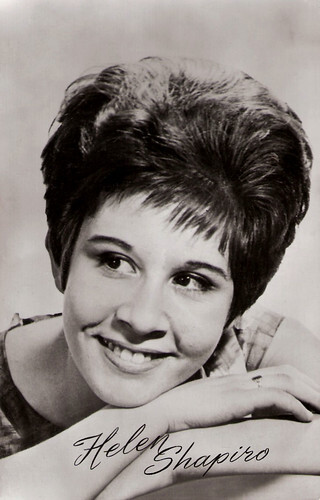
Dutch postcard by Takken, Utrecht, no. 4906. Photo: Columbia.
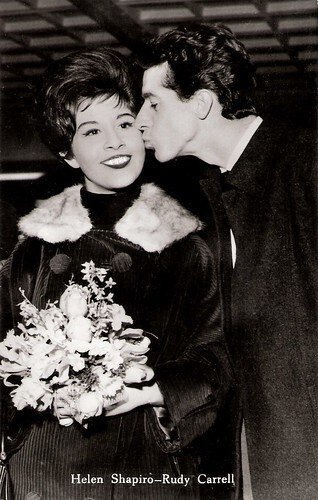
Helen Shapiro and Rudi Carrell . Dutch postcard by Sparo (Gebr. Spanjersberg N.V., Rotterdam). Sent by mail in the Netherlands in 1966. Photo: Columbia.
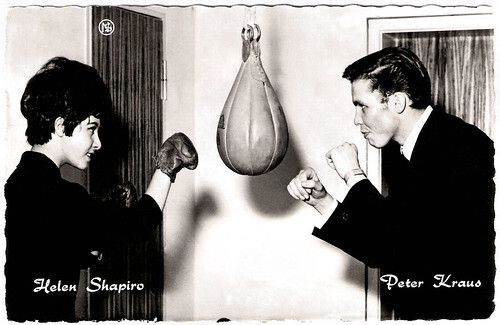
Helen Shapiro and Peter Kraus. Dutch postcard, no. 6357. Sent by mail in the Netherlands in 1965.
Musicals, Jazz, Gospel
By the time Helen Shapiro was in her late teens, her career as a pop singer was on the wane. Undaunted, she branched out as a performer in stage musicals, a jazz singer (jazz being her first love musically), and more recently a gospel singer. She also began to concentrate more on stage work.
In the early 1980s, she played the role of Nancy in Lionel Bart's musical, 'Oliver!' in London's West End. Various other musicals, pantomimes, and revival concerts followed. She also continued to tour, especially in mainland Europe and the Far East, where she remained in demand.
Throughout the 1980s she made guest appearances on many TV variety shows, either singing her old songs or promoting the odd new release. Shapiro also appeared in British television soap operas; in particular, Albion Market (1985) where she played one of the main characters up to the time it was taken off-air in August 1986.
In 1987 Shapiro became a committed Christian (Messianic believer). She has issued four Messianic albums since then, and appeared in a number of special Gospel Outreach evenings, singing and telling of how she found Jesus (Yeshua) as her Messiah. Shapiro retired from showbusiness at the end of 2002 to concentrate on her Gospel Outreach evenings.
In 1993, she published her autobiography, 'Walking Back to Happiness'. Since 2015, she has played in a trio called Hebron with Chrissy Rodgers and Simon Elman. They are promoted via Shapiro's ministry umbrella, Manna Music. She was married three times: Duncan C. Weldon (1967-1971), Morris Gundlash (1972-1977), and John Judd (1988-), an actor with numerous roles in British television and cinema. The couple lives in Kent.
Bruce Eder at AllMusic : "Listening to Shapiro's records nearly 40 years later, it's amazing to think that her hit-making career lasted only two years. She was equally at home belting out "The Birth of the Blues," imparting a surprisingly blues-influenced feeling to 'A Teenager in Love', or oozing pre-feminist defiance in 'Walking Back to Happiness', and by rights should have been able to find a niche on the charts well into the middle and late '60s. The incongruity of a 15-year-old who might usually be spending her time in high school doing a song like 'Walking Back to Happiness' was lost in the more innocent era in which she worked."
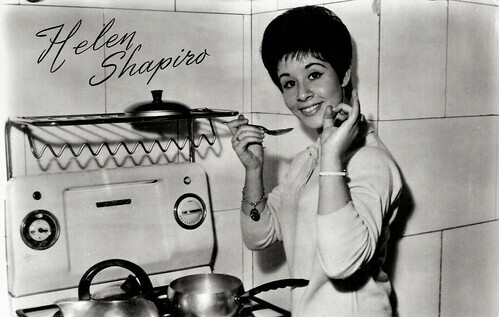
Dutch postcard by Takken, Utrecht, no. AX 4930.
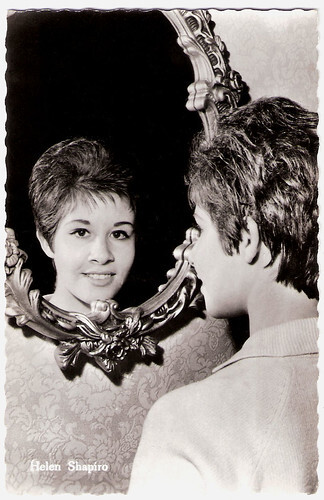
Dutch postcard, no. 262.
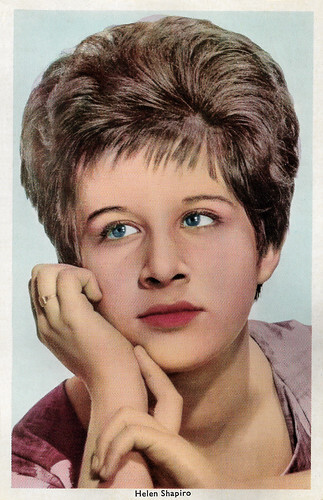
Vintage card.
Helen Shapiro sings 'Walking Back To Happiness' in a Dutch TV show of Rudi Carrell . Part of a short documentary by Top 2000 a gogo from 2003. Source: Dutch Public Television (YouTube).
Sources: Jeff Stafford (TCM - now defunct), Graham Welch (Ready Steady Girls), Bruce Eder (AllMusic), Wikipedia, and .

West-German postcard by Krüger, no. 902/175. Photo: Hansi Hoffmann.

Dutch postcard by Gebr. Spanjersberg N.V., Rotterdam.

Belgian postcard by S. Best (SB), Antwerpen.
Foghorn
Helen Kate Shapiro was born in Bethnal Green in the East End of London in 1946. She is the granddaughter of Russian Jewish immigrants, and her parents, who were piece-workers in the garment industry, attended Lea Bridge Road Synagogue. They were too poor to own a record player but encouraged music in their home.
At age 9, Helen performed with a banjo in the school group Susie & the Hula Hoops, whose members included also her cousin, 1960s singer Susan Singer and a young Mark Feld aka Marc Bolan, later of glam-rock band T-Rex. Reportedly, they performed their own versions of Elvis Presley and Buddy Holly songs. She subsequently sang with her brother Ron Shapiro's trad jazz turned skiffle outfit at local clubs before enrolling in classes at Maurice Burman's Academy in London.
Shapiro had a deep timbre to her voice, unusual in a girl not yet in her teens. School friends gave her the nickname ‘Foghorn’. Maurice Burman was so enamoured of Helen’s talent that he waived the fees to keep her as a student. He wrote to several record labels to promote interest in his students. John Schroeder, a young songwriter and A&R man at EMI's Columbia Records, heard her at one of the classes. He was impressed enough to record a demo of Shapiro singing 'Birth of the Blues' and play it back for top EMI producer Norrie Paramor, who had signed Cliff Richard & the Shadows.
Helen Shapiro's voice on the rape was so mature that Paramor refused to believe that it belonged to a 14-year-old girl. So, Helen came to his office in her school uniform and sang 'St. Louis Blues'. Only a few weeks later, she cut her first single, 'Please Don't Treat Me Like a Child', composed by John Schroeder and Mike Hawker. It made number three in the UK charts in May 1961, and the record company’s publicity department made a great play on the novelty value of her age.
Shapiro’s second release, the ballad 'You don’t know', was issued three months later. In August 1961, it made 14-year-old Helen the youngest female artist to reach number one. The song stayed at the top of the charts for two weeks and eventually sold over a million copies. In September that year, she turned 15 and left school to pursue her career in earnest. Live appearances showcased Helen’s assuredness as a performer. She even headlined at the legendary London Palladium, virtually unheard of for such a young, inexperienced entertainer.

Dutch postcard by De Gruyter, no. 8.

Dutch postcard by Gebr. Spanjersberg N.V., Rotterdam.

German postcard by Krüger, no. 902/176. Photo: EMI, London.

French postcard by Editions P.I., Paris, offered by Corvisart, Epinal, no. 1080. Photo: Ektochrome Anders.
A Little Dynamo
Helen Shapiro had her second number one hit in the UK with 'Walkin' Back to Happiness'. It is now her signature song. Her mature voice made her an overnight sensation. The song also became a hit in the rest of Europe and inspired an attempt to crack the American market. However, despite an appearance on the legendary Ed Sullivan Show, the record only reached # 100 in the US charts.
In 1962 she made her debut feature film, It's Trad, Dad!/Ring-A-Ding Rhythm (Richard Lester, 1962). This musical comedy was one of the first films put out by predominantly horror company Amicus Productions, and director Richard Lester's feature debut. Shapiro and singer Craig Douglas play two teenagers who, along with their friends enjoy the latest trend of traditional jazz. However, the mayor as well as a group of adults dislike the trend and move to have a coffee shop jukebox taken away. Helen and Craig decide to organize a music festival in their small town, and the film comprises musical numbers by Chubby Checker, Del Shannon, and Gene Vincent.
Jeff Stafford at TCM : "Any Richard Lester fan can look at It's Trad, Dad and see the fresh and distinctive techniques that would fully emerge in Lester's A Hard Day's Night. For one thing, Lester's playful editing style keeps the viewer constantly engaged while also paying tribute to the musicians on display. (...) Douglas is a pleasant but unremarkable light pop vocalist but Shapiro is a little dynamo with a powerful voice comparable to Brenda Lee."
Shapiro then starred in another teenage musical, Play It Cool (Michael Winner, 1962) featuring Billy Fury and the Satellites and Bobby Vee. Shapiro's next single release, 'Tell Me What He Said', peaked at no. 2, achieving her first four single releases in the top three of the UK Singles Chart. Her final UK Top Ten hit single was with the ballad 'Little Miss Lonely', which peaked at no. 8 for two weeks in 1962.
Before she was sixteen years old, Shapiro had been voted Britain's 'Top Female Singer', and when The Beatles had their first national tour (The Helen Shapiro Tour) in 1963, it was as her supporting act. During the tour, The Beatles hit big and replaced Helen as top of the bill.
Helen later found out that it was around this time that Lennon and McCartney penned 'Misery' for her, but her producer Norrie Paramor declined the offer without informing her. He preferred to release 'Queen for tonight', a firm fan favourite and a much-requested song, but slightly out of step with current trends. It reached a disappointing 33 in the UK charts. In early 1964, her cover of 'Fever' proved her last top 40 hit.

Dutch postcard by Takken, Utrecht, no. 4906. Photo: Columbia.

Helen Shapiro and Rudi Carrell . Dutch postcard by Sparo (Gebr. Spanjersberg N.V., Rotterdam). Sent by mail in the Netherlands in 1966. Photo: Columbia.

Helen Shapiro and Peter Kraus. Dutch postcard, no. 6357. Sent by mail in the Netherlands in 1965.
Musicals, Jazz, Gospel
By the time Helen Shapiro was in her late teens, her career as a pop singer was on the wane. Undaunted, she branched out as a performer in stage musicals, a jazz singer (jazz being her first love musically), and more recently a gospel singer. She also began to concentrate more on stage work.
In the early 1980s, she played the role of Nancy in Lionel Bart's musical, 'Oliver!' in London's West End. Various other musicals, pantomimes, and revival concerts followed. She also continued to tour, especially in mainland Europe and the Far East, where she remained in demand.
Throughout the 1980s she made guest appearances on many TV variety shows, either singing her old songs or promoting the odd new release. Shapiro also appeared in British television soap operas; in particular, Albion Market (1985) where she played one of the main characters up to the time it was taken off-air in August 1986.
In 1987 Shapiro became a committed Christian (Messianic believer). She has issued four Messianic albums since then, and appeared in a number of special Gospel Outreach evenings, singing and telling of how she found Jesus (Yeshua) as her Messiah. Shapiro retired from showbusiness at the end of 2002 to concentrate on her Gospel Outreach evenings.
In 1993, she published her autobiography, 'Walking Back to Happiness'. Since 2015, she has played in a trio called Hebron with Chrissy Rodgers and Simon Elman. They are promoted via Shapiro's ministry umbrella, Manna Music. She was married three times: Duncan C. Weldon (1967-1971), Morris Gundlash (1972-1977), and John Judd (1988-), an actor with numerous roles in British television and cinema. The couple lives in Kent.
Bruce Eder at AllMusic : "Listening to Shapiro's records nearly 40 years later, it's amazing to think that her hit-making career lasted only two years. She was equally at home belting out "The Birth of the Blues," imparting a surprisingly blues-influenced feeling to 'A Teenager in Love', or oozing pre-feminist defiance in 'Walking Back to Happiness', and by rights should have been able to find a niche on the charts well into the middle and late '60s. The incongruity of a 15-year-old who might usually be spending her time in high school doing a song like 'Walking Back to Happiness' was lost in the more innocent era in which she worked."

Dutch postcard by Takken, Utrecht, no. AX 4930.

Dutch postcard, no. 262.

Vintage card.
Helen Shapiro sings 'Walking Back To Happiness' in a Dutch TV show of Rudi Carrell . Part of a short documentary by Top 2000 a gogo from 2003. Source: Dutch Public Television (YouTube).
Sources: Jeff Stafford (TCM - now defunct), Graham Welch (Ready Steady Girls), Bruce Eder (AllMusic), Wikipedia, and .
Published on February 28, 2022 22:00
February 27, 2022
Georges Marchal
Handsome and athletic Georges Marchal (1920-1997) was one of the most popular romantic heroes of the French cinema of the 1950s. Like Jean Marais, he starred in many Swashbucklers and other costume dramas in France and Italy. Later he acted in several films by his close friend Luis Buñuel.
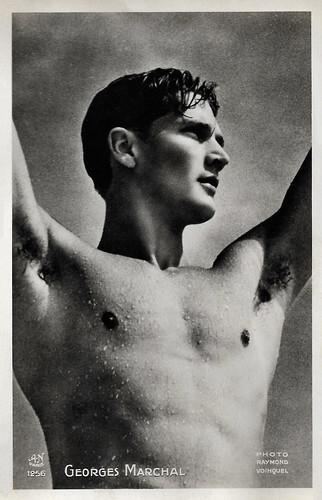
French postcard by A.N., Paris, no. 1256. Photo: Raymond Voinquel.

French postcard by Editions P.I., Paris, no. 112. Photo: Roger Carlet.
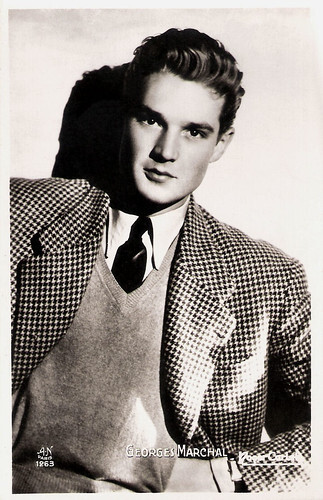
French postcard by A.N., Paris, no. 1263. Photo: Roger Carlet.
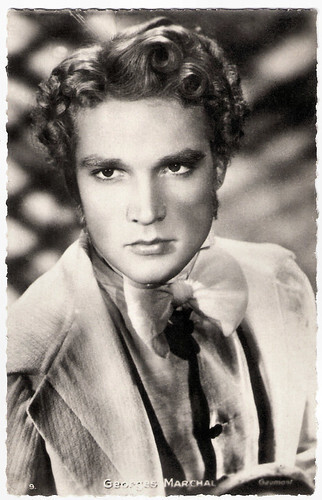
French postcard, no. 9. Photo: Gaumont.
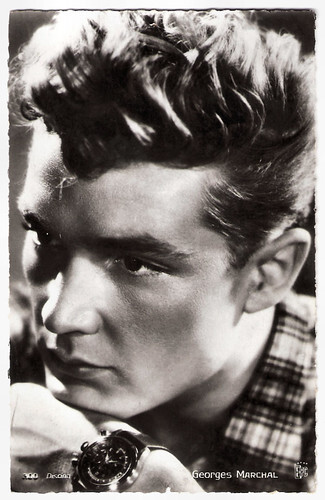
French postcard by Editions et Publications Cinématographiques (EPC), no. 300. Photo: Discina.

French postcard by Yvon for Marie France. Photo: Majestic Films / Sirius. Georges Marchal and Dany Robin in Le plus joli péché du monde/The Prettiest Sin in the World (Gilles Grangier, 1951). Caption: Georges Marchal and Dany Robin, the youngest "ideal couple" in French cinema, are more seductive than ever in the new film"Le plus joli péché du monde, The Prettiest Sin in the World. At the backside: Designate the best-suited couple in French cinema.
The Typical Jeune Premier
Georges Marchal was born as Georges Louis Lucot in Nancy, France, in 1920. His family moved to Paris, where he attended secondary school. As an adolescent, he dreamed of becoming a dancer and took classes in ballet and acrobatics. After a chance meeting with Maurice Escande , he changed his mind and aspired to become an actor.
First came many odd jobs, like courier, docker at the Les Halles market, and assistant at the Medrano circus. Then he enrolled in an acting course and was hired at the Théâtre du Palais-Royal for the play 'Permission de détente'(Permission to Relax) by Yves Mirande. At 20, he joined the Comédie-Française to play in the classic dramas 'Iphigénie' (Iphigenia) by Jean Racine and 'Psyché' (Psyche) by Molière. He soon also played in boulevard comedies.
His film career started with the comedy Fausse alerte/The French Way (Jacques de Baroncelli, Bernard Dalban, 1940) starring Josephine Baker , which was only released in 1945. During the Occupation days, he was noted in Lumière d'été/Summer Light (Jean Grémillon, 1943) opposite Madeleine Renaud , and Vautrin/Vautrin The Thief (Pierre Billon, 1943) with Michel Simon .
After the war, he co-starred in Au grand balcon/The Grand Terrace (Henri Decoin, 1949) with Pierre Fresnay , about the heroic pilots who struggled, suffered, and often died to carry the mail. He became the typical Jeune Premier of the French post-war cinema and posed as a rival of Jean Marais although he didn’t reach the same level.
In 1951, he assumed the title role in Il naufrago del Pacifico/Robinson Crusoe (Jeff Musso, 1951), and for Sacha Guitry , he played the young Louis XIV in the star-studded Si Versailles m'était conté/Affairs of Versailles (Sacha Guitry, 1953).
In 1951, he married actress Dany Robin . Both were young, beautiful, and adored. They preserved their privacy in their house in Montfort l'Amaury. Together they made six films, including La voyageuse inattendue/The Unexpected Voyager (Jean Stelli, 1950), based on an old script by Billy Wilder, and the comedy Jupiter (Gilles Grangier, 1952).
Georges’ talent as a stuntman did wonders for his parts in such costume films and Swashbucklers as Messalina/The Affairs of Messalina (Carmine Gallone, 1952) with Maria Félix , Teodora, imperatrice di Bisanzio/Theodora, Slave Empress (Riccardo Freda, 1954) with Gianna Maria Canale , and Les trois mousquetaires/The Three Musketeers (André Hunebelle, 1953) in which he featured as D'Artagnan.
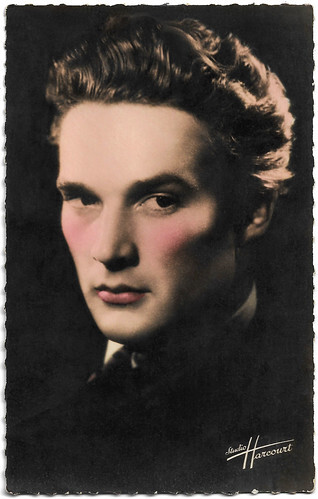
French postcard by Editions O.P., Paris, no. 44. Photo: Studio Harcourt, Paris.
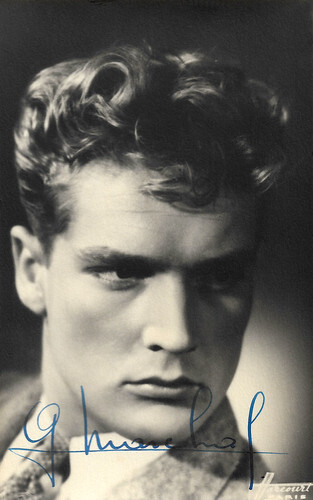
French postcard by Agfa. Photo: Studio Harcourt.
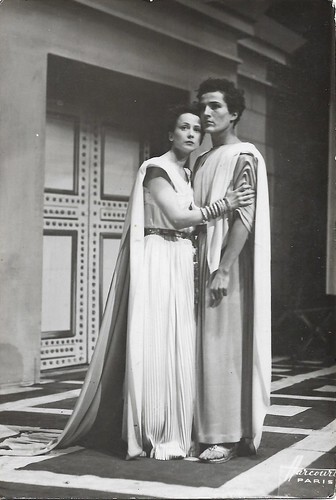
Vintage photo by Harcourt, Paris. French staging of the play 'Iphigénie en Tauride', based on Goethe, directed by Jean Yonnel and performed by the actors of the Comédie française in 1942. Georges Marchal as Pylades and unknown actress.
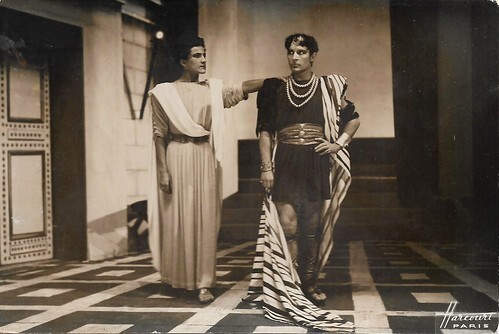
Vintage photo by Harcourt, Paris. French staging of the stage play Iphigénie en Tauride, based on Goethe, directed by Jean Yonnel and performed by the actors of the Comédie française in 1942. Here, Georges Marchal as Pylades and possibly Maurice Donneaud as Orestes.
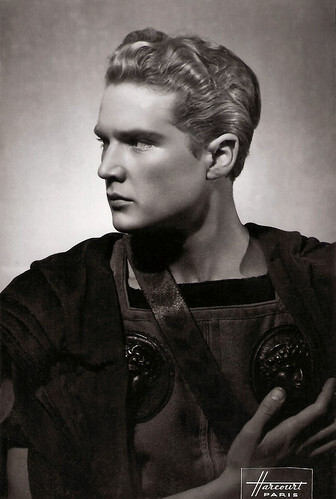
French photo. Photo: Studio Harcourt, Paris.
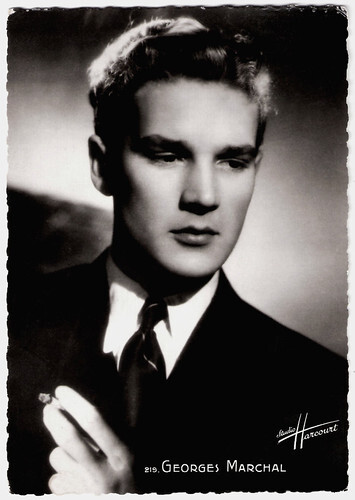
French postcard by S.E.R.P., Paris, no. 219. Photo: Studio Harcourt.
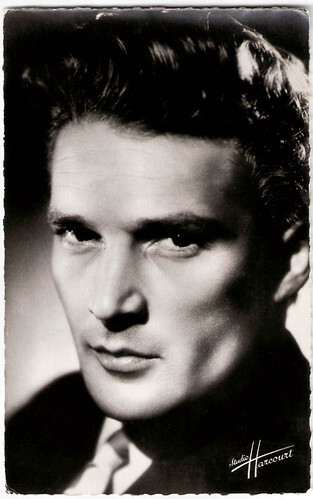
French postcard by Editions du Globe, Paris, no. 175. Photo: Studio Harcourt.
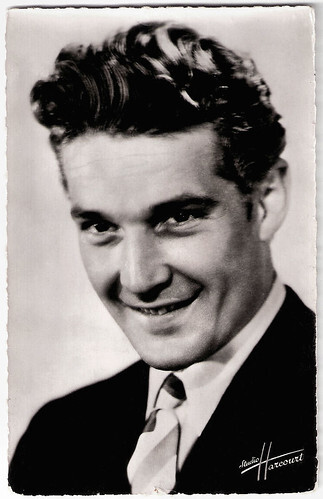
French postcard by Editions du Globe, Paris, no. 185. Photo: Studio Harcourt.
Death Knell
The arrival of the Nouvelle Vague (the New Wave of young French directors in the late 1950s) with their animosity against the Cinéma de Papa (the popular French cinema of the 1940s and 1950s) seemed a death knell for Georges Marchal. He moved to Italy where he continued his career.
With his muscular body, he was an ideal hero for the Peplum. He appeared in a dozen of these Italian Sword and Sandal epics, including Nel Segno Di Roma/Sheba and the Gladiator (Guido Brignone - and uncredited Riccardo Freda and Michelangelo Antonioni, 1958) with Anita Ekberg , Le legioni di Cleopatra/Legions of the Nile (Vittorio Cottafavi, 1959) with Linda Cristal , and Sergio Leone's first solo directorial effort, Il colosso di Rodi/The Colossus of Rhodes (Sergio Leone, 1961) with Rory Calhoun.
Marchal was a close friend of director Luis Buñuel and also one of his preferred actors. Marchal starred in four of his films: Cela s'appelle l'aurore/That is the Dawn (1955) with Lucia Bosé , La mort en ce jardin/Death in the Garden (1956) with Simone Signoret , Belle de jour/Beauty of the Day (1967) with Catherine Deneuve , and La voie lactee/The Milky Way (1969) with Laurent Terzieff .
Other interesting films in which he appeared were the anthology film Guerre secrète/The Dirty Game (Terence Young, Christian Jaque, Carlo Lizzani, Werner Klinger, 1965) with Robert Ryan, the Romanian historical epic Dacii/The Dacians (Sergiu Nicolaescu, 1967) with Pierre Brice , Faustine et le bel été/Faustine and the Beautiful Summer (Nina Companeez, 1972) and Les enfants du placard/The Closet Children (Benoît Jacquot, 1977) with Lou Castel.
During the 1970s, he focussed on television and appeared in Quentin Durward (Gilles Grangier, 1971), as Philip IV the Fair in Les rois maudits/The Accursed Kings (Claude Barma, 1972), Gaston Phébus (Bernard Borderie, 1977), and Les grandes familles/The Great Families (Edouard Molinaro, 1988) with Michel Piccoli .
He played a seductive older man in three TV-films based on the legendary Claudine novels by Colette , Claudine à Paris/Claudine in Paris (1978), Claudine en ménage/Pauline Engaged (1978) and Claudine s'en va/Claudine Goes (1978), all starring Marie-Hélène Breillat and directed by Edouard Molinaro. He also played Claude Jade 's father in the fine mini-series L'Île aux trente cercueils/The Island of Thirty Coffins (Marcel Cravenne, 1979).
He retired in 1989. His last film appearance had been as General Keller in L'Honneur d'un capitaine/A Captain’s Honour (Pierre Schoendoerffer, 1982) about the French army's behaviour in Algeria. Georges Marchal died in 1997 in Maurens, France, following a long illness. He was married to Dany Robin from 1951 till their much-publicised divorce in 1969. He remarried in 1983 to Michele Heyberger.
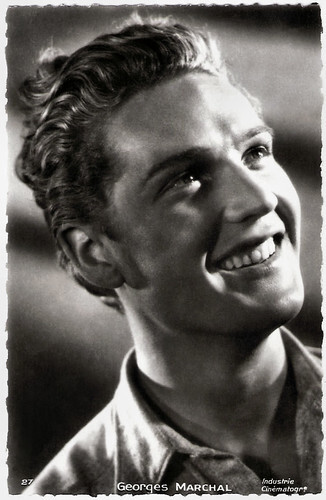
French postcard, no. 27. Photo: Industrie Photographique.
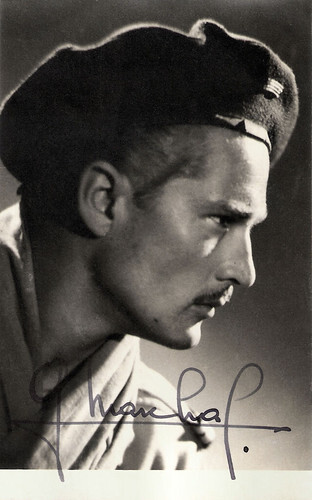
French postcard.
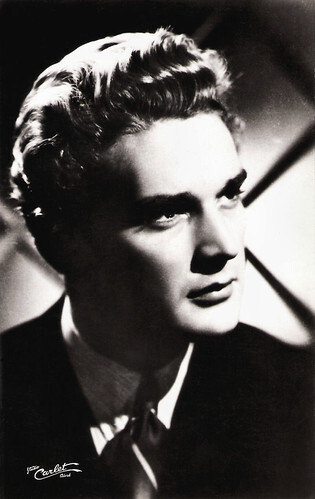
French postcard by Editions O.P., Paris, no. 59. Photo: Carlet Ainé.
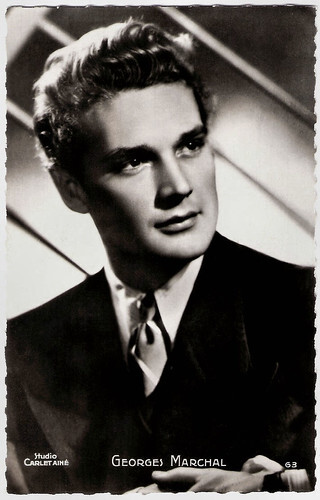
French postcard by Editions P.I., Paris, no. 172. Photo: Studio Carlet Ainé.
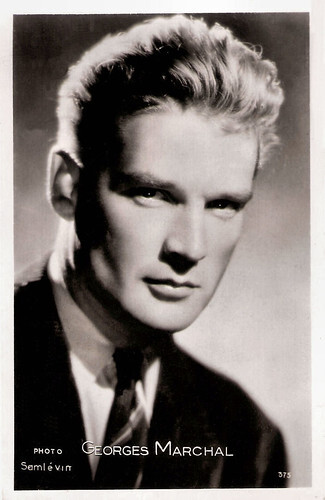
French postcard by Editions P.I., Paris, no. 375. Photo: Sam Lévin.
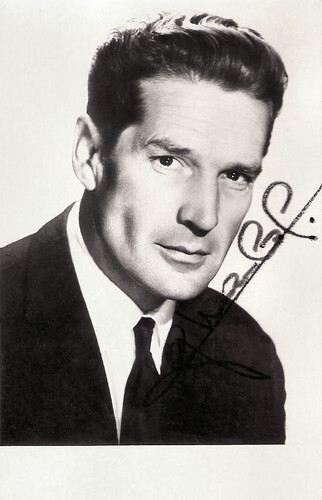
French postcard by P.I., Paris, no. S-1653. Photo: Sam Lévin.
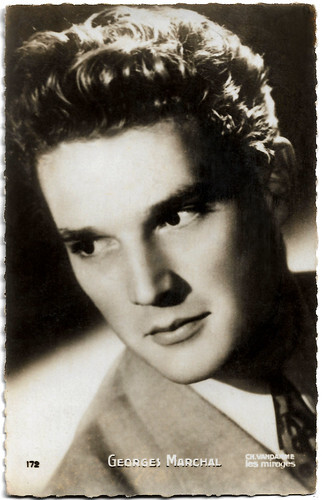
French postcard by Editions P.I., Paris, no. 172. Photo: Charles Vandamme, Les Mirages.
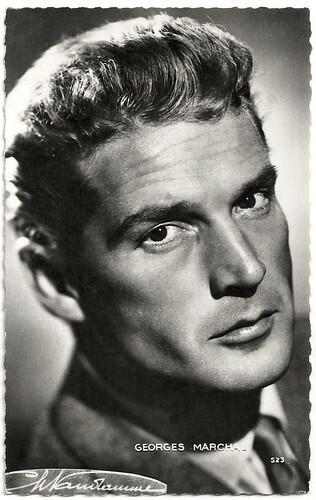
French postcard by Editions P.I., Paris, no. 523 presented by Les Carbones Korès. Photo: Ch. Vandamme.
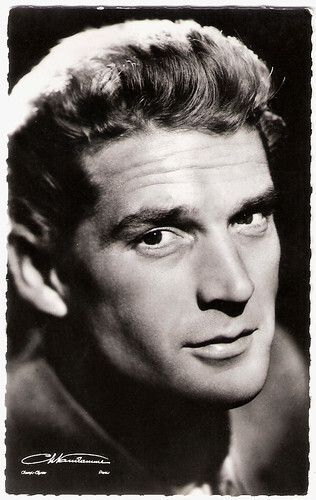
French postcard by Editions du Globe, Paris, no. 297. Photo: Charles VanDamme, Paris.
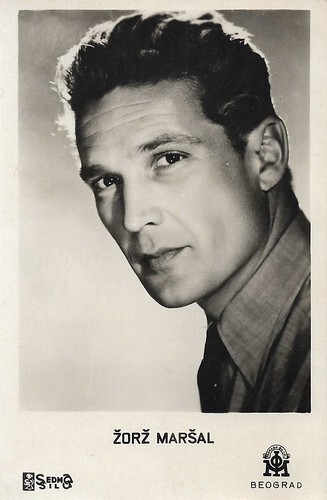
Yugoslavian postcard by Sedma Sila. Photo: Morava Film, Beograd (Belgrade).
Swashbuckling in Les trois mousquetaires/The Three Musketeers (1953). Source: Henk de Vos (YouTube).
Sources: Hal Erickson (AllMovie), (IMDb), Ciné-Ressources (French), Wikipedia (French), and .

French postcard by A.N., Paris, no. 1256. Photo: Raymond Voinquel.

French postcard by Editions P.I., Paris, no. 112. Photo: Roger Carlet.

French postcard by A.N., Paris, no. 1263. Photo: Roger Carlet.

French postcard, no. 9. Photo: Gaumont.

French postcard by Editions et Publications Cinématographiques (EPC), no. 300. Photo: Discina.

French postcard by Yvon for Marie France. Photo: Majestic Films / Sirius. Georges Marchal and Dany Robin in Le plus joli péché du monde/The Prettiest Sin in the World (Gilles Grangier, 1951). Caption: Georges Marchal and Dany Robin, the youngest "ideal couple" in French cinema, are more seductive than ever in the new film"Le plus joli péché du monde, The Prettiest Sin in the World. At the backside: Designate the best-suited couple in French cinema.
The Typical Jeune Premier
Georges Marchal was born as Georges Louis Lucot in Nancy, France, in 1920. His family moved to Paris, where he attended secondary school. As an adolescent, he dreamed of becoming a dancer and took classes in ballet and acrobatics. After a chance meeting with Maurice Escande , he changed his mind and aspired to become an actor.
First came many odd jobs, like courier, docker at the Les Halles market, and assistant at the Medrano circus. Then he enrolled in an acting course and was hired at the Théâtre du Palais-Royal for the play 'Permission de détente'(Permission to Relax) by Yves Mirande. At 20, he joined the Comédie-Française to play in the classic dramas 'Iphigénie' (Iphigenia) by Jean Racine and 'Psyché' (Psyche) by Molière. He soon also played in boulevard comedies.
His film career started with the comedy Fausse alerte/The French Way (Jacques de Baroncelli, Bernard Dalban, 1940) starring Josephine Baker , which was only released in 1945. During the Occupation days, he was noted in Lumière d'été/Summer Light (Jean Grémillon, 1943) opposite Madeleine Renaud , and Vautrin/Vautrin The Thief (Pierre Billon, 1943) with Michel Simon .
After the war, he co-starred in Au grand balcon/The Grand Terrace (Henri Decoin, 1949) with Pierre Fresnay , about the heroic pilots who struggled, suffered, and often died to carry the mail. He became the typical Jeune Premier of the French post-war cinema and posed as a rival of Jean Marais although he didn’t reach the same level.
In 1951, he assumed the title role in Il naufrago del Pacifico/Robinson Crusoe (Jeff Musso, 1951), and for Sacha Guitry , he played the young Louis XIV in the star-studded Si Versailles m'était conté/Affairs of Versailles (Sacha Guitry, 1953).
In 1951, he married actress Dany Robin . Both were young, beautiful, and adored. They preserved their privacy in their house in Montfort l'Amaury. Together they made six films, including La voyageuse inattendue/The Unexpected Voyager (Jean Stelli, 1950), based on an old script by Billy Wilder, and the comedy Jupiter (Gilles Grangier, 1952).
Georges’ talent as a stuntman did wonders for his parts in such costume films and Swashbucklers as Messalina/The Affairs of Messalina (Carmine Gallone, 1952) with Maria Félix , Teodora, imperatrice di Bisanzio/Theodora, Slave Empress (Riccardo Freda, 1954) with Gianna Maria Canale , and Les trois mousquetaires/The Three Musketeers (André Hunebelle, 1953) in which he featured as D'Artagnan.

French postcard by Editions O.P., Paris, no. 44. Photo: Studio Harcourt, Paris.

French postcard by Agfa. Photo: Studio Harcourt.

Vintage photo by Harcourt, Paris. French staging of the play 'Iphigénie en Tauride', based on Goethe, directed by Jean Yonnel and performed by the actors of the Comédie française in 1942. Georges Marchal as Pylades and unknown actress.

Vintage photo by Harcourt, Paris. French staging of the stage play Iphigénie en Tauride, based on Goethe, directed by Jean Yonnel and performed by the actors of the Comédie française in 1942. Here, Georges Marchal as Pylades and possibly Maurice Donneaud as Orestes.

French photo. Photo: Studio Harcourt, Paris.

French postcard by S.E.R.P., Paris, no. 219. Photo: Studio Harcourt.

French postcard by Editions du Globe, Paris, no. 175. Photo: Studio Harcourt.

French postcard by Editions du Globe, Paris, no. 185. Photo: Studio Harcourt.
Death Knell
The arrival of the Nouvelle Vague (the New Wave of young French directors in the late 1950s) with their animosity against the Cinéma de Papa (the popular French cinema of the 1940s and 1950s) seemed a death knell for Georges Marchal. He moved to Italy where he continued his career.
With his muscular body, he was an ideal hero for the Peplum. He appeared in a dozen of these Italian Sword and Sandal epics, including Nel Segno Di Roma/Sheba and the Gladiator (Guido Brignone - and uncredited Riccardo Freda and Michelangelo Antonioni, 1958) with Anita Ekberg , Le legioni di Cleopatra/Legions of the Nile (Vittorio Cottafavi, 1959) with Linda Cristal , and Sergio Leone's first solo directorial effort, Il colosso di Rodi/The Colossus of Rhodes (Sergio Leone, 1961) with Rory Calhoun.
Marchal was a close friend of director Luis Buñuel and also one of his preferred actors. Marchal starred in four of his films: Cela s'appelle l'aurore/That is the Dawn (1955) with Lucia Bosé , La mort en ce jardin/Death in the Garden (1956) with Simone Signoret , Belle de jour/Beauty of the Day (1967) with Catherine Deneuve , and La voie lactee/The Milky Way (1969) with Laurent Terzieff .
Other interesting films in which he appeared were the anthology film Guerre secrète/The Dirty Game (Terence Young, Christian Jaque, Carlo Lizzani, Werner Klinger, 1965) with Robert Ryan, the Romanian historical epic Dacii/The Dacians (Sergiu Nicolaescu, 1967) with Pierre Brice , Faustine et le bel été/Faustine and the Beautiful Summer (Nina Companeez, 1972) and Les enfants du placard/The Closet Children (Benoît Jacquot, 1977) with Lou Castel.
During the 1970s, he focussed on television and appeared in Quentin Durward (Gilles Grangier, 1971), as Philip IV the Fair in Les rois maudits/The Accursed Kings (Claude Barma, 1972), Gaston Phébus (Bernard Borderie, 1977), and Les grandes familles/The Great Families (Edouard Molinaro, 1988) with Michel Piccoli .
He played a seductive older man in three TV-films based on the legendary Claudine novels by Colette , Claudine à Paris/Claudine in Paris (1978), Claudine en ménage/Pauline Engaged (1978) and Claudine s'en va/Claudine Goes (1978), all starring Marie-Hélène Breillat and directed by Edouard Molinaro. He also played Claude Jade 's father in the fine mini-series L'Île aux trente cercueils/The Island of Thirty Coffins (Marcel Cravenne, 1979).
He retired in 1989. His last film appearance had been as General Keller in L'Honneur d'un capitaine/A Captain’s Honour (Pierre Schoendoerffer, 1982) about the French army's behaviour in Algeria. Georges Marchal died in 1997 in Maurens, France, following a long illness. He was married to Dany Robin from 1951 till their much-publicised divorce in 1969. He remarried in 1983 to Michele Heyberger.

French postcard, no. 27. Photo: Industrie Photographique.

French postcard.

French postcard by Editions O.P., Paris, no. 59. Photo: Carlet Ainé.

French postcard by Editions P.I., Paris, no. 172. Photo: Studio Carlet Ainé.

French postcard by Editions P.I., Paris, no. 375. Photo: Sam Lévin.

French postcard by P.I., Paris, no. S-1653. Photo: Sam Lévin.

French postcard by Editions P.I., Paris, no. 172. Photo: Charles Vandamme, Les Mirages.

French postcard by Editions P.I., Paris, no. 523 presented by Les Carbones Korès. Photo: Ch. Vandamme.

French postcard by Editions du Globe, Paris, no. 297. Photo: Charles VanDamme, Paris.

Yugoslavian postcard by Sedma Sila. Photo: Morava Film, Beograd (Belgrade).
Swashbuckling in Les trois mousquetaires/The Three Musketeers (1953). Source: Henk de Vos (YouTube).
Sources: Hal Erickson (AllMovie), (IMDb), Ciné-Ressources (French), Wikipedia (French), and .
Published on February 27, 2022 22:00
February 26, 2022
26 colour cards by Acin
In 2014 we did a post on the wonderful world of Casa Filmului Acin (Film House Acin) from communist Romania. In the 1960s, 1970s, and 1980s, Casa Filmului Acin published hundreds of postcards of international pop artists, TV heroes, and film stars. At first most of these cards were in black and white, but from the 1970s all cards were in colour, sometimes a bit odd colours. We are Acin fans, like several other people at Flickr where there is a special group dedicated to Casa Filmului Acin. Since 2014, we have acquired many new Acin cards. So in the coming weeks, EFSP presents three posts about Acin: one features Italian actresses in the 1970s, one on the black and white Acin cards, and today, we start with 26 colour cards.
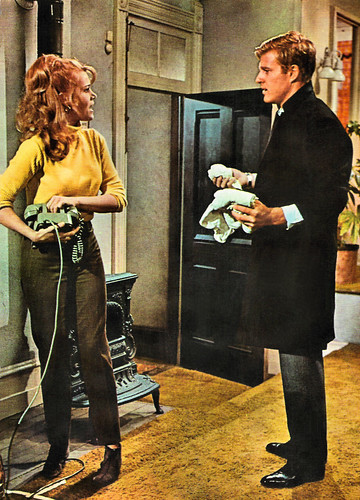
Romanian postcard by Casa Filmului Acin, no. 633. Jane Fonda and Robert Redford in Barefoot in the Park (Gene Saks, 1967).

Romanian postcard by Casa Filmului Acin, no. 151. Photo: Jane Fonda in Barbarella (Roger Vadim, 1968).
American actress Jane Fonda (1937) is a two-time Academy Award winner for the crime thriller Klute (1971) and the Vietnam drama Coming Home (1978). Roger Vadim's psychedelic Science Fiction spoof Barbarella (1968) made her one of the icons of the European cinema of the 1960s. In 2014, she received the American Film Institute AFI Life Achievement Award.

Romanian postcard by Casa Filmului Acin. Photo: Patty Duke, Sharon Tate, and Barbara Parkins in Valley of the Dolls (Mark Robson, 1967).

Romanian postcard by Casa Filmului Acin.
One month before her eighteenth birthday, American actress Jean Seberg (1938-1979) landed the title role in Otto Preminger's Saint Joan (1957) after a much-publicised contest involving some 18,000 hopefuls. A few years later, she became an icon of the Nouvelle Vague with her role in Jean Luc Godard’s A Bout de Souffle/Breathless (1960). She appeared in over 30 films in Hollywood and Europe.
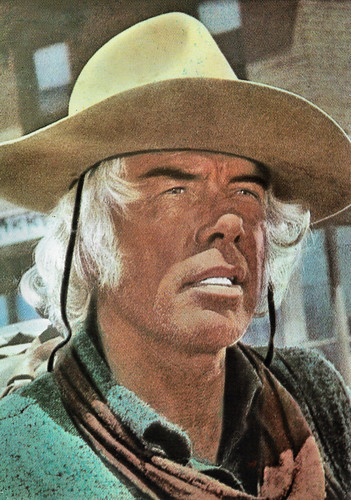
Romanian postcard by Casa Filmului Acin, no 289. Photo: Lee Marvin in Monte Walsh (William A. Fraker, 1970).
American film and television actor Lee Marvin (1924-1987) began as a supporting player of a generally vicious demeanor, then metamorphosed into a star playing tough, hard-bitten anti-heroes. Known for his gravelly smoke-burnished voice and premature white hair, Marvin initially played villains, soldiers, and other hardboiled characters. He became a major star with Cat Ballou (1965), a comedy Western in which he played dual roles. Marvin is also remembered for his 'tough guy' characters in The Killers (1964), The Professionals (1966), The Dirty Dozen (1967), Point Blank (1967), and The Big Red One (1980).
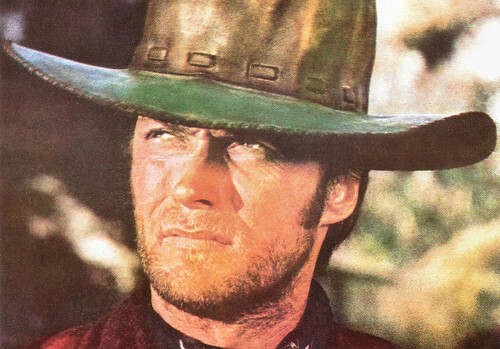
Romanian postcard by Casa Filmului Acin.
American film actor and director Clint Eastwood (1930) rose to fame as the Man with No Name in Sergio Leone's classic Spaghetti Westerns Per un pugno di dollari/A Fistful of Dollars (1964), Per qualche dollaro in più/For a Few Dollars More (1965), and Il buono, il brutto, il cattivo/The Good, the Bad and the Ugly (1966). Later in the US, he played hard edge police inspector Harry Callahan in the five Dirty Harry films, which elevated him to superstar status, and he directed and produced such award-winning masterpieces as Unforgiven (1992), Mystic River (2003), and Million Dollar Baby (2004).
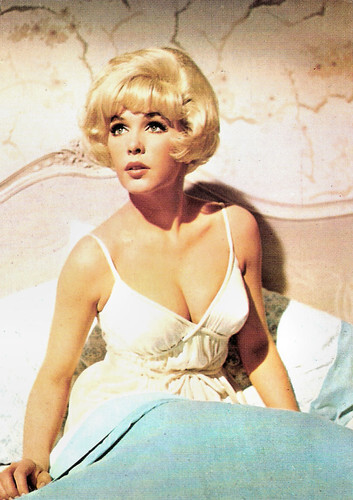
Romanian postcard by Casa Filmului Acin. Photo: Stella Stevens in How to Save a Marriage and Ruin Your Life (Fielder Cook, 1968).
American comedienne Stella Stevens (1936) starred as a voluptuous platinum blonde with a deep sultry voice in many Hollywood films of the 1960s. During the decade she was one of the most photographed women in the world.
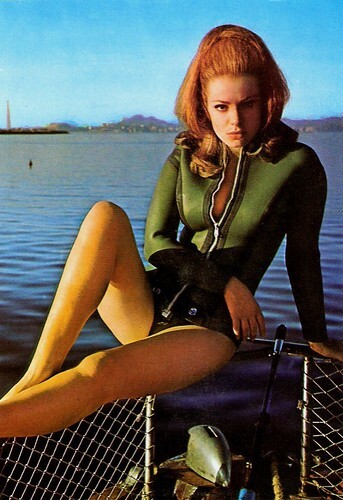
Romanian postcard by Casa Filmului Acin.
Elisabeth Wiener (1946) is a French actress, singer, songwriter, and performer, who appeared in several French and Italian films of the 1960s and 1970s.
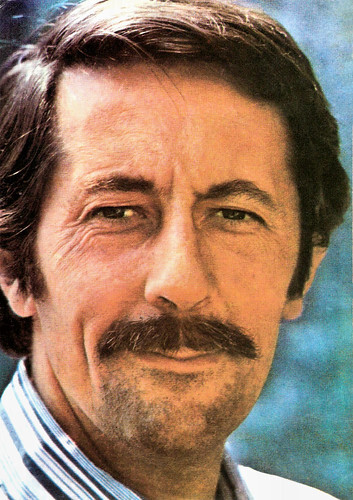
Romanian postcard by Casa Filmului Acin, no. 569.
Jean Rochefort (1930-2017) was a French actor, with a career spanning over five decades. He is best remembered for the comedy smashes Le Grand Blond avec Une Chasseure Noire/The Tall Blond Man with One Black Shoe (1972), Un éléphant ça trompe énormément/An Elephant Can Be Extremely Deceptive (1976), and Le Mari de la coiffeuse/The Hairdresser's Husband (1990).
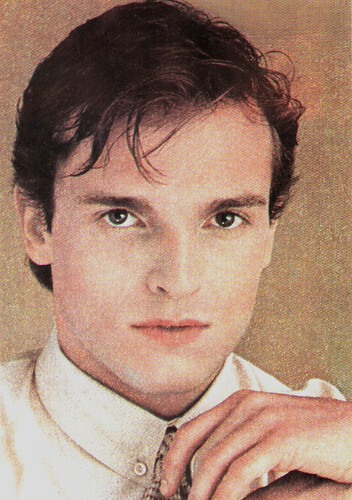
Romanian postcard by Casa Filmului Acin.
Handsome Spanish singer and actor Miguel Bosé (1956) was a major teen idol in Southern Europe between 1977 and 1982. Later he became popular in Latin America. As an actor he worked with interesting directors like Dario Argento, Pedro Almodóvar and Patrice Chereau.
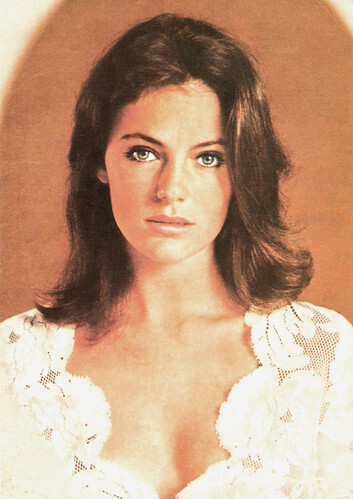
Romanian postcard by Casa Filmului Acin.
English actress Jacqueline Bisset (1944) has been an international film star since the late 1960s. She received her first roles mainly because of her stunning beauty, but over time she has become a fine actress respected by fans and critics alike. Bisset has worked with directors John Huston, François Truffaut, George Cukor and Roman Polanski. She received France’s Légion d'honneur in 2010.
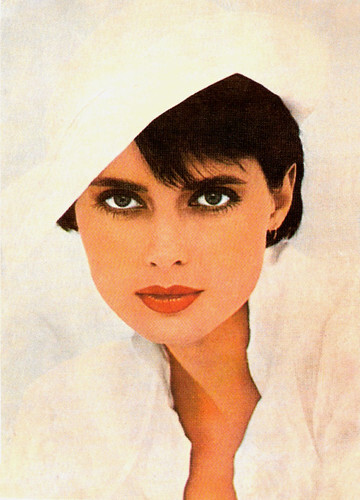
Romanian postcard by Casa Filmului Acin, C.P.C.S. Cda 43078.
Isabella Rossellini (1952) is an Italian actress, filmmaker, and model. She was born cinema royalty as the daughter of Swedish-born, three-time Oscar-winning actress Ingrid Bergman and Italian director Roberto Rossellini. She is noted for her 14-year tenure as a Lancôme model, and for her roles in films such as Blue Velvet (1986) and Death Becomes Her (1992).
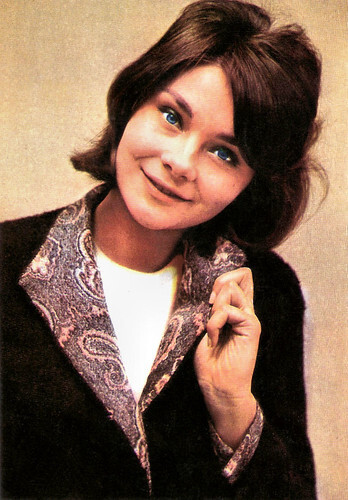
Romanian postcard by Casa Filmului Acin.
French actress and writer Macha Méril (1940) was one of the actresses of the Nouvelle Vague in the early 1960s. She appeared in 125 films by such famous directors as Jean-Luc Godard, Luis Bunuel, Rainer Werner Fassbinder, and Dario Argento.

Romanian postcard by Casa Filmului Acin. Photo: Marie-France Pisier as Charlotte Bronte, Isabelle Huppert as Anne Bronte, and Isabelle Adjani as Emily Brontë in Les soeurs Brontë/The Bronte Sisters (André Téchniné, 1979).
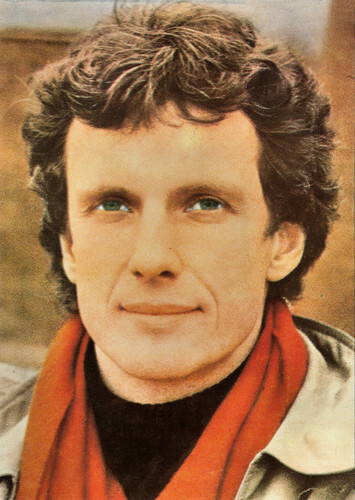
Romanian postcard by Casa Filmului Acin.
Handsome German actor Mathieu Carrière (1950) had his breakthrough at 16 in Volker Schlöndorf’s Der junge Törless/Young Törless (1966). In the 1970s and 1980s, he appeared in many French arthouse films by directors like André Delvaux and Marguerite Duras. Carrière was very convincing in challenging roles in several literary film adaptations and he also incidentally worked as a director and a writer.
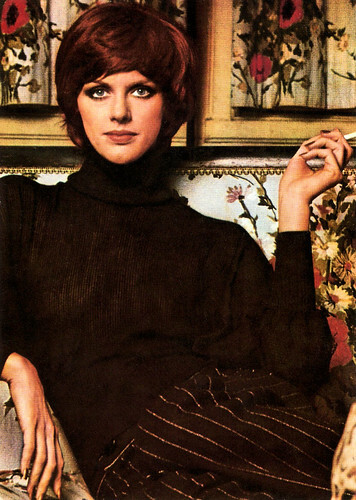
Romanian postcard by Casa Filmului Acin, no. 559.
French actress Anny Duperey (1947) is known for her stage, film, and television roles, but she is also a best-selling author. Anny Duperey is best-known for her performance in the hilarious comedy Un éléphant ça trompe énormément/Pardon Mon Affaire (1976). Duperey is a Chevalier of the Légion d'honneur.
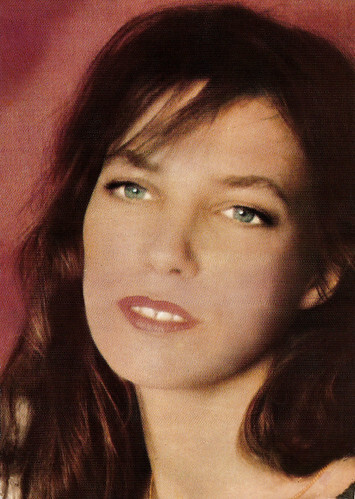
Romanian postcard by Casa Filmului Acin, no. 33102.
In the Swinging Sixties, shy, awkward-looking British actress Jane Birkin (1946) made a huge international splash as one of the nude models in Antonioni's Blow-Up (1966). In France, she became the muse of singer-songwriter Serge Gainsbourg, who wrote several of her albums, plus their explicitly erotic duet Je t'aime... moi non plus. Later she worked with such respected film directors as Jacques Rivette, Agnès Varda, and Jacques Doillon, and won several acting awards.
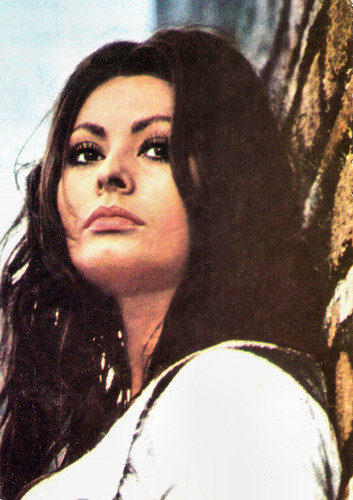
Romanian postcard by Casa Filmului Acin.
Sophia Loren (1934) rose to fame in post-war Italy as a voluptuous sex goddess. Soon after she became one of the most successful stars of the 20th Century, who won an Oscar for her mother role in La Ciociara (1960).
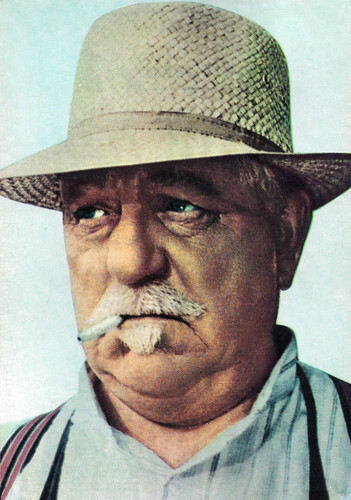
Romanian postcard by Casa Filmului Acin. Photo: Jean Gabin in Le jardinier d'Argenteuil/The Gardener of Argenteuil (Jean-Paul Le Chanois, 1966).
French actor and war hero Jean Gabin (1904-1976) was one of the great stars of European cinema. In the 1930s he became the personification of the tragic romantic hero of the poetic realist film. Whether he played a legionnaire in Gueule d'amour/Madeleine (1937), a deserter in Le Quai des brumes/Port of Shadows (1938) or the head gangster in Pépé le Moko (1937), Gabin was impeccable, bringing tragic humanity to each of his appearances which the public adored. After the war, Gabin was reborn as a tough anti-hero, set in his beliefs, feared and respected by all, the Godfather of French cinema.
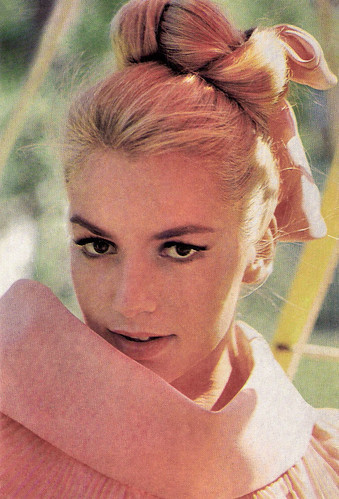
Romanian postcard by Casa Filmului Acin, no. 91.
Blonde French actress and singer Catherine Spaak (1945) worked in France, Spain, Germany, and Hollywood, but she spent most of her career in Italy. There she started as a Lolita-like vamp in films of the early 1960s, made records, and became a teenage star. She played in several classic Italian comedies and was a popular TV host. Spaak is still active on TV, writes books, and has now appeared in some 100 films.
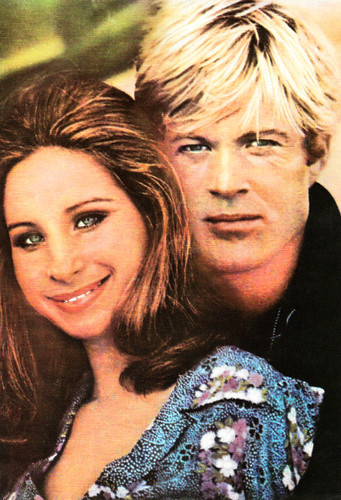
Romanian postcard by Casa Filmului Acin, no. 491. Photo: Barbra Streisand and Robert Redford in The Way We Were (Sydney Pollack, 1973).
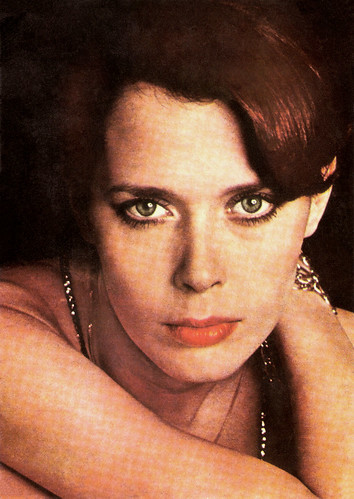
Romanian postcard by Casa Filmului Acin, no. 623.
Dutch actress Sylvia Kristel (1952-2012) will always be remembered as Emmanuelle, thanks to the massive soft-porn hit of the 1970s. Emmanuelle’s sexual adventures attracted 500 million people to the cinema.
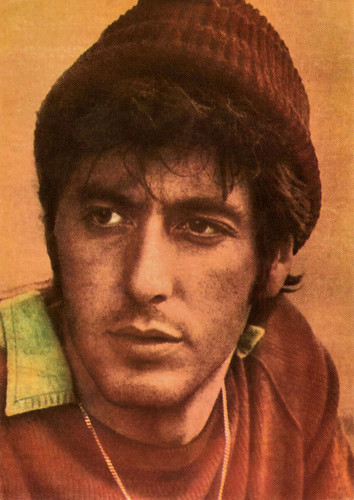
Romanian postcard by Casa Filmului Acin. Photo: Al Pacino in Scarecrow (Jerry Schatzberg, 1973).
During the 1970s, American actor Al Pacino (1940) established himself with such films as The Godfather (1972), Serpico (1973), The Godfather: Part II (1974), and Dog Day Afternoon (1975). In the following decades, he became an enduring icon of American cinema. He won the Triple Crown of Acting: an Oscar for Best Actor for Scent of a Woman (1992); a Tony for Best Supporting Actor in the play 'Does a Tiger Wear a Necktie?' (1969) and for Best Actor in the play 'The Basic Training of Pavlo Hummel' (1977); and an Emmy for Best Actor in the Miniseries Angels in America (2003).
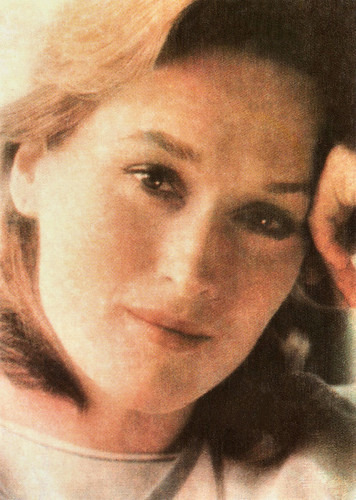
Romanian postcard by Acin in the Colectia Cinefilului.
American actress Meryl Streep (1949) is one of the best actresses of her generation, known for her versatility and accents. She has been nominated for the Oscar an astonishing 21 times and has won it three times. Among her other accolades, she has received 32 Golden Globe nominations, more than any other person, and won eight.
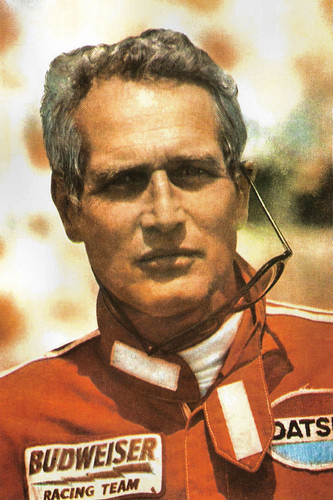
Romanian postcard by Casa Filmului Acin, no. C.P.V.S. c-sa 53066.
American film actor Paul Newman (1925-2008) was a matinee idol with the most famous blue eyes of Hollywood, who often played detached yet charismatic anti-heroes and rebels. He was nominated for nine acting Academy Awards in five different decades and won the Oscar for The Color of Money (1986). He was also a prominent social activist, a major proponent of actors' creative rights, and a noted philanthropist.

Romanian postcard by Casa Filmului Acin, no. C.P.C.S. 33 150. John Travolta in Staying Alive (Sylvester Stallone, 1983).
John Travolta (1954) is an American actor and singer, who rose to fame during the 1970s, when he appeared on the television sitcom Welcome Back, Kotter (1975-1979), and starred in the box office successes Carrie (1976), Saturday Night Fever (1977), Grease (1978) and Urban Cowboy (1980). His acting career declined throughout the 1980s, but in 1994, Travolta made one of the most stunning comebacks in entertainment history by starring in Quentin Tarantino's Pulp Fiction (1994). Since then he starred in such films as Get Shorty (1995), Face/Off (1997), Primary Colors (1998), and Hairspray (2007).
And check out our earlier post on Acin or visit Flickr where you can see more Acin postcards our Acin album or in the Casa Filmului Acin group.

Romanian postcard by Casa Filmului Acin, no. 633. Jane Fonda and Robert Redford in Barefoot in the Park (Gene Saks, 1967).

Romanian postcard by Casa Filmului Acin, no. 151. Photo: Jane Fonda in Barbarella (Roger Vadim, 1968).
American actress Jane Fonda (1937) is a two-time Academy Award winner for the crime thriller Klute (1971) and the Vietnam drama Coming Home (1978). Roger Vadim's psychedelic Science Fiction spoof Barbarella (1968) made her one of the icons of the European cinema of the 1960s. In 2014, she received the American Film Institute AFI Life Achievement Award.

Romanian postcard by Casa Filmului Acin. Photo: Patty Duke, Sharon Tate, and Barbara Parkins in Valley of the Dolls (Mark Robson, 1967).

Romanian postcard by Casa Filmului Acin.
One month before her eighteenth birthday, American actress Jean Seberg (1938-1979) landed the title role in Otto Preminger's Saint Joan (1957) after a much-publicised contest involving some 18,000 hopefuls. A few years later, she became an icon of the Nouvelle Vague with her role in Jean Luc Godard’s A Bout de Souffle/Breathless (1960). She appeared in over 30 films in Hollywood and Europe.

Romanian postcard by Casa Filmului Acin, no 289. Photo: Lee Marvin in Monte Walsh (William A. Fraker, 1970).
American film and television actor Lee Marvin (1924-1987) began as a supporting player of a generally vicious demeanor, then metamorphosed into a star playing tough, hard-bitten anti-heroes. Known for his gravelly smoke-burnished voice and premature white hair, Marvin initially played villains, soldiers, and other hardboiled characters. He became a major star with Cat Ballou (1965), a comedy Western in which he played dual roles. Marvin is also remembered for his 'tough guy' characters in The Killers (1964), The Professionals (1966), The Dirty Dozen (1967), Point Blank (1967), and The Big Red One (1980).

Romanian postcard by Casa Filmului Acin.
American film actor and director Clint Eastwood (1930) rose to fame as the Man with No Name in Sergio Leone's classic Spaghetti Westerns Per un pugno di dollari/A Fistful of Dollars (1964), Per qualche dollaro in più/For a Few Dollars More (1965), and Il buono, il brutto, il cattivo/The Good, the Bad and the Ugly (1966). Later in the US, he played hard edge police inspector Harry Callahan in the five Dirty Harry films, which elevated him to superstar status, and he directed and produced such award-winning masterpieces as Unforgiven (1992), Mystic River (2003), and Million Dollar Baby (2004).

Romanian postcard by Casa Filmului Acin. Photo: Stella Stevens in How to Save a Marriage and Ruin Your Life (Fielder Cook, 1968).
American comedienne Stella Stevens (1936) starred as a voluptuous platinum blonde with a deep sultry voice in many Hollywood films of the 1960s. During the decade she was one of the most photographed women in the world.

Romanian postcard by Casa Filmului Acin.
Elisabeth Wiener (1946) is a French actress, singer, songwriter, and performer, who appeared in several French and Italian films of the 1960s and 1970s.

Romanian postcard by Casa Filmului Acin, no. 569.
Jean Rochefort (1930-2017) was a French actor, with a career spanning over five decades. He is best remembered for the comedy smashes Le Grand Blond avec Une Chasseure Noire/The Tall Blond Man with One Black Shoe (1972), Un éléphant ça trompe énormément/An Elephant Can Be Extremely Deceptive (1976), and Le Mari de la coiffeuse/The Hairdresser's Husband (1990).

Romanian postcard by Casa Filmului Acin.
Handsome Spanish singer and actor Miguel Bosé (1956) was a major teen idol in Southern Europe between 1977 and 1982. Later he became popular in Latin America. As an actor he worked with interesting directors like Dario Argento, Pedro Almodóvar and Patrice Chereau.

Romanian postcard by Casa Filmului Acin.
English actress Jacqueline Bisset (1944) has been an international film star since the late 1960s. She received her first roles mainly because of her stunning beauty, but over time she has become a fine actress respected by fans and critics alike. Bisset has worked with directors John Huston, François Truffaut, George Cukor and Roman Polanski. She received France’s Légion d'honneur in 2010.

Romanian postcard by Casa Filmului Acin, C.P.C.S. Cda 43078.
Isabella Rossellini (1952) is an Italian actress, filmmaker, and model. She was born cinema royalty as the daughter of Swedish-born, three-time Oscar-winning actress Ingrid Bergman and Italian director Roberto Rossellini. She is noted for her 14-year tenure as a Lancôme model, and for her roles in films such as Blue Velvet (1986) and Death Becomes Her (1992).

Romanian postcard by Casa Filmului Acin.
French actress and writer Macha Méril (1940) was one of the actresses of the Nouvelle Vague in the early 1960s. She appeared in 125 films by such famous directors as Jean-Luc Godard, Luis Bunuel, Rainer Werner Fassbinder, and Dario Argento.

Romanian postcard by Casa Filmului Acin. Photo: Marie-France Pisier as Charlotte Bronte, Isabelle Huppert as Anne Bronte, and Isabelle Adjani as Emily Brontë in Les soeurs Brontë/The Bronte Sisters (André Téchniné, 1979).

Romanian postcard by Casa Filmului Acin.
Handsome German actor Mathieu Carrière (1950) had his breakthrough at 16 in Volker Schlöndorf’s Der junge Törless/Young Törless (1966). In the 1970s and 1980s, he appeared in many French arthouse films by directors like André Delvaux and Marguerite Duras. Carrière was very convincing in challenging roles in several literary film adaptations and he also incidentally worked as a director and a writer.

Romanian postcard by Casa Filmului Acin, no. 559.
French actress Anny Duperey (1947) is known for her stage, film, and television roles, but she is also a best-selling author. Anny Duperey is best-known for her performance in the hilarious comedy Un éléphant ça trompe énormément/Pardon Mon Affaire (1976). Duperey is a Chevalier of the Légion d'honneur.

Romanian postcard by Casa Filmului Acin, no. 33102.
In the Swinging Sixties, shy, awkward-looking British actress Jane Birkin (1946) made a huge international splash as one of the nude models in Antonioni's Blow-Up (1966). In France, she became the muse of singer-songwriter Serge Gainsbourg, who wrote several of her albums, plus their explicitly erotic duet Je t'aime... moi non plus. Later she worked with such respected film directors as Jacques Rivette, Agnès Varda, and Jacques Doillon, and won several acting awards.

Romanian postcard by Casa Filmului Acin.
Sophia Loren (1934) rose to fame in post-war Italy as a voluptuous sex goddess. Soon after she became one of the most successful stars of the 20th Century, who won an Oscar for her mother role in La Ciociara (1960).

Romanian postcard by Casa Filmului Acin. Photo: Jean Gabin in Le jardinier d'Argenteuil/The Gardener of Argenteuil (Jean-Paul Le Chanois, 1966).
French actor and war hero Jean Gabin (1904-1976) was one of the great stars of European cinema. In the 1930s he became the personification of the tragic romantic hero of the poetic realist film. Whether he played a legionnaire in Gueule d'amour/Madeleine (1937), a deserter in Le Quai des brumes/Port of Shadows (1938) or the head gangster in Pépé le Moko (1937), Gabin was impeccable, bringing tragic humanity to each of his appearances which the public adored. After the war, Gabin was reborn as a tough anti-hero, set in his beliefs, feared and respected by all, the Godfather of French cinema.

Romanian postcard by Casa Filmului Acin, no. 91.
Blonde French actress and singer Catherine Spaak (1945) worked in France, Spain, Germany, and Hollywood, but she spent most of her career in Italy. There she started as a Lolita-like vamp in films of the early 1960s, made records, and became a teenage star. She played in several classic Italian comedies and was a popular TV host. Spaak is still active on TV, writes books, and has now appeared in some 100 films.

Romanian postcard by Casa Filmului Acin, no. 491. Photo: Barbra Streisand and Robert Redford in The Way We Were (Sydney Pollack, 1973).

Romanian postcard by Casa Filmului Acin, no. 623.
Dutch actress Sylvia Kristel (1952-2012) will always be remembered as Emmanuelle, thanks to the massive soft-porn hit of the 1970s. Emmanuelle’s sexual adventures attracted 500 million people to the cinema.

Romanian postcard by Casa Filmului Acin. Photo: Al Pacino in Scarecrow (Jerry Schatzberg, 1973).
During the 1970s, American actor Al Pacino (1940) established himself with such films as The Godfather (1972), Serpico (1973), The Godfather: Part II (1974), and Dog Day Afternoon (1975). In the following decades, he became an enduring icon of American cinema. He won the Triple Crown of Acting: an Oscar for Best Actor for Scent of a Woman (1992); a Tony for Best Supporting Actor in the play 'Does a Tiger Wear a Necktie?' (1969) and for Best Actor in the play 'The Basic Training of Pavlo Hummel' (1977); and an Emmy for Best Actor in the Miniseries Angels in America (2003).

Romanian postcard by Acin in the Colectia Cinefilului.
American actress Meryl Streep (1949) is one of the best actresses of her generation, known for her versatility and accents. She has been nominated for the Oscar an astonishing 21 times and has won it three times. Among her other accolades, she has received 32 Golden Globe nominations, more than any other person, and won eight.

Romanian postcard by Casa Filmului Acin, no. C.P.V.S. c-sa 53066.
American film actor Paul Newman (1925-2008) was a matinee idol with the most famous blue eyes of Hollywood, who often played detached yet charismatic anti-heroes and rebels. He was nominated for nine acting Academy Awards in five different decades and won the Oscar for The Color of Money (1986). He was also a prominent social activist, a major proponent of actors' creative rights, and a noted philanthropist.

Romanian postcard by Casa Filmului Acin, no. C.P.C.S. 33 150. John Travolta in Staying Alive (Sylvester Stallone, 1983).
John Travolta (1954) is an American actor and singer, who rose to fame during the 1970s, when he appeared on the television sitcom Welcome Back, Kotter (1975-1979), and starred in the box office successes Carrie (1976), Saturday Night Fever (1977), Grease (1978) and Urban Cowboy (1980). His acting career declined throughout the 1980s, but in 1994, Travolta made one of the most stunning comebacks in entertainment history by starring in Quentin Tarantino's Pulp Fiction (1994). Since then he starred in such films as Get Shorty (1995), Face/Off (1997), Primary Colors (1998), and Hairspray (2007).
And check out our earlier post on Acin or visit Flickr where you can see more Acin postcards our Acin album or in the Casa Filmului Acin group.
Published on February 26, 2022 22:00
February 25, 2022
Actors from the Baltic States
At EFSP, we like to discover unknown territories of European cinema. For today's post, Ivo Blom made a selection of vintage postcards of film actors from the Baltic States, Latvia, Lithuania, and Estonia.
Latvia
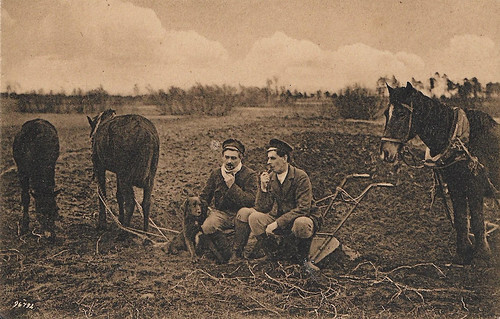
Latvian postcard by J.A.Kukurs, Riga, no. 96792. Photo: publicity still for Es karā aiziedams/As I Go Off to War (Vilis Segliņš, 1920).
Es karā aiziedams/As I Go Off to War (Vilis Segliņš, 1920) was the first national drama film of the cinema of Latvia. It premiered on 9 November 1920, which was the reason for Latvia to celebrate its first 100 years of national cinema in 2020. The film is a family drama set against the backdrop of the First World War and Latvia's freedom struggle. Director Vilis Segliņš was also the scriptwriter. The actors were Alfrēds Amtmanis-Briedītis, Ludmila Špīlberga, M. Komisārs, Aleksis Mierlauks, Berta Rūmniece, Jānis Ģērmanis, Paula Baltābola, Teodors Valdšmits, and Lilija Ērika. NB IMDb doesn't know the film, which is now considered lost.
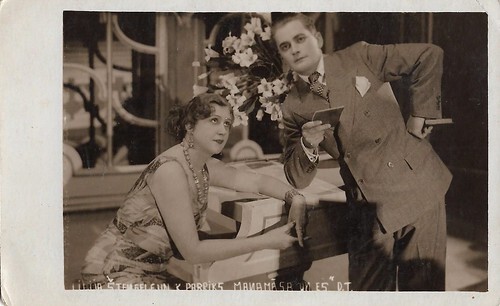
Latvian postcard. Lilija Štengele and Karlis Pabriks in the stage play 'Mana māsa un es' (My Sister and I). D.T. probably stands for the Dailes Theatre of Riga, the main repertory theatre of Latvia.
Kārlis Pabriks (1898-1977) was a Latvian actor and director who worked for many years at the Dailes Theatre. As far as known he acted in only one film, Dzimtene sauc (Aleksandrs Rusteiķis, 1935), a film IMDb does not mention. The film, based on a script by V. Lāčs and the first Latvian sound film, depicts, with a certain patriotic tone, a traditional-style wedding party of Dravnieku Velta (Milda Zīlava) and Varkaļu Jānis (Pabriks). The film doesn't have a lot of plot and the lighting was poor, but it has interesting documentation of local rites on courting and wedding.
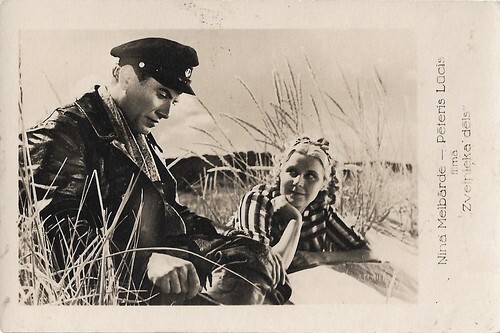
Latvian postcard. Peteris Lucis and Nina Melbarde in Zvejnieka dels/The Fisherman's Son (Villis Lapenieks, 1940).
Vilis Lapenieks’ film Zvejnieka dels/The Fisherman's Son was a national blockbuster and created such excitement that at its premiere on 2 January 1940, the public at the Splendid Palace broke down the theatre’s doors. Deemed a “relic of bourgeois Latvia”, it was hidden during the Soviet years. When independence was regained, the film was once again up on the screen and became a symbol of the youth of free Latvia.
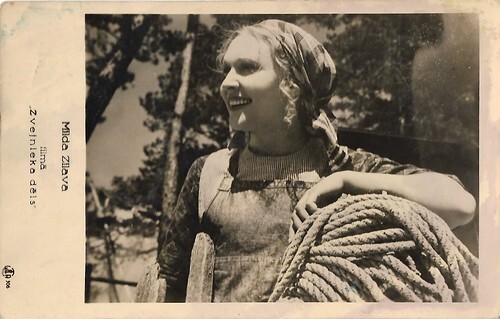
Latvian postcard by IRA, Riga, no. 306. Milda Zilava in Zvejnieka dels/ The Fisherman's Son (Villis Lapenieks, 1940).
In Zvejnieka dels/The Fisherman's Son (1940), Oskars (Peteris Lucis) lives in a typical seaside village, but wants to break free of his father’s rule and the old ways – he dreams of new, large nets, an ice-cellar, and the fishermen’s independence from the fish wholesaler. At first, no one wants to believe in Oskars’ plans, except for happy-go-lucky Fredis. With the help of Fredis, Oskars builds a new fish trap, gaining admiration from even the old fishermen. Love and deceit also play into the story, as do colorful village characters and folksy songs, which have since been absorbed into national folklore. Milda Zīlava played Zenta.
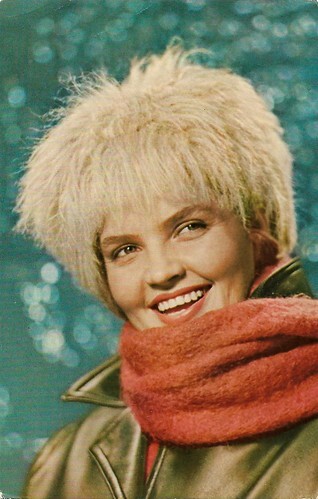
Russian postcard by Izdanie Bjuro Propagandy Sovetskogo Kinoiskusstva, Moscow, no. A14212, 1967. Photo: G. Ter-Obanecova. Dzidra Ritenberga.
Latvian actress and director Dzidra Ritenberga (1928-2003) made her film debut as an actress in 1956. She became known to an international audience a year later for the title role in Vladimir Braun's Latvian-language feature film Malva (1957) in which she appeared alongside Anatoly Ignatiev and Pavel Ussovnichenko. She played the attractive and restless wife of a provincial fisherman who turns the heads of all the men in the village and embarks on a love triangle. At the 1957 Venice Film Festival, Ritenberga was awarded the Coppa Volpi for Best Actress of the Film Festival for her role. Ritenberga became a regular film actress in Soviet cinema, in both Latvian and Russian-language productions. However, she was unable to repeat her early international success. In 1973, Ritenberga trained as a director at the Latvian Conservatory in Riga. From the mid-1970s, she directed several feature films. Her last work was Valsis mūža garumā/Waltzing Through Live (1991), which was shown at the 1991 Soviet Women and Cinema film festival in Moscow.
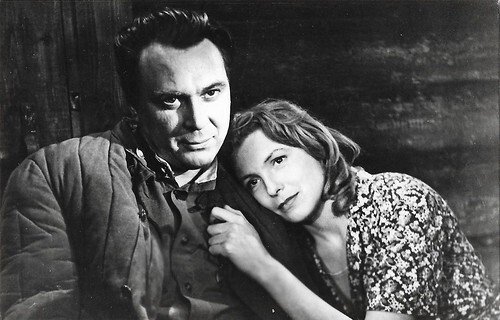
Latvian (former Soviet Union) postcard, Riga, 1982. Photo: Lenfilm. Vija Artmane and Evgeniy Matveev in Rodnaya krov/Blood Ties (Mikhail Yershov, 1964).
Alida 'Vija' Artmane (1929-2008) was a popular Latvian stage and screen actress, who had her film breakthrough with Rodnaya krov/Blood Ties (1964) and was henceforth called "Mother Latvia". Rodnaya krov/Blood Ties deals with a soldier on leave (Matveev) who stops to help a woman (Artmane) run a ferry and bring up her three children while her husband is away at war.
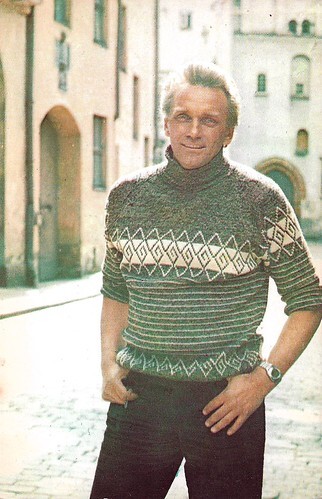
Russian postcard by Bjuro Propagandy Sovetskogo Kinoiskusstva, Moscow, no. A-319, 1979. Photo: I. Gievasheva. Gunārs Cilinskis
Latvian actor Gunārs Cilinskis (1931-1992) had a rich career in mainly Russian and Latvian cinema, both as actor and director. His film debut took place in 1958, at Riga Film Studio, where he starred opposite Vija Artmane in Chuzhaya v posyolke/Stranger in the Village (Ada Neretniece, 1959). Memorable are also Mērnieku laiki/The Times of the Surveyors (Voldemārs Pūce, 1968), Nāves ēnā (Rūdolfs Blaumanis, 1971), the Russian-Hungarian Derzhis za oblaka/Hold on to the Cloud (Péter Szász, Boris Grigoriev, 1971), Ceplis (Rolands Kalniņš, 1972), and Teātris (Jānis Streičs, 1978) starring Vija Artmane. In all of these films, Cilinskis had the male lead or was the male antagonist. From 1976 he also was a film director at the Riga Film Studio, debuting with Ezera Sonate/Lake Sonata (1977) with Vari Brasla.
Lithuania
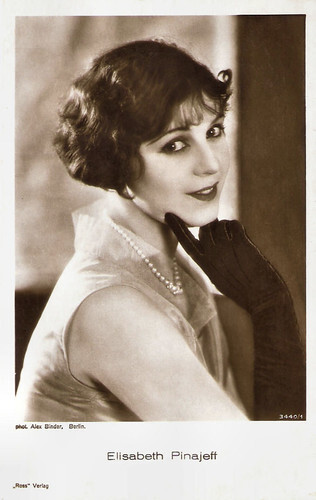
German postcard by Ross Verlag, no. 3440/1, 1928-1929. Photo: Alex Binder, Berlin. Elisabeth Pinajeff .
Elisabeth Pinajeff (1900-1995) was a Russian-Lithuanian actress who starred in German and French cinema in the 1920s and 1930s. In the 1950s she was also involved in the notorious scandal of the Ballets roses. She supposedly played in two silent Russian films, but it is unknown which films. At age 19, she married an engineer. When her husband got a job in Germany, she moved there with him.
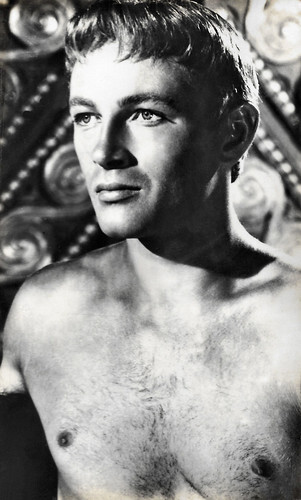
Spanish postcard by Marte. Sent by mail in 1957. Photo: Jacques Sernas in Helen of Troy (Robert Wise, 1956).
Lithuanian-born French actor Jacques (sometimes: Jack) Sernas (1925-2015) had an international film career of more than sixty years. Sernas was the son of the Baltic minister of justice, Jokūbas Šernas, a signatory of the Act of Independence of Lithuania in 1918. He died six years later when Jacques was a year old. His Russian mother took him to Paris where he received his formal education. The handsome blonde appeared as the hero of Peplum spectacles and adventure films and later, he worked as a character actor. Sernas is perhaps best-known as Paris in the Hollywood epic Helen of Troy (Robert Wise, 1956).
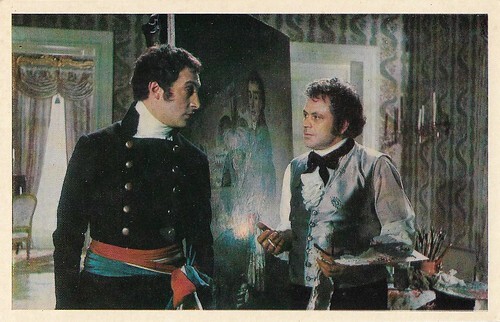
Soviet postcard by Izdanie Bjuro Propagandy Sovetskogo Kinoiskusstva, no. 3, 107/72, 1972. Photo: Arkadi Zager. Donatas Banionis at right as Don Francisco de Goya y Lucientes and Mikhail Kozakov as Ambassador in Goya – oder der arge Weg der Erkenntnis/Goya or the Hard Way to Enlightenment (Konrad Wolf, 1971). The postcard was issued in 150,000 copies. Retail price: 8 Kop.
Lithuanian and Soviet actor Donatas Banionis (1924-2014) is best known in the West for his performance in the lead role of Andrei Tarkovsky's classic Science Fiction film Solaris (1972) as Kris Kelvin. In 1959, Banionis started to act in films. He made his film debut in the Lithuanian film Adomas nori buti zmogumi/Adam Wants To Be A Human (Vytautas Zalakevicius, 1959). His performance of the farmer Vaitkus in Niekas nenorėjo mirti/Nobody Wanted to Die (Vytautas Žalakevičius, 1965) won him the award for best actor at the Karlovy Vary film festival. Soon he was a highly requested actor, with many parts in prestigious national and international productions.
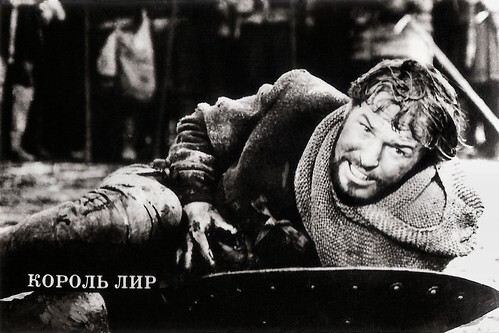
Soviet collectors card. Photo: Regimantas Adomaitis in Korol Lir/King Lear (Grigori Kozintsev, Iosif Shapiro, 1971).
Lithuanian film and stage actor Regimantas Adomaitis (1937) made his film debut in Vienos dienos kronika/The Chronicle of one Day (Vytautas Zalakevicius, 1963) with Donatas Banionis . In 1966 he had his breakthrough with Niekas nenorėjo mirti/Nobody Wanted to Die (Vytautas Žalakevičius,1966). This action drama is set in a small Lithuanian farming community after the Second World War. The village is divided as the communists battle those in favor of national independence. When the leader of the community is killed, the man's four sons, including Adomaitis, set out to avenge his death. Adomaitis, director Žalakevičius, and cinematographer Jonas Gricius were awarded the USSR State Prize for the film in 1967. That year, he also acted in the a-typical Soviet war film Vostochny koridor/Eastern Corridor (Valentin Vinogradov, 1966). He appeared as Edmund in the Shakespeare adaptation Korol Lir/King Lear (Grigori Kozintsev, Iosif Shapiro, 1971), for which Dmitri Shostakovich composed the score. Years later, he co-starred with Donatas Banionis in the Soviet Lithuanian-language war film Gruppa krovi nol/Faktas/Facts (Almantas Grikevicius, 1981). In 1988 he with other 34 prominent people created Sąjūdis Reform Movement, which eventually led to the declaration of independence of Lithuania on 11 March 1990. His most recent film is the Norwegian drama Iskyss/The Ice Kiss (Knut Erik Jensen, 2008).
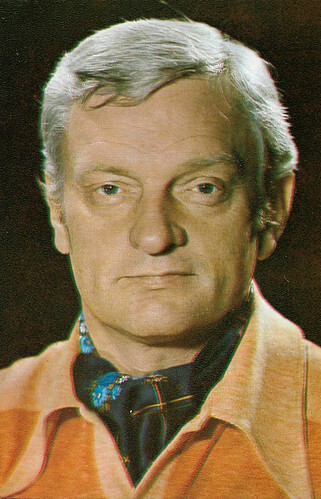
Russian postcard by Bjuro Propagandy Sovetskogo Kinoiskusstva, Moscow, no. A319, 1980. Photo: G. Ter-Ovanekova. Algimantas Masiulis.
Lithuanian film and theatre actor Algimantas Masiulis (1931-2008) made his film debut in 1957 in the episodic role of an officer in the film Ignotas grįžo namo (Aleksandr Razoumny, 1957). In 1966, Masiulis became a real celebrity after the release of the film Niekas nenorėjo mirti/Nobody Wanted to Die) (Vytautas Žalakevičius, 1966). He also acted as Squire Relawney opposite Boris Andreyev as Long John Silver in Ostrov sokrovishch/Treasure Island (Yevgeni Fridman, 1972), and as Prince John in Ballada o doblestnom rytsare Ayvengo/Ivanhoe (Sergey Tarasov, 1983). Masiulis' career included about 160 stage roles and about 100 screen parts.
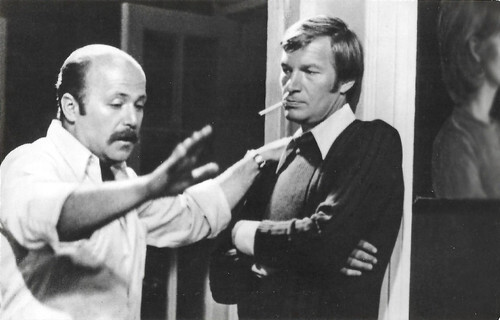
Russian postcard by Bjuro Propagandy Sovetskogo Kinoiskusstva, Riga, 1977. Juozas Budraitis and Aleksandr Kalyagin in Podranki/Wounded Game (Nikolai Gubenko, 1977).
Soviet and Lithuanian theatre and film actor Juozas Budraitis (1940) became a People's Artist of the Lithuanian Soviet Socialist Republic in 1982. His film career began in 1961 when he played in an episode of the film Kai susilieja upes/When the Rivers Merge (Balys Bratkauskas, Boris Schreiber, 1961). As a third-year student at the university, the director Vitautas Prano Jalakiavitchous invited him to play the role of Jonas in the famous Lithuanian film Niekas nenorėjo mirti/Nobody Wanted to Die (Vytautas Žalakevičius, 1965), which Donatas Banionis starred in. This film marked the beginning of Juozas' fame, and he acted in many international films, including Sluzhili dva tovarishcha/Two Comrades Were Serving (Yevgeni Karelov, 1968), Korol Lir/King Lear (Grigoriy Kozintsev, Iosif Shapiro, 1970), Blokada: Luzhskiy rubezh, Pulkovskiy meredian/Blockade (Mikhail Yershov, 1974), and Podranki/Wounded Game (Nikolai Gubenko, 1977), which was entered into the 1977 Cannes Film Festival.
Estonia
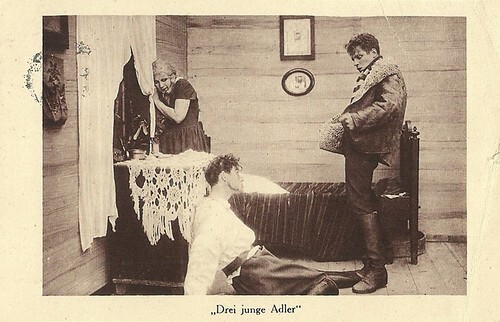
German postcard. Photo: Juhan Nõmmik and Elly Põder-Roht in Noored kotkad/The Young Eagles (Theodor Luts, 1927), released in Germany as Drei junge Adler (Three Young Eagles). Juhan Nõmmik as the blacksmith Laansoo, defending his sister Hilja (Elly Põder-Roht).
Noored kotkad/The Young Eagles is situated shortly after the end of World War I: the young republic Estonia has proclaimed its independence from Soviet Russia. Now it is put to the test and must assert its independence militarily in the Estonian War of Independence (1918-1920) against the old rulers. This rare Estonian silent war film was shot for the production company Siirius Film in the summer of 1927 in Tartu. The film was directed by Theodor Luts, one of the most renowned Estonian directors of the interwar period. He had himself fought in the Estonian War of Independence, including the battles of Paju and Cēsis. The film studio stood in the courtyard of Luts' house at Aia tänav 19, while location shooting was done in Tartumaa, near Mustvee, in Värska, and in Petserimaa. The original length of the film was about one hundred minutes. Noored kotkad was Luts' first feature film - and after the tragicomedy Kevade unelm by Voldemar Päts, the first real feature film from Estonia ever. Noored kotkad was very positively received among the Estonian population. The film was also exported abroad and was shown in Paris as Les Aiglons, in Warsaw, and probably in Berlin as Drei junge Adler, in 1928. In 2008, Noored kotkad was restored and digitised with a total length of 87 minutes.

Russian postcard. Photo: Mosfilm. Lembit Ulfsak in Legenda o Tile/The Legend of Till Ullenspiegel (Aleksandr Alov, Vladimir Naumov, 1977), an adaptation of the classic Belgian novel by Charles de Coster.
Estonian actor Lembit Ulfsak (1947-2017) had a rich career in Soviet and Russian cinema and TV. From 1969 he acted in film while from 1985 to 1994 he was an actor in Tallinnfilm Studios. In 1976, Lembit Ulfsak had a major breakthrough as the mischievous Till Ulenspiegel in the film Legenda o Tile/The Legend of Till Ullenspiegel (1977). He was also known for the Estonian films Keskea rõõmud/The joys of Keskea (Lembit Ulfsak, 1987), Doktor Stockmann/An Enemy of the People (Mikk Mikiver, 1989), and Mandariinid/Tangerines (Zaza Urushadze, 2013), which was nominated for the Oscar for Best Foreign Film.
Cinema Splendid Palace and Film Museum of Riga
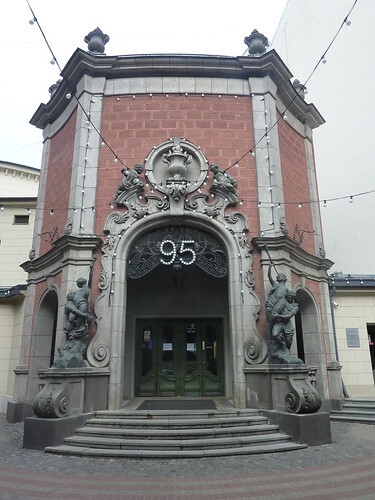
Splendid Palace, Elizabetes iela 61, Riga, LV-1050, Latvia.
With its neo-baroque facade and neo-Rococo style interior, Cinema Splendid Palace in Riga is a national architectural monument. Splendid Palace is a place where you can see Latvian film premieres, national and international film festivals, performances, concerts, and enjoy opera and ballet live transmissions from the world-famous opera houses and festivals. Splendid Palace has two screening halls with 749 seats altogether. The founders of Splendid Palace were Vasilijs Jemeljanovs and Leonids Falsteins. It was the first free-standing building in Riga intended exclusively for film screening with a hall for 824 viewers. The building was designed by architect Fridrihs Karlis Skujins (1880–1957). The grand opening of the cinema took place on 30 December 1923 with the American film Under Two Flags (Tod Browning, 1922). Since the 1930s Splendid Palace has been the main venue of Latvian film premieres.
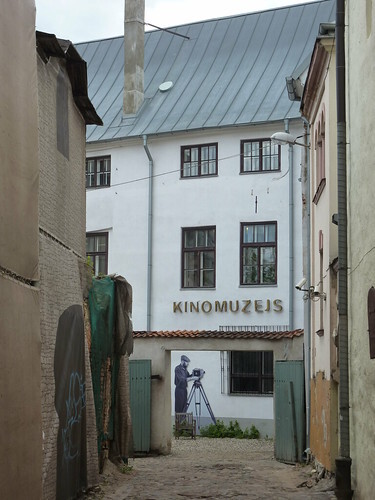
Kino Muzejs, Peitavas iela 10, Rīga LV 1050, Latvia.
We were charmed by this little film museum when we visited Riga in 2019. A hidden gem.
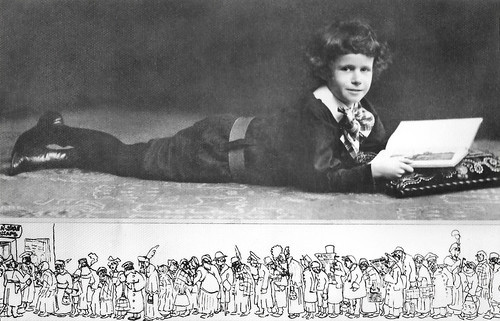
Soviet postcard by Izdatelʹstvo 'Planeta' Fabrika Fotopečati, Moscow, no. 32, 1978. This postcard was printed in an edition of 25.000 cards. The price was 8 kop. Captions: S. M. Eisenstein in Riga, 1910. Drawing of a queue, 1916.
Famous Soviet film director and film theorist Sergei Mikhailovich Eisenstein (1898-1948) was born in Riga, Latvia (then part of the Russian Empire in the Governorate of Livonia). He was the son of the famous architect Mikhail Osipovich Eisenstein. Sergei became a pioneer in the theory and practice of montage. He is noted in particular for his silent films Stachka/Strike (1925), Bronenosets Potyomkin/Battleship Potemkin (1925), and Oktyabr': Desyat' dney kotorye potryasli mir/October: Ten Days That Shook the World (1928), as well as the historical epics Alexander Nevsky (1938) and Ivan Grozniy/Ivan the Terrible (1944, 1958).
Sources: Inga Perkone (100 years of Latvian cinema), (IMDb), Time Note (Latvian), Wikipedia, and .
Latvia

Latvian postcard by J.A.Kukurs, Riga, no. 96792. Photo: publicity still for Es karā aiziedams/As I Go Off to War (Vilis Segliņš, 1920).
Es karā aiziedams/As I Go Off to War (Vilis Segliņš, 1920) was the first national drama film of the cinema of Latvia. It premiered on 9 November 1920, which was the reason for Latvia to celebrate its first 100 years of national cinema in 2020. The film is a family drama set against the backdrop of the First World War and Latvia's freedom struggle. Director Vilis Segliņš was also the scriptwriter. The actors were Alfrēds Amtmanis-Briedītis, Ludmila Špīlberga, M. Komisārs, Aleksis Mierlauks, Berta Rūmniece, Jānis Ģērmanis, Paula Baltābola, Teodors Valdšmits, and Lilija Ērika. NB IMDb doesn't know the film, which is now considered lost.

Latvian postcard. Lilija Štengele and Karlis Pabriks in the stage play 'Mana māsa un es' (My Sister and I). D.T. probably stands for the Dailes Theatre of Riga, the main repertory theatre of Latvia.
Kārlis Pabriks (1898-1977) was a Latvian actor and director who worked for many years at the Dailes Theatre. As far as known he acted in only one film, Dzimtene sauc (Aleksandrs Rusteiķis, 1935), a film IMDb does not mention. The film, based on a script by V. Lāčs and the first Latvian sound film, depicts, with a certain patriotic tone, a traditional-style wedding party of Dravnieku Velta (Milda Zīlava) and Varkaļu Jānis (Pabriks). The film doesn't have a lot of plot and the lighting was poor, but it has interesting documentation of local rites on courting and wedding.

Latvian postcard. Peteris Lucis and Nina Melbarde in Zvejnieka dels/The Fisherman's Son (Villis Lapenieks, 1940).
Vilis Lapenieks’ film Zvejnieka dels/The Fisherman's Son was a national blockbuster and created such excitement that at its premiere on 2 January 1940, the public at the Splendid Palace broke down the theatre’s doors. Deemed a “relic of bourgeois Latvia”, it was hidden during the Soviet years. When independence was regained, the film was once again up on the screen and became a symbol of the youth of free Latvia.

Latvian postcard by IRA, Riga, no. 306. Milda Zilava in Zvejnieka dels/ The Fisherman's Son (Villis Lapenieks, 1940).
In Zvejnieka dels/The Fisherman's Son (1940), Oskars (Peteris Lucis) lives in a typical seaside village, but wants to break free of his father’s rule and the old ways – he dreams of new, large nets, an ice-cellar, and the fishermen’s independence from the fish wholesaler. At first, no one wants to believe in Oskars’ plans, except for happy-go-lucky Fredis. With the help of Fredis, Oskars builds a new fish trap, gaining admiration from even the old fishermen. Love and deceit also play into the story, as do colorful village characters and folksy songs, which have since been absorbed into national folklore. Milda Zīlava played Zenta.

Russian postcard by Izdanie Bjuro Propagandy Sovetskogo Kinoiskusstva, Moscow, no. A14212, 1967. Photo: G. Ter-Obanecova. Dzidra Ritenberga.
Latvian actress and director Dzidra Ritenberga (1928-2003) made her film debut as an actress in 1956. She became known to an international audience a year later for the title role in Vladimir Braun's Latvian-language feature film Malva (1957) in which she appeared alongside Anatoly Ignatiev and Pavel Ussovnichenko. She played the attractive and restless wife of a provincial fisherman who turns the heads of all the men in the village and embarks on a love triangle. At the 1957 Venice Film Festival, Ritenberga was awarded the Coppa Volpi for Best Actress of the Film Festival for her role. Ritenberga became a regular film actress in Soviet cinema, in both Latvian and Russian-language productions. However, she was unable to repeat her early international success. In 1973, Ritenberga trained as a director at the Latvian Conservatory in Riga. From the mid-1970s, she directed several feature films. Her last work was Valsis mūža garumā/Waltzing Through Live (1991), which was shown at the 1991 Soviet Women and Cinema film festival in Moscow.

Latvian (former Soviet Union) postcard, Riga, 1982. Photo: Lenfilm. Vija Artmane and Evgeniy Matveev in Rodnaya krov/Blood Ties (Mikhail Yershov, 1964).
Alida 'Vija' Artmane (1929-2008) was a popular Latvian stage and screen actress, who had her film breakthrough with Rodnaya krov/Blood Ties (1964) and was henceforth called "Mother Latvia". Rodnaya krov/Blood Ties deals with a soldier on leave (Matveev) who stops to help a woman (Artmane) run a ferry and bring up her three children while her husband is away at war.

Russian postcard by Bjuro Propagandy Sovetskogo Kinoiskusstva, Moscow, no. A-319, 1979. Photo: I. Gievasheva. Gunārs Cilinskis
Latvian actor Gunārs Cilinskis (1931-1992) had a rich career in mainly Russian and Latvian cinema, both as actor and director. His film debut took place in 1958, at Riga Film Studio, where he starred opposite Vija Artmane in Chuzhaya v posyolke/Stranger in the Village (Ada Neretniece, 1959). Memorable are also Mērnieku laiki/The Times of the Surveyors (Voldemārs Pūce, 1968), Nāves ēnā (Rūdolfs Blaumanis, 1971), the Russian-Hungarian Derzhis za oblaka/Hold on to the Cloud (Péter Szász, Boris Grigoriev, 1971), Ceplis (Rolands Kalniņš, 1972), and Teātris (Jānis Streičs, 1978) starring Vija Artmane. In all of these films, Cilinskis had the male lead or was the male antagonist. From 1976 he also was a film director at the Riga Film Studio, debuting with Ezera Sonate/Lake Sonata (1977) with Vari Brasla.
Lithuania

German postcard by Ross Verlag, no. 3440/1, 1928-1929. Photo: Alex Binder, Berlin. Elisabeth Pinajeff .
Elisabeth Pinajeff (1900-1995) was a Russian-Lithuanian actress who starred in German and French cinema in the 1920s and 1930s. In the 1950s she was also involved in the notorious scandal of the Ballets roses. She supposedly played in two silent Russian films, but it is unknown which films. At age 19, she married an engineer. When her husband got a job in Germany, she moved there with him.

Spanish postcard by Marte. Sent by mail in 1957. Photo: Jacques Sernas in Helen of Troy (Robert Wise, 1956).
Lithuanian-born French actor Jacques (sometimes: Jack) Sernas (1925-2015) had an international film career of more than sixty years. Sernas was the son of the Baltic minister of justice, Jokūbas Šernas, a signatory of the Act of Independence of Lithuania in 1918. He died six years later when Jacques was a year old. His Russian mother took him to Paris where he received his formal education. The handsome blonde appeared as the hero of Peplum spectacles and adventure films and later, he worked as a character actor. Sernas is perhaps best-known as Paris in the Hollywood epic Helen of Troy (Robert Wise, 1956).

Soviet postcard by Izdanie Bjuro Propagandy Sovetskogo Kinoiskusstva, no. 3, 107/72, 1972. Photo: Arkadi Zager. Donatas Banionis at right as Don Francisco de Goya y Lucientes and Mikhail Kozakov as Ambassador in Goya – oder der arge Weg der Erkenntnis/Goya or the Hard Way to Enlightenment (Konrad Wolf, 1971). The postcard was issued in 150,000 copies. Retail price: 8 Kop.
Lithuanian and Soviet actor Donatas Banionis (1924-2014) is best known in the West for his performance in the lead role of Andrei Tarkovsky's classic Science Fiction film Solaris (1972) as Kris Kelvin. In 1959, Banionis started to act in films. He made his film debut in the Lithuanian film Adomas nori buti zmogumi/Adam Wants To Be A Human (Vytautas Zalakevicius, 1959). His performance of the farmer Vaitkus in Niekas nenorėjo mirti/Nobody Wanted to Die (Vytautas Žalakevičius, 1965) won him the award for best actor at the Karlovy Vary film festival. Soon he was a highly requested actor, with many parts in prestigious national and international productions.

Soviet collectors card. Photo: Regimantas Adomaitis in Korol Lir/King Lear (Grigori Kozintsev, Iosif Shapiro, 1971).
Lithuanian film and stage actor Regimantas Adomaitis (1937) made his film debut in Vienos dienos kronika/The Chronicle of one Day (Vytautas Zalakevicius, 1963) with Donatas Banionis . In 1966 he had his breakthrough with Niekas nenorėjo mirti/Nobody Wanted to Die (Vytautas Žalakevičius,1966). This action drama is set in a small Lithuanian farming community after the Second World War. The village is divided as the communists battle those in favor of national independence. When the leader of the community is killed, the man's four sons, including Adomaitis, set out to avenge his death. Adomaitis, director Žalakevičius, and cinematographer Jonas Gricius were awarded the USSR State Prize for the film in 1967. That year, he also acted in the a-typical Soviet war film Vostochny koridor/Eastern Corridor (Valentin Vinogradov, 1966). He appeared as Edmund in the Shakespeare adaptation Korol Lir/King Lear (Grigori Kozintsev, Iosif Shapiro, 1971), for which Dmitri Shostakovich composed the score. Years later, he co-starred with Donatas Banionis in the Soviet Lithuanian-language war film Gruppa krovi nol/Faktas/Facts (Almantas Grikevicius, 1981). In 1988 he with other 34 prominent people created Sąjūdis Reform Movement, which eventually led to the declaration of independence of Lithuania on 11 March 1990. His most recent film is the Norwegian drama Iskyss/The Ice Kiss (Knut Erik Jensen, 2008).

Russian postcard by Bjuro Propagandy Sovetskogo Kinoiskusstva, Moscow, no. A319, 1980. Photo: G. Ter-Ovanekova. Algimantas Masiulis.
Lithuanian film and theatre actor Algimantas Masiulis (1931-2008) made his film debut in 1957 in the episodic role of an officer in the film Ignotas grįžo namo (Aleksandr Razoumny, 1957). In 1966, Masiulis became a real celebrity after the release of the film Niekas nenorėjo mirti/Nobody Wanted to Die) (Vytautas Žalakevičius, 1966). He also acted as Squire Relawney opposite Boris Andreyev as Long John Silver in Ostrov sokrovishch/Treasure Island (Yevgeni Fridman, 1972), and as Prince John in Ballada o doblestnom rytsare Ayvengo/Ivanhoe (Sergey Tarasov, 1983). Masiulis' career included about 160 stage roles and about 100 screen parts.

Russian postcard by Bjuro Propagandy Sovetskogo Kinoiskusstva, Riga, 1977. Juozas Budraitis and Aleksandr Kalyagin in Podranki/Wounded Game (Nikolai Gubenko, 1977).
Soviet and Lithuanian theatre and film actor Juozas Budraitis (1940) became a People's Artist of the Lithuanian Soviet Socialist Republic in 1982. His film career began in 1961 when he played in an episode of the film Kai susilieja upes/When the Rivers Merge (Balys Bratkauskas, Boris Schreiber, 1961). As a third-year student at the university, the director Vitautas Prano Jalakiavitchous invited him to play the role of Jonas in the famous Lithuanian film Niekas nenorėjo mirti/Nobody Wanted to Die (Vytautas Žalakevičius, 1965), which Donatas Banionis starred in. This film marked the beginning of Juozas' fame, and he acted in many international films, including Sluzhili dva tovarishcha/Two Comrades Were Serving (Yevgeni Karelov, 1968), Korol Lir/King Lear (Grigoriy Kozintsev, Iosif Shapiro, 1970), Blokada: Luzhskiy rubezh, Pulkovskiy meredian/Blockade (Mikhail Yershov, 1974), and Podranki/Wounded Game (Nikolai Gubenko, 1977), which was entered into the 1977 Cannes Film Festival.
Estonia

German postcard. Photo: Juhan Nõmmik and Elly Põder-Roht in Noored kotkad/The Young Eagles (Theodor Luts, 1927), released in Germany as Drei junge Adler (Three Young Eagles). Juhan Nõmmik as the blacksmith Laansoo, defending his sister Hilja (Elly Põder-Roht).
Noored kotkad/The Young Eagles is situated shortly after the end of World War I: the young republic Estonia has proclaimed its independence from Soviet Russia. Now it is put to the test and must assert its independence militarily in the Estonian War of Independence (1918-1920) against the old rulers. This rare Estonian silent war film was shot for the production company Siirius Film in the summer of 1927 in Tartu. The film was directed by Theodor Luts, one of the most renowned Estonian directors of the interwar period. He had himself fought in the Estonian War of Independence, including the battles of Paju and Cēsis. The film studio stood in the courtyard of Luts' house at Aia tänav 19, while location shooting was done in Tartumaa, near Mustvee, in Värska, and in Petserimaa. The original length of the film was about one hundred minutes. Noored kotkad was Luts' first feature film - and after the tragicomedy Kevade unelm by Voldemar Päts, the first real feature film from Estonia ever. Noored kotkad was very positively received among the Estonian population. The film was also exported abroad and was shown in Paris as Les Aiglons, in Warsaw, and probably in Berlin as Drei junge Adler, in 1928. In 2008, Noored kotkad was restored and digitised with a total length of 87 minutes.

Russian postcard. Photo: Mosfilm. Lembit Ulfsak in Legenda o Tile/The Legend of Till Ullenspiegel (Aleksandr Alov, Vladimir Naumov, 1977), an adaptation of the classic Belgian novel by Charles de Coster.
Estonian actor Lembit Ulfsak (1947-2017) had a rich career in Soviet and Russian cinema and TV. From 1969 he acted in film while from 1985 to 1994 he was an actor in Tallinnfilm Studios. In 1976, Lembit Ulfsak had a major breakthrough as the mischievous Till Ulenspiegel in the film Legenda o Tile/The Legend of Till Ullenspiegel (1977). He was also known for the Estonian films Keskea rõõmud/The joys of Keskea (Lembit Ulfsak, 1987), Doktor Stockmann/An Enemy of the People (Mikk Mikiver, 1989), and Mandariinid/Tangerines (Zaza Urushadze, 2013), which was nominated for the Oscar for Best Foreign Film.
Cinema Splendid Palace and Film Museum of Riga

Splendid Palace, Elizabetes iela 61, Riga, LV-1050, Latvia.
With its neo-baroque facade and neo-Rococo style interior, Cinema Splendid Palace in Riga is a national architectural monument. Splendid Palace is a place where you can see Latvian film premieres, national and international film festivals, performances, concerts, and enjoy opera and ballet live transmissions from the world-famous opera houses and festivals. Splendid Palace has two screening halls with 749 seats altogether. The founders of Splendid Palace were Vasilijs Jemeljanovs and Leonids Falsteins. It was the first free-standing building in Riga intended exclusively for film screening with a hall for 824 viewers. The building was designed by architect Fridrihs Karlis Skujins (1880–1957). The grand opening of the cinema took place on 30 December 1923 with the American film Under Two Flags (Tod Browning, 1922). Since the 1930s Splendid Palace has been the main venue of Latvian film premieres.

Kino Muzejs, Peitavas iela 10, Rīga LV 1050, Latvia.
We were charmed by this little film museum when we visited Riga in 2019. A hidden gem.

Soviet postcard by Izdatelʹstvo 'Planeta' Fabrika Fotopečati, Moscow, no. 32, 1978. This postcard was printed in an edition of 25.000 cards. The price was 8 kop. Captions: S. M. Eisenstein in Riga, 1910. Drawing of a queue, 1916.
Famous Soviet film director and film theorist Sergei Mikhailovich Eisenstein (1898-1948) was born in Riga, Latvia (then part of the Russian Empire in the Governorate of Livonia). He was the son of the famous architect Mikhail Osipovich Eisenstein. Sergei became a pioneer in the theory and practice of montage. He is noted in particular for his silent films Stachka/Strike (1925), Bronenosets Potyomkin/Battleship Potemkin (1925), and Oktyabr': Desyat' dney kotorye potryasli mir/October: Ten Days That Shook the World (1928), as well as the historical epics Alexander Nevsky (1938) and Ivan Grozniy/Ivan the Terrible (1944, 1958).
Sources: Inga Perkone (100 years of Latvian cinema), (IMDb), Time Note (Latvian), Wikipedia, and .
Published on February 25, 2022 22:00
February 24, 2022
Marie Prevost
Beautiful Marie Prevost (1898-1937) was a Canadian-born, American silent screen actress. She started at Mack Sennett as one of his bathing beauties, but soon Irving Thalberg invited her to move to Universal but she had her breakthrough at Warner in such sophisticated films as The Beautiful and the Damned (1922) and Lubitsch's The Marriage Circle (1924). After Howard Hughes's film The Racket (1928), her career and life quickly deteriorated. During her 20-year career, she made 121 silent and sound films.
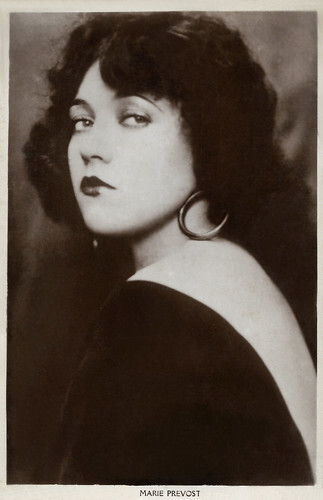
British postcard in the Picturegoer Series, London, no. 100.
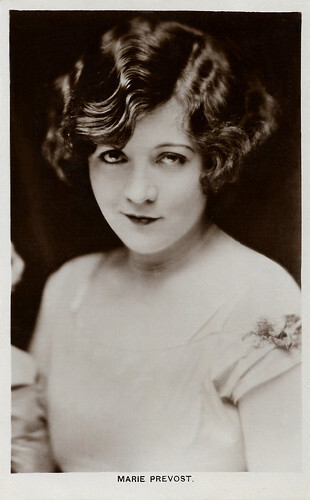
British postcard in the Picturegoer Series, London, no. 100a.
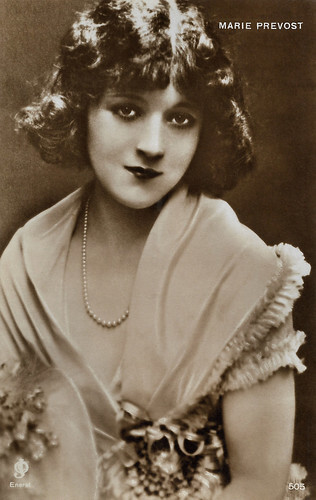
Swedish postcard by Eneret B.C. & A.H., no. 505.
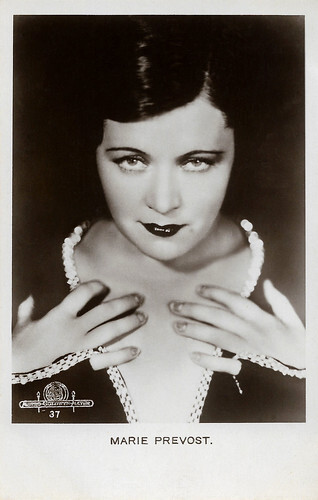
Belgian postcard by P.I.A. Belga phot, Bruxelles, no. 37. Photo: Metro-Goldwyn-Mayer.
A French bathing beauty born in Canada
Marie Prevost was born in 1896 in Sarnia, Ontario, Canada, as Mary Bickford Dunn, the daughter of Hughina Marion née Bickford (or McDonald the sources are not sure) and Arthur 'Teddy' Dunn, a railroad conductor. In 1897, when she was an infant, Teddy Dunn was killed when gas seeped into the St. Clair Tunnel. Hughina later married Frank Prevost and the family moved to the U.S. First, the Dunn family settled in Denver, Colorado, then in Los Angeles.
While living in Los Angeles, Prevost attended Manual Arts High School. By 1915, Prevost landed a job as a secretary at a law firm that represented the Keystone Film Company. While running an office errand at the Keystone Studios, Prevost was asked to appear in a bit part for the film His Father's Footsteps. Mack Sennett, Keystone's owner and also of Canadian origin, was impressed and entrusted her with the role of an exotic 'French girl'. He inserted her into his Bathing Beauties, with the stage name of Marie Prevost.
In 1918, Marie was secretly married to Henry Charles 'Sonny' Gerke, a young man from high society, but the marriage failed after only six months because Gerke did not have the courage to tell his mother that he had married an actress. Fearful of the bad publicity resulting from a divorce, Marie remained married until 1923, always keeping everyone unaware of her marriage.
Prevost's first lead role was in Yankee Doodle in Berlin (1919). The film was a hit and helped to solidify Prevost's career. Another success was Love, Honor, and Behave (F. Richard Jones, Erle Kenton, 1920), alongside another Sennett protégé, George O'Hara. A series of small roles followed in which she played the part of the young, innocent sexy girl.
In 1921, Marie signed a contract with Universal after getting the attention of Irving Thalberg. Thalberg decided to make her a star and organised a great advertising hype for her. He announced that Marie would star in two films, The Moonlight Follies (King Baggot, 1921) and Kissed (King Baggot, 1922), and sent her to Coney Island. There the actress publicly burned her bathing suit, signifying the end of her "bathing" days.
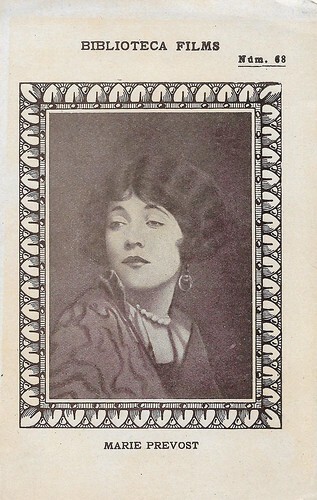
Spanish collectors card by Biblioteca Films, no. 68.
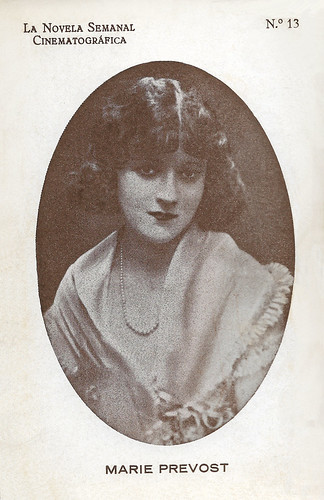
Spanish postcard by La Novela Semanal Cinematográfica, no. 13.
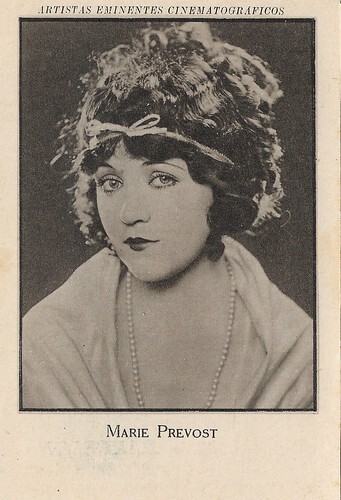
Spanish collectors card in the Artistas eminentes cinematograficos by Chocolates Jaime Boix, Barcelona, series VIII, no. 14 of 20.
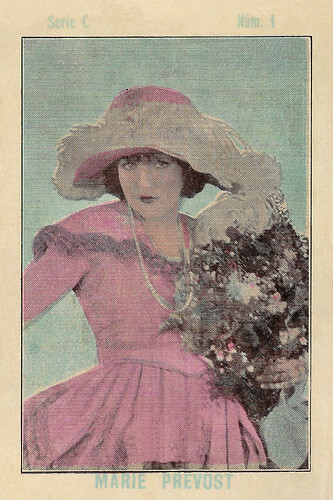
Spanish collectors card by Chocolate E. Juncosa, Barcelona, series 1, no. 1.
Underplaying comedy to achieve the maximum effect
At Universal, Marie Prevost only got light comedy roles. When the contract expired, Jack Warner signed her for Warner Bros, recognizing $ 1,500 a week.
Alongside actor Kenneth Harlan as Tony, Marie played Gloria in The Beautiful and the Damned (Sidney Franklin, 1922), based on F. Scott Fitzgerald's bestseller on two idle spendthrifts who do not know how to cope with money running out.
To publicise the film, the production company announced that the actors would get married during filming on the set. The advertising launch worked and the studios were flooded with letters and gifts for the spouses. But when in the Los Angeles Mirror the story of Prevost's earlier secret marriage appeared: "Marie Prevost will become bigamist if she marries Harlan", Warner immediately took charge of the annulment of that marriage, so Harlan and Marie could marry.
Despite the bad publicity, The Beautiful and Damned was successful. By consequence, Ernst Lubitsch wanted Marie as the beautiful seductress in The Marriage Circle (1924), with Adolphe Menjou , Florence Vidor , and Monte Blue . Lubitsch said that Prevost was one of the few actresses in Hollywood who knew how to underplay comedy to achieve the maximum effect. She was a favourite of Lubitsch who cast her in three of his comedy films: The Marriage Circle (1924), Three Women (1924) and Kiss Me Again (1925).
At Warner's in the mid-1920s, Prevost would star in comedies and dramas with Harrison Ford (the silent actor), Monte Blue , Matt Moore, Douglas Fairbanks Jr., and Kenneth Harlan.
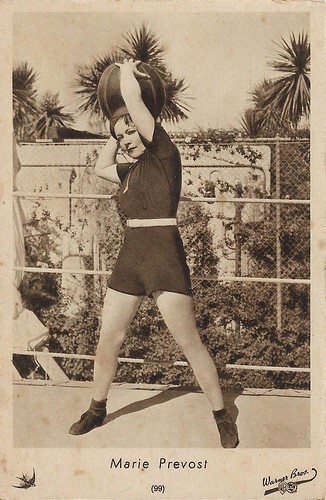
Italian postcard in the '100 Artisti del Cinema' series by Edizione ELAH 'La Casa delle caramelle', no. 99. Photo: Warner Bros.
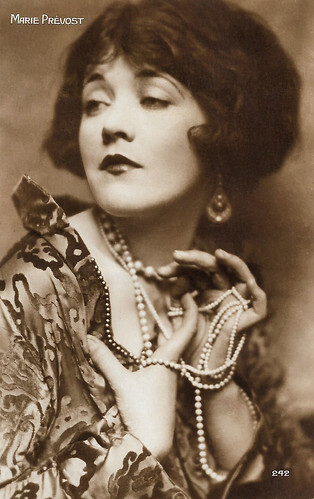
French postcard by Cinémagazine-Edition, no. 242.
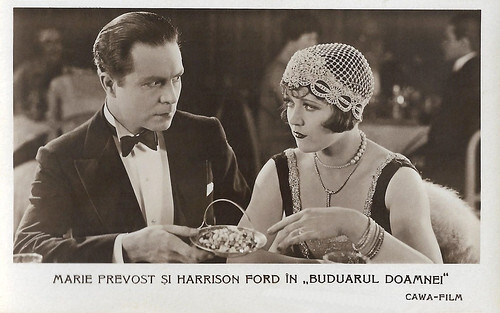
Romanian postcard. Photo: Cawa-Film / Christie Film. Harrison Ford and Marie Prevost in the comedy Up in Mabel's Room (E. Mason Hopper, 1926). The Romanian title 'Buduarul doamnei' translates as 'A Lady's Boudoir'. Plot: Mabel (Prevost) catches her husband (Ford) buying lingerie, and he won't explain who it's for. She divorces him but later learns he was buying her an anniversary gift. She becomes determined to win him back.

Austrian postcard by Iris-Verlag, no. 5618. Photo: PMC / Verleih Mondial.
A brief but fatal relationship with Howard Hughes
In 1926, Warner decided not to prolong the contracts of Harlan and Marie Prevost. The Canadian actress also lost her mother, who, in a car with actress Vera Steadman and producer Al Christie, was killed in an accident in Florida. Hughina was crushed by the vehicle and died at the scene. Steadman and Christie sustained serious injuries but survived.
Devastated by her mother's death and losing her work, Marie's marriage deteriorated. She began to drink and soon slipped into alcoholism. In 1927, she separated from her second husband, and despite a reconciliation in between, she divorced him altogether in 1929.
To overcome the crisis, Prevost threw herself completely at work. After seeing her in The Beautiful and Damned, in 1928 Howard Hughes wanted her to star in The Racket (Lewis Milestone, 1928) with Thomas Meighan. The two had a brief relationship but Hughes soon left her and Marie fell into a deepening depression. The Racket was nominated for the Academy Award for Best Picture (then called Outstanding Picture) in the 1929 Academy Awards.
The Racket would be her last feature film. Marie began to gain weight and could no longer control either food or alcohol. In 1934 her financial situation became dramatic. To find work again, she faced drastic diets that further weakened her. Hal Erickson at AllMovie : "Talking pictures forced Prevost to alter her image; her nasal, high-pitched voice was more suited to wisecracking chorus girls or gum-chewing receptionists than pampered society wives. Prevost was cast in a few good supporting parts throughout the '30s, notably as Carole Lombard's manicurist chum in Hands Across the Table (Mitchell Leisen, 1936). " She made her last onscreen appearance in 1936.
In 1937, Marie Prevost died of a heart attack due to malnutrition and acute alcoholism. She was 40. Her body was found only two days later, due to the continuous and insistent barking of her pet dachshund Maxie. A bellhop came into the house and found her lying face down on the bed, legs marked by the teeth of her dog, which had tried to wake her by biting her. Prevost's death was featured in the book 'Hollywood Babylon' by Kenneth Anger. Anger falsely claims Prevost's dog made "mincemeat out of his mistress", but while Maxie did bite her legs in an effort to wake her, the dog did not attempt to eat her body.
Prevost's estate was valued at $300 since she had squandered most of her earnings. The funeral at the Memorial Cemetery in Hollywood was paid for by Joan Crawford : in addition to Crawford, Clark Gable , Wallace Beery and Barbara Stanwyck participated. Her poor case prompted the Hollywood community to create in the early 1940s the Motion Picture & Television Country House and Hospital to provide medical care for employees of the television and motion picture industry.
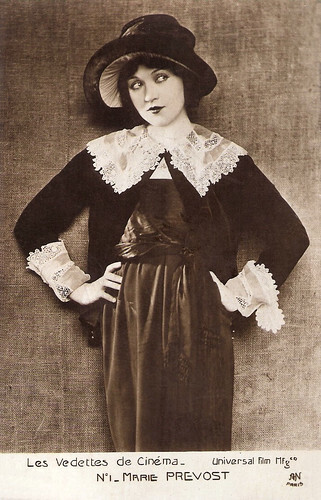
French postcard by A.N., Paris in the Les vedettes de cinéma, series, no. 1. Photo: Universal Film.
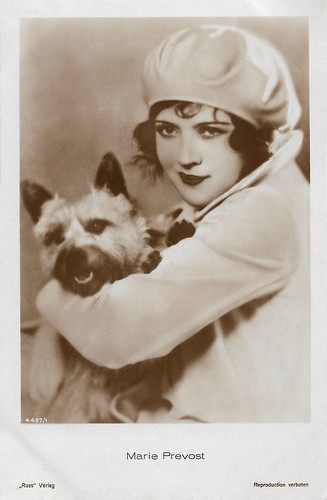
German postcard by Ross Verlag, no. 4467/1, 1929-1930. Collection: Geoffrey Donaldson Institute.

Polish postcard by Polonia, Krakow, no. 455.
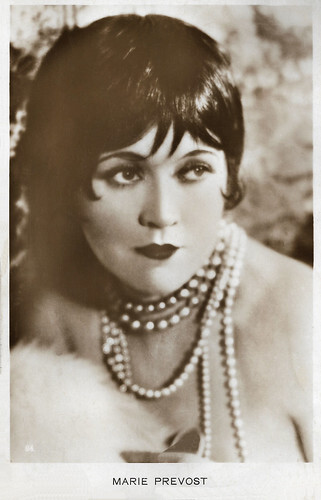
British Real Photograph postcard, no. 84. Sent by mail in 1929.
Sources: Hal Erickson (AllMovie), Stacia Kissick Jones (She blogged by night), Wikipedia (Italian and English), and .

British postcard in the Picturegoer Series, London, no. 100.

British postcard in the Picturegoer Series, London, no. 100a.

Swedish postcard by Eneret B.C. & A.H., no. 505.

Belgian postcard by P.I.A. Belga phot, Bruxelles, no. 37. Photo: Metro-Goldwyn-Mayer.
A French bathing beauty born in Canada
Marie Prevost was born in 1896 in Sarnia, Ontario, Canada, as Mary Bickford Dunn, the daughter of Hughina Marion née Bickford (or McDonald the sources are not sure) and Arthur 'Teddy' Dunn, a railroad conductor. In 1897, when she was an infant, Teddy Dunn was killed when gas seeped into the St. Clair Tunnel. Hughina later married Frank Prevost and the family moved to the U.S. First, the Dunn family settled in Denver, Colorado, then in Los Angeles.
While living in Los Angeles, Prevost attended Manual Arts High School. By 1915, Prevost landed a job as a secretary at a law firm that represented the Keystone Film Company. While running an office errand at the Keystone Studios, Prevost was asked to appear in a bit part for the film His Father's Footsteps. Mack Sennett, Keystone's owner and also of Canadian origin, was impressed and entrusted her with the role of an exotic 'French girl'. He inserted her into his Bathing Beauties, with the stage name of Marie Prevost.
In 1918, Marie was secretly married to Henry Charles 'Sonny' Gerke, a young man from high society, but the marriage failed after only six months because Gerke did not have the courage to tell his mother that he had married an actress. Fearful of the bad publicity resulting from a divorce, Marie remained married until 1923, always keeping everyone unaware of her marriage.
Prevost's first lead role was in Yankee Doodle in Berlin (1919). The film was a hit and helped to solidify Prevost's career. Another success was Love, Honor, and Behave (F. Richard Jones, Erle Kenton, 1920), alongside another Sennett protégé, George O'Hara. A series of small roles followed in which she played the part of the young, innocent sexy girl.
In 1921, Marie signed a contract with Universal after getting the attention of Irving Thalberg. Thalberg decided to make her a star and organised a great advertising hype for her. He announced that Marie would star in two films, The Moonlight Follies (King Baggot, 1921) and Kissed (King Baggot, 1922), and sent her to Coney Island. There the actress publicly burned her bathing suit, signifying the end of her "bathing" days.

Spanish collectors card by Biblioteca Films, no. 68.

Spanish postcard by La Novela Semanal Cinematográfica, no. 13.

Spanish collectors card in the Artistas eminentes cinematograficos by Chocolates Jaime Boix, Barcelona, series VIII, no. 14 of 20.

Spanish collectors card by Chocolate E. Juncosa, Barcelona, series 1, no. 1.
Underplaying comedy to achieve the maximum effect
At Universal, Marie Prevost only got light comedy roles. When the contract expired, Jack Warner signed her for Warner Bros, recognizing $ 1,500 a week.
Alongside actor Kenneth Harlan as Tony, Marie played Gloria in The Beautiful and the Damned (Sidney Franklin, 1922), based on F. Scott Fitzgerald's bestseller on two idle spendthrifts who do not know how to cope with money running out.
To publicise the film, the production company announced that the actors would get married during filming on the set. The advertising launch worked and the studios were flooded with letters and gifts for the spouses. But when in the Los Angeles Mirror the story of Prevost's earlier secret marriage appeared: "Marie Prevost will become bigamist if she marries Harlan", Warner immediately took charge of the annulment of that marriage, so Harlan and Marie could marry.
Despite the bad publicity, The Beautiful and Damned was successful. By consequence, Ernst Lubitsch wanted Marie as the beautiful seductress in The Marriage Circle (1924), with Adolphe Menjou , Florence Vidor , and Monte Blue . Lubitsch said that Prevost was one of the few actresses in Hollywood who knew how to underplay comedy to achieve the maximum effect. She was a favourite of Lubitsch who cast her in three of his comedy films: The Marriage Circle (1924), Three Women (1924) and Kiss Me Again (1925).
At Warner's in the mid-1920s, Prevost would star in comedies and dramas with Harrison Ford (the silent actor), Monte Blue , Matt Moore, Douglas Fairbanks Jr., and Kenneth Harlan.

Italian postcard in the '100 Artisti del Cinema' series by Edizione ELAH 'La Casa delle caramelle', no. 99. Photo: Warner Bros.

French postcard by Cinémagazine-Edition, no. 242.

Romanian postcard. Photo: Cawa-Film / Christie Film. Harrison Ford and Marie Prevost in the comedy Up in Mabel's Room (E. Mason Hopper, 1926). The Romanian title 'Buduarul doamnei' translates as 'A Lady's Boudoir'. Plot: Mabel (Prevost) catches her husband (Ford) buying lingerie, and he won't explain who it's for. She divorces him but later learns he was buying her an anniversary gift. She becomes determined to win him back.

Austrian postcard by Iris-Verlag, no. 5618. Photo: PMC / Verleih Mondial.
A brief but fatal relationship with Howard Hughes
In 1926, Warner decided not to prolong the contracts of Harlan and Marie Prevost. The Canadian actress also lost her mother, who, in a car with actress Vera Steadman and producer Al Christie, was killed in an accident in Florida. Hughina was crushed by the vehicle and died at the scene. Steadman and Christie sustained serious injuries but survived.
Devastated by her mother's death and losing her work, Marie's marriage deteriorated. She began to drink and soon slipped into alcoholism. In 1927, she separated from her second husband, and despite a reconciliation in between, she divorced him altogether in 1929.
To overcome the crisis, Prevost threw herself completely at work. After seeing her in The Beautiful and Damned, in 1928 Howard Hughes wanted her to star in The Racket (Lewis Milestone, 1928) with Thomas Meighan. The two had a brief relationship but Hughes soon left her and Marie fell into a deepening depression. The Racket was nominated for the Academy Award for Best Picture (then called Outstanding Picture) in the 1929 Academy Awards.
The Racket would be her last feature film. Marie began to gain weight and could no longer control either food or alcohol. In 1934 her financial situation became dramatic. To find work again, she faced drastic diets that further weakened her. Hal Erickson at AllMovie : "Talking pictures forced Prevost to alter her image; her nasal, high-pitched voice was more suited to wisecracking chorus girls or gum-chewing receptionists than pampered society wives. Prevost was cast in a few good supporting parts throughout the '30s, notably as Carole Lombard's manicurist chum in Hands Across the Table (Mitchell Leisen, 1936). " She made her last onscreen appearance in 1936.
In 1937, Marie Prevost died of a heart attack due to malnutrition and acute alcoholism. She was 40. Her body was found only two days later, due to the continuous and insistent barking of her pet dachshund Maxie. A bellhop came into the house and found her lying face down on the bed, legs marked by the teeth of her dog, which had tried to wake her by biting her. Prevost's death was featured in the book 'Hollywood Babylon' by Kenneth Anger. Anger falsely claims Prevost's dog made "mincemeat out of his mistress", but while Maxie did bite her legs in an effort to wake her, the dog did not attempt to eat her body.
Prevost's estate was valued at $300 since she had squandered most of her earnings. The funeral at the Memorial Cemetery in Hollywood was paid for by Joan Crawford : in addition to Crawford, Clark Gable , Wallace Beery and Barbara Stanwyck participated. Her poor case prompted the Hollywood community to create in the early 1940s the Motion Picture & Television Country House and Hospital to provide medical care for employees of the television and motion picture industry.

French postcard by A.N., Paris in the Les vedettes de cinéma, series, no. 1. Photo: Universal Film.

German postcard by Ross Verlag, no. 4467/1, 1929-1930. Collection: Geoffrey Donaldson Institute.

Polish postcard by Polonia, Krakow, no. 455.

British Real Photograph postcard, no. 84. Sent by mail in 1929.
Sources: Hal Erickson (AllMovie), Stacia Kissick Jones (She blogged by night), Wikipedia (Italian and English), and .
Published on February 24, 2022 22:00
February 23, 2022
Grace Cunard
American actress Grace Cunard (1893–1967) was one of Universal's most popular serial queens in the 1910s. She was known to her fans as a daring jewel thief, an athletic reporter with a nose for news, and a circus tamer of rather ferocious cats. Typical for the pioneer years, Cunard also wrote some 100 film scripts, directed 11 films, and produced two others. In addition, she edited many of her films, including some of the shorts, serials, and features she developed in collaboration with actor and director Francis Ford. By 1916 they were ranked among the most popular stars in Hollywood.

British postcard by Trans-Atlantic Film Co. LTD. Transatlantic-Film Co., Ltd., was the British distributor for Europe for Universal's films in the 1910s.
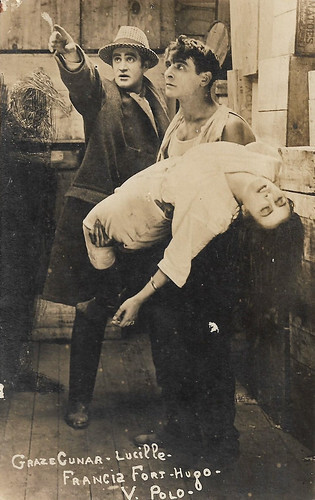
Spanish postcard. Photo: Universal. Francis Ford, Grace Cunard, and Eddie Polo in the serial The Broken Coin (Francis Ford, 1915), co-scripted by Cunard. The serial is presumably lost.
Acting and writing talents, as well as her unerring taste for the popular
Grace Cunard was born Harriet Mildred Jeffries in 1893 in Columbus, Ohio. Harriet was the elder of two daughters of Ohio natives Washington and Lola (née Longshore) Jeffries. Her younger sister, Armina, would also become a film actress, Mina Cunard. Harriet completed her formal education in Columbus, leaving school after the eighth grade, presumably to devote full time to an acting career.
By 1906, at the age of 13, the future film star was already acting in local stage productions such as 'Dora Thorne', 'East Lynne', and then in New York in 'Princess of Patches'. As Grace Cunard, she started acting in films in 1908 for the Biograph Company on East 14th Street in Manhattan. She enjoyed the experience, so she pursued more film roles, which at first consisted of small uncredited parts.
Over the next three years, she was cast in better roles at Biograph and at other studios located in New York, New Jersey, and Pennsylvania, including Kalem Studios, Edison, the American subsidiary of Pathé, Republic, and Lubin. In 1912, Grace Cunard moved to California to work in the rapidly expanding film industry there. She was initially hired by "fledgling producer" Thomas H. Ince at Bison Studio.
At Bison, director and actor Francis Ford cast her as the wife of General George Armstrong Custer in the two-reel military drama Custer's Last Fight (Francis Ford, 1912). After her high-profile role in that release, Ince fired her when she refused to leave Ford's company to work elsewhere at Bison. Ford, infuriated by her treatment, left Bison with his crew and players, including Cunard, to work for Universal Pictures.
Jennifer M. Bean at Women Film Pioneers Project: "Cunard’s potent celebrity status in the 1910s cannot be considered outside of her partnership with Francis Ford (born Francis Feeney, the elder brother of Western director John Ford), whom she met in 1912. Cunard’s acting and writing talents, as well as her unerring taste for the popular, merged well with Ford’s directorial experience".
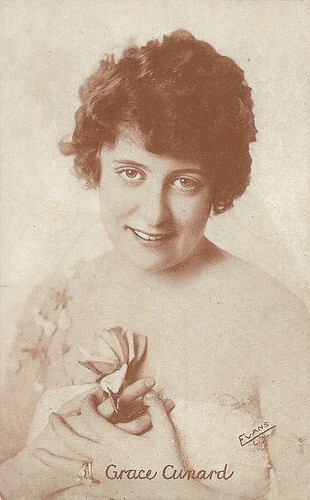
American arcade card. Photo: Evans, Los Angeles.
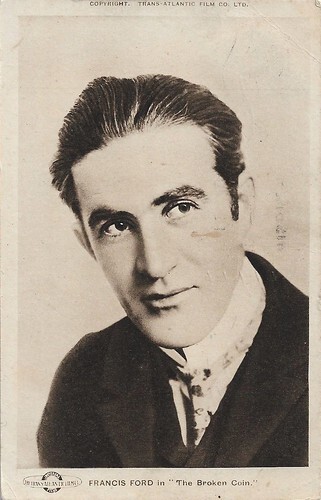
British postcard by The Trans-Atlantic Film Co. (British subsidiary of Universal in Europe). Francis Ford as the male lead in the Universal serial The Broken Coin (Francis Ford, 1915), co-scripted by Grace Cunard, female lead of the serial.
The Master Pen
At Universal Grace Cunard continued throughout 1913 to co-star and collaborate with Francis Ford in other two-reel shorts like The Black Masks, From Dawn Till Dark, The White Vaquero, The Belle of Yorktown, From Rail Splitter to President, and others. Their close professional relationship, which had quickly evolved into a personal one as well, led many movie fans to assume the couple was married. The two were increasingly being referred to in trade publications and newspapers as the production team of "Ford-Cunard", with Francis being credited consistently for directing and both of them being praised as "unusually promising screen artists".
By 1914, Grace was being recognised too in the press for her writing. Jennifer M. Bean: "She was also known as 'The Master Pen', a thinly veiled pseudonym that graced announcements and title cards for her first serial story and star vehicle, Lucille Love, The Girl of Mystery (Francis Ford, 1914). Although the exact number of screenplays, stories, and scenarios for which she received credit is unknown, the publicity surrounding her seven-year career at Universal stressed her capacity to 'write everything' in which she appeared."
The She Wolf (Francis Ford, 1913) which was released by Bison Pictures, was one in a series of films in that period that focused attention on Cunard's writing. Promoted as a 'photoplay' about an evil woman, a "wrecker of men's hearts and reputations", She Wolf circulated throughout the country and by May 1914 finally reached Phoenix, Arizona. The Arizona Republican announced, "One of the most interesting and thrilling moving pictures ever shown at the Regale theater, is that scheduled for today. Francis Ford has dramatized Grace Cunard's famous novel, 'She Wolf', and with Miss Cunard appears in the moving picture version of the story."
Cunard and Ford continued their collaboration throughout 1914, releasing an array of two-reel historical dramas, Westerns, comedies, and mysteries, such as The Mad Hermit, The Fall of '64, Won in the First, The Mysterious Leopard Lady, and Washington at Valley Forge. Jennifer M. Bean: "Lauded as making the most “popular” of films, Cunard’s stories tend toward the fantastic, and her female characters tend toward the fantastically unconventional. In 1914 Cunard created 'My Lady Raffles', a jewel thief with a delightfully reckless charm who first appeared in short films like The Mysterious Leopard Lady (1914) and The Mystery of the White Car (1914)."
Turning to a more ambitious project, Cunard and Ford developed for Universal in 1914 and also co-starred in the 15-episode serial Lucille Love, Girl of Mystery. That production's enormous success is reflected in the box-office receipts it generated. Costing only $30,000 or $2,000 per episode to make, the Lucille Love series eventually grossed what was then a staggering return in ticket sales: $1,500,000 ($38,760,000 today). The financial success of Lucille Love inspired the Ford-Cunard partnership to release between their ongoing shorts three more serials for Universal over the next two years: the 22-episode The Broken Coin (Francis Ford, 1915), the 15-episode The Adventures of Peg o' the Ring (Francis Ford, Jacques Jaccard, 1916), and the 16-episode The Purple Mask (Grace Cunard, Francis Ford, 1916-1917).
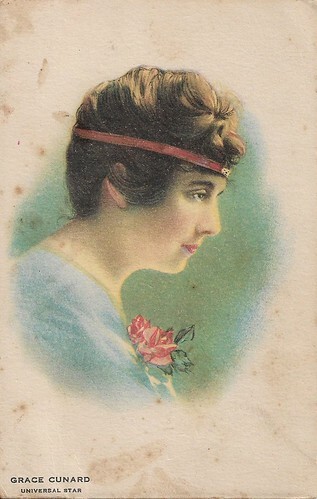
American postcard by Kline Poster Co., Inc., Philadelphia. Picture: Universal. The picture is clearly inspired by the photo portrait on the cards above and below.
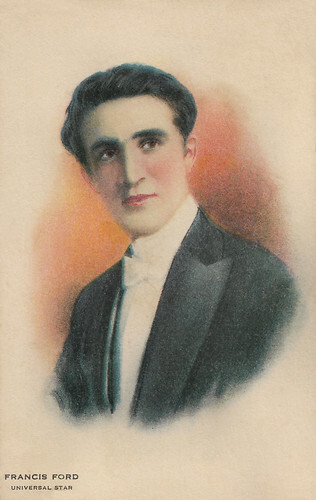
American postcard by Kline Poster Co. Inc., Phila. Image: Universal. Francis Ford.
Hugely popular in Australia, Czechoslovakia, Mexico, India, and Japan
The intrepid behaviour of Grace Cunard’s zany female characters made her a favourite among audiences at the time, whose numbers reportedly stretched across Australia, Czechoslovakia, Mexico, and Japan. Moving Picture Weekly reported in 1916 that the Ford-Cunard team in The Broken Coin was enjoying huge popularity in India.
Cunard's collaboration with Francis Ford continued into 1917, the same year she married for the second time, not to Ford but to the Irish-born actor Joe Moore. Although the media had referred to her as "Miss" since she began working with Ford in 1912, Cunard had married earlier that same year in New York before moving to California.
Wikipedia: "That first marriage appears to have been short-lived and ended, if not legally, for all practical purposes by the time she arrived on the West Coast. Nevertheless, Cunard's collaboration with Ford finally ended after June 1917 with the release of In Treason's Grasp, a five-reeler he directed for Renowned Pictures and in which she co-starred with him."
At the time Cunard started working in films, it was not uncommon for members on set and in post-production to assume a variety of additional duties beyond their primary assignments. Cunard was no exception. While it is now well documented that a significant number of the 'pioneers' in early American filmmaking were women, it was still not common by the 1910s for a young actress with an eighth-grade education to write, perform in, direct, and edit films to the extent Cunard did, often doing all those duties on a single project.
Totals vary in film references regarding the number of silent productions in which she worked. Wikipedia: "Her entry in the 2005 edition of The Encyclopedia of Early Cinema credits her with starring in over 100 silent films, writing screenplays or treatments for 44 of those releases, and directing at least eight of them on her own and more in concert with Ford. Some period newspapers and trade publications credit her with writing between 150 and 200 'photoplays', while one newspaper in 1915 reported that she had authored 400 scenarios, a highly implausible figure given the amount of time Cunard had worked in motion pictures by then. Whatever the true totals, news items and reviews of her completed films testify that her output was prodigious, especially between 1913 and 1918."
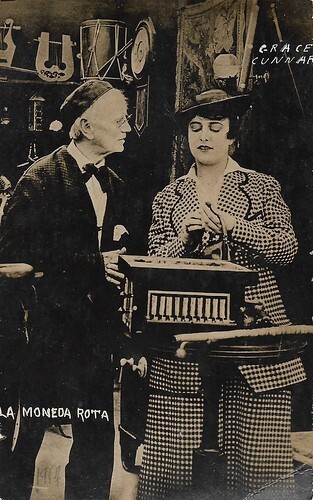
Spanish postcard. Photo: Universal. Grace Cunard in The Broken Coin (Francis Ford, 1915). The man may be Doc Crane, who plays a pawnbroker.
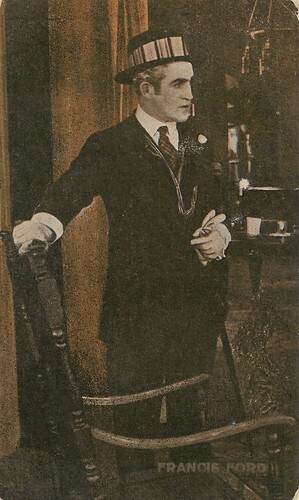
Spanish cromo (collectors card) by Amatller Marca Luna, Series 1a, no. 31. Photo: Universal. Francis Ford as Count Hugo in the serial The Broken Coin (Ford 1915), released in Spain as 'La Moneda Rota'.
Cast in fewer and fewer primary roles
Grace Cunard's work as an actor, writer, and director did not cease after her collaboration with Ford ended. She starred in Hell's Crater (W. B. Pearson, 1918), an elaborate five-reel Western, filmed on location in Death Valley National Park. Released by Universal, Hell's Crater was heavily promoted in trade publications. The next year she returned to acting in a serial format, 'supporting' Elmo Lincoln in 18 episodes of Elmo the Mighty (Henry MacRae, J.P. McGowan, 1919).
During 1920 and 1921, she had opportunities working with Marion H. Kohn Productions of San Francisco to once again use the full range of her talents in a series of two-reel Westerns. She wrote, directed, and starred in The Man Hater (1920); directed and starred in Gasoline Buckaroo (1920) and A Daughter of The Law (1921); wrote and starred in The Gun Runners (Louis King, 1921); and co-wrote, directed, and co-starred with Cole Hebert in Her Western Adventure (1921).
After she co-starred in The Last Man on Earth (John G. Blystone, 1924) with Earle Foxe and The Elk's Tooth (Clarence Bricker, 1924) with Lillian Hall, she was cast in fewer and fewer primary roles and was relegated to playing secondary characters for the remainder of the decade. Throughout the 1930s, Cunard continued to act but the complexity of her roles steadily declined until she performed predominantly in minor or uncredited bit parts.
In the 1940s she still secured work at RKO, Republic, and in a few productions at her old 'home studio', Universal. One of her more visible roles among her final appearances in that period is in the serial Gang Busters (Noel M. Smith, Ray Taylor, 1942). She only appears as a landlady in one of its 13 episodes, but her presence in that production was deemed important enough by Universal to include her name in a third-tier bold credit on the serial's theater posters.
Her last screen appearance, one uncredited, is in the role of a woman with a baby in the drama Magnificent Doll (Frank Borzage, 1946) starring Ginger Rogers and David Niven . Shortly after the release of that film, Universal underwent a change in leadership and administrative restructuring, which resulted in the studio discontinuing its program of serials and low-budget features.
Grace Cunard was 53 years old by that time, so after working nearly four decades in motion pictures, she decided to retire permanently from the industry. Cunard was married three times. In 1912 in New York, at the age of 19, she married actor Harry Harvey, who was 20 years her senior. That marriage ended before 1917, although the reasons for its ending are not clearly documented. Her next marriage was to Irish-born actor Joe Moore. They wed at Seal Beach, California, in 1917 but divorced eight years later. Then, in 1925, Cunard married Frederick Lorenzo Tyler, a film stuntman who professionally used the name, Jack Tyler Shannon. They remained married for over 40 years, until her death from cancer in 1967.
At the time of her death, she was residing at the Motion Picture Country Home in Woodland Hills, a neighbourhood of Los Angeles. Her gravesite is also in Los Angeles, at Oakwood Memorial Park Cemetery in the neighborhood of Chatsworth. The Ford-Cunard 1917 short Unmasked was selected in 2014 by the United States Film Preservation Board for inclusion in the National Film Registry. In 2018, in recognition of the many contributions made by women to the development of the motion-picture industry in the silent era, film library, and distributor Kino Lorber, Inc., in cooperation with the Library of Congress, released a special six-disc box set titled 'Pioneers: First Women Filmmakers'. Included in that set are copies of three episodes from Cunard's serial The Purple Mask (1916-1917 ) as well as a copy of her short The Daughter of 'The Law' (Grace Cunard, 1921).
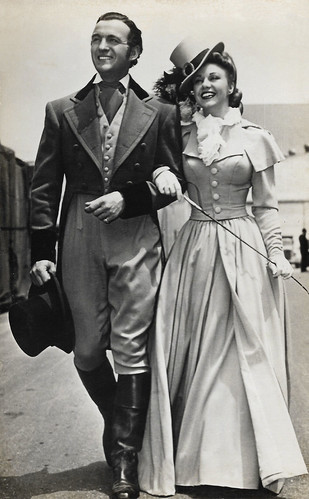
Spanish postcard. David Niven and Ginger Rogers in Magnificent Doll (Frank Borzage, 1946).

British postcard. Photo: Transatlantic-Film Co., Ltd.
Sources: Jennifer M. Bean (Women Film Pioneers Project - temporarily defunct), Wikipedia, and .

British postcard by Trans-Atlantic Film Co. LTD. Transatlantic-Film Co., Ltd., was the British distributor for Europe for Universal's films in the 1910s.

Spanish postcard. Photo: Universal. Francis Ford, Grace Cunard, and Eddie Polo in the serial The Broken Coin (Francis Ford, 1915), co-scripted by Cunard. The serial is presumably lost.
Acting and writing talents, as well as her unerring taste for the popular
Grace Cunard was born Harriet Mildred Jeffries in 1893 in Columbus, Ohio. Harriet was the elder of two daughters of Ohio natives Washington and Lola (née Longshore) Jeffries. Her younger sister, Armina, would also become a film actress, Mina Cunard. Harriet completed her formal education in Columbus, leaving school after the eighth grade, presumably to devote full time to an acting career.
By 1906, at the age of 13, the future film star was already acting in local stage productions such as 'Dora Thorne', 'East Lynne', and then in New York in 'Princess of Patches'. As Grace Cunard, she started acting in films in 1908 for the Biograph Company on East 14th Street in Manhattan. She enjoyed the experience, so she pursued more film roles, which at first consisted of small uncredited parts.
Over the next three years, she was cast in better roles at Biograph and at other studios located in New York, New Jersey, and Pennsylvania, including Kalem Studios, Edison, the American subsidiary of Pathé, Republic, and Lubin. In 1912, Grace Cunard moved to California to work in the rapidly expanding film industry there. She was initially hired by "fledgling producer" Thomas H. Ince at Bison Studio.
At Bison, director and actor Francis Ford cast her as the wife of General George Armstrong Custer in the two-reel military drama Custer's Last Fight (Francis Ford, 1912). After her high-profile role in that release, Ince fired her when she refused to leave Ford's company to work elsewhere at Bison. Ford, infuriated by her treatment, left Bison with his crew and players, including Cunard, to work for Universal Pictures.
Jennifer M. Bean at Women Film Pioneers Project: "Cunard’s potent celebrity status in the 1910s cannot be considered outside of her partnership with Francis Ford (born Francis Feeney, the elder brother of Western director John Ford), whom she met in 1912. Cunard’s acting and writing talents, as well as her unerring taste for the popular, merged well with Ford’s directorial experience".

American arcade card. Photo: Evans, Los Angeles.

British postcard by The Trans-Atlantic Film Co. (British subsidiary of Universal in Europe). Francis Ford as the male lead in the Universal serial The Broken Coin (Francis Ford, 1915), co-scripted by Grace Cunard, female lead of the serial.
The Master Pen
At Universal Grace Cunard continued throughout 1913 to co-star and collaborate with Francis Ford in other two-reel shorts like The Black Masks, From Dawn Till Dark, The White Vaquero, The Belle of Yorktown, From Rail Splitter to President, and others. Their close professional relationship, which had quickly evolved into a personal one as well, led many movie fans to assume the couple was married. The two were increasingly being referred to in trade publications and newspapers as the production team of "Ford-Cunard", with Francis being credited consistently for directing and both of them being praised as "unusually promising screen artists".
By 1914, Grace was being recognised too in the press for her writing. Jennifer M. Bean: "She was also known as 'The Master Pen', a thinly veiled pseudonym that graced announcements and title cards for her first serial story and star vehicle, Lucille Love, The Girl of Mystery (Francis Ford, 1914). Although the exact number of screenplays, stories, and scenarios for which she received credit is unknown, the publicity surrounding her seven-year career at Universal stressed her capacity to 'write everything' in which she appeared."
The She Wolf (Francis Ford, 1913) which was released by Bison Pictures, was one in a series of films in that period that focused attention on Cunard's writing. Promoted as a 'photoplay' about an evil woman, a "wrecker of men's hearts and reputations", She Wolf circulated throughout the country and by May 1914 finally reached Phoenix, Arizona. The Arizona Republican announced, "One of the most interesting and thrilling moving pictures ever shown at the Regale theater, is that scheduled for today. Francis Ford has dramatized Grace Cunard's famous novel, 'She Wolf', and with Miss Cunard appears in the moving picture version of the story."
Cunard and Ford continued their collaboration throughout 1914, releasing an array of two-reel historical dramas, Westerns, comedies, and mysteries, such as The Mad Hermit, The Fall of '64, Won in the First, The Mysterious Leopard Lady, and Washington at Valley Forge. Jennifer M. Bean: "Lauded as making the most “popular” of films, Cunard’s stories tend toward the fantastic, and her female characters tend toward the fantastically unconventional. In 1914 Cunard created 'My Lady Raffles', a jewel thief with a delightfully reckless charm who first appeared in short films like The Mysterious Leopard Lady (1914) and The Mystery of the White Car (1914)."
Turning to a more ambitious project, Cunard and Ford developed for Universal in 1914 and also co-starred in the 15-episode serial Lucille Love, Girl of Mystery. That production's enormous success is reflected in the box-office receipts it generated. Costing only $30,000 or $2,000 per episode to make, the Lucille Love series eventually grossed what was then a staggering return in ticket sales: $1,500,000 ($38,760,000 today). The financial success of Lucille Love inspired the Ford-Cunard partnership to release between their ongoing shorts three more serials for Universal over the next two years: the 22-episode The Broken Coin (Francis Ford, 1915), the 15-episode The Adventures of Peg o' the Ring (Francis Ford, Jacques Jaccard, 1916), and the 16-episode The Purple Mask (Grace Cunard, Francis Ford, 1916-1917).

American postcard by Kline Poster Co., Inc., Philadelphia. Picture: Universal. The picture is clearly inspired by the photo portrait on the cards above and below.

American postcard by Kline Poster Co. Inc., Phila. Image: Universal. Francis Ford.
Hugely popular in Australia, Czechoslovakia, Mexico, India, and Japan
The intrepid behaviour of Grace Cunard’s zany female characters made her a favourite among audiences at the time, whose numbers reportedly stretched across Australia, Czechoslovakia, Mexico, and Japan. Moving Picture Weekly reported in 1916 that the Ford-Cunard team in The Broken Coin was enjoying huge popularity in India.
Cunard's collaboration with Francis Ford continued into 1917, the same year she married for the second time, not to Ford but to the Irish-born actor Joe Moore. Although the media had referred to her as "Miss" since she began working with Ford in 1912, Cunard had married earlier that same year in New York before moving to California.
Wikipedia: "That first marriage appears to have been short-lived and ended, if not legally, for all practical purposes by the time she arrived on the West Coast. Nevertheless, Cunard's collaboration with Ford finally ended after June 1917 with the release of In Treason's Grasp, a five-reeler he directed for Renowned Pictures and in which she co-starred with him."
At the time Cunard started working in films, it was not uncommon for members on set and in post-production to assume a variety of additional duties beyond their primary assignments. Cunard was no exception. While it is now well documented that a significant number of the 'pioneers' in early American filmmaking were women, it was still not common by the 1910s for a young actress with an eighth-grade education to write, perform in, direct, and edit films to the extent Cunard did, often doing all those duties on a single project.
Totals vary in film references regarding the number of silent productions in which she worked. Wikipedia: "Her entry in the 2005 edition of The Encyclopedia of Early Cinema credits her with starring in over 100 silent films, writing screenplays or treatments for 44 of those releases, and directing at least eight of them on her own and more in concert with Ford. Some period newspapers and trade publications credit her with writing between 150 and 200 'photoplays', while one newspaper in 1915 reported that she had authored 400 scenarios, a highly implausible figure given the amount of time Cunard had worked in motion pictures by then. Whatever the true totals, news items and reviews of her completed films testify that her output was prodigious, especially between 1913 and 1918."

Spanish postcard. Photo: Universal. Grace Cunard in The Broken Coin (Francis Ford, 1915). The man may be Doc Crane, who plays a pawnbroker.

Spanish cromo (collectors card) by Amatller Marca Luna, Series 1a, no. 31. Photo: Universal. Francis Ford as Count Hugo in the serial The Broken Coin (Ford 1915), released in Spain as 'La Moneda Rota'.
Cast in fewer and fewer primary roles
Grace Cunard's work as an actor, writer, and director did not cease after her collaboration with Ford ended. She starred in Hell's Crater (W. B. Pearson, 1918), an elaborate five-reel Western, filmed on location in Death Valley National Park. Released by Universal, Hell's Crater was heavily promoted in trade publications. The next year she returned to acting in a serial format, 'supporting' Elmo Lincoln in 18 episodes of Elmo the Mighty (Henry MacRae, J.P. McGowan, 1919).
During 1920 and 1921, she had opportunities working with Marion H. Kohn Productions of San Francisco to once again use the full range of her talents in a series of two-reel Westerns. She wrote, directed, and starred in The Man Hater (1920); directed and starred in Gasoline Buckaroo (1920) and A Daughter of The Law (1921); wrote and starred in The Gun Runners (Louis King, 1921); and co-wrote, directed, and co-starred with Cole Hebert in Her Western Adventure (1921).
After she co-starred in The Last Man on Earth (John G. Blystone, 1924) with Earle Foxe and The Elk's Tooth (Clarence Bricker, 1924) with Lillian Hall, she was cast in fewer and fewer primary roles and was relegated to playing secondary characters for the remainder of the decade. Throughout the 1930s, Cunard continued to act but the complexity of her roles steadily declined until she performed predominantly in minor or uncredited bit parts.
In the 1940s she still secured work at RKO, Republic, and in a few productions at her old 'home studio', Universal. One of her more visible roles among her final appearances in that period is in the serial Gang Busters (Noel M. Smith, Ray Taylor, 1942). She only appears as a landlady in one of its 13 episodes, but her presence in that production was deemed important enough by Universal to include her name in a third-tier bold credit on the serial's theater posters.
Her last screen appearance, one uncredited, is in the role of a woman with a baby in the drama Magnificent Doll (Frank Borzage, 1946) starring Ginger Rogers and David Niven . Shortly after the release of that film, Universal underwent a change in leadership and administrative restructuring, which resulted in the studio discontinuing its program of serials and low-budget features.
Grace Cunard was 53 years old by that time, so after working nearly four decades in motion pictures, she decided to retire permanently from the industry. Cunard was married three times. In 1912 in New York, at the age of 19, she married actor Harry Harvey, who was 20 years her senior. That marriage ended before 1917, although the reasons for its ending are not clearly documented. Her next marriage was to Irish-born actor Joe Moore. They wed at Seal Beach, California, in 1917 but divorced eight years later. Then, in 1925, Cunard married Frederick Lorenzo Tyler, a film stuntman who professionally used the name, Jack Tyler Shannon. They remained married for over 40 years, until her death from cancer in 1967.
At the time of her death, she was residing at the Motion Picture Country Home in Woodland Hills, a neighbourhood of Los Angeles. Her gravesite is also in Los Angeles, at Oakwood Memorial Park Cemetery in the neighborhood of Chatsworth. The Ford-Cunard 1917 short Unmasked was selected in 2014 by the United States Film Preservation Board for inclusion in the National Film Registry. In 2018, in recognition of the many contributions made by women to the development of the motion-picture industry in the silent era, film library, and distributor Kino Lorber, Inc., in cooperation with the Library of Congress, released a special six-disc box set titled 'Pioneers: First Women Filmmakers'. Included in that set are copies of three episodes from Cunard's serial The Purple Mask (1916-1917 ) as well as a copy of her short The Daughter of 'The Law' (Grace Cunard, 1921).

Spanish postcard. David Niven and Ginger Rogers in Magnificent Doll (Frank Borzage, 1946).

British postcard. Photo: Transatlantic-Film Co., Ltd.
Sources: Jennifer M. Bean (Women Film Pioneers Project - temporarily defunct), Wikipedia, and .
Published on February 23, 2022 22:00
February 22, 2022
Avatar (2009)
Avatar (2009) is an American stereoscopic (3D) Science-Fiction film directed by James Cameron. The film grossed over US$2.7 billion, making it the most successful film ever made. The film also won three Oscars.
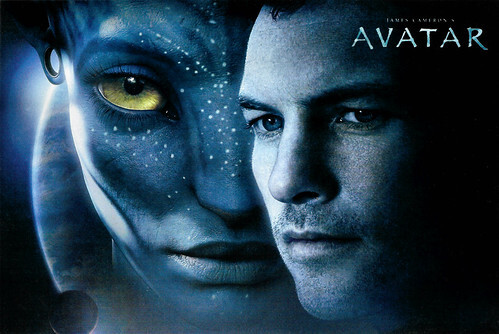
Chinese postcard by Oriental City Publishing Group Limited. Sam Worthington in Avatar (James Cameron, 2009).
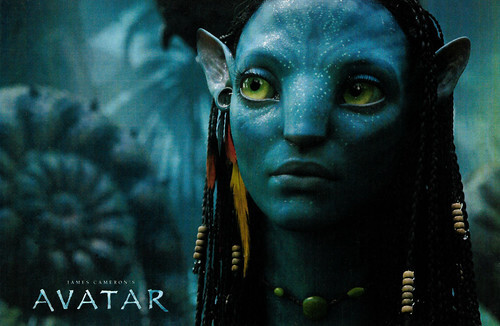
Chinese postcard by Oriental City Publishing Group Limited. Image of Avatar (James Cameron, 2009).
A precious mineral called unobtanium
Avatar (2009) is situated in 2154 on the fictional moon Pandora of the planet Polyphemus orbiting the star Alpha Centauri A. An Earth mining company, led by Parker Selfridge (Giovanni Ribisi), has a branch on Pandora to mine a precious mineral, unobtanium. For the interstellar space journey to and from Earth, fast spaceships are used that cover the four light-years in six years.
Moreover, people are transported in a frozen state, so the journey seems to be very short. On Pandora, there is an indigenous population of humanoid beings, the Na'vi. They are intelligent like humans but technologically less advanced. They walk on two legs like humans, are 10 feet tall, slender, agile, with a tail and skin with a zebra pattern of light and dark blue.
People have developed a technique to create a being that is a genetic hybrid between a particular human and the Na'vi, its so-called avatar. The human being can be mentally wirelessly connected to his/her avatar through equipment so that he/she can control it, and can see and feel through the avatar while his/her own body sleeps. When the avatar is sleeping the connection can be broken so that the driver can eat and report.
Through the avatars people can more easily make contact with the Na'vi, moreover, the avatar does not have to wear an oxygen mask as people do on Pandora. Sam Worthington plays Jake Sully, a paraplegic Marine who is dispatched to Pandora on a secret mission. There he learns of greedy corporate figurehead Selfridge's intentions of driving off the native Na'vi in order to mine for the precious unobtanium scattered throughout their rich woodland.
In exchange for the spinal surgery that will fix his legs, Jake gathers knowledge, of the Indigenous Race and their Culture, for the cooperating military unit spearheaded by gung-ho Colonel Quaritch (Stephen Lang), while simultaneously attempting to infiltrate the Na'vi people with the use of an avatar identity. While Jake begins to bond with the native tribe and quickly falls in love with the beautiful alien Neytiri (Zoe Saldana), the restless Colonel moves forward with his ruthless extermination tactics. Jake becomes torn between following his orders and protecting the world he feels now is his home.

Chinese postcard by Oriental City Publishing Group Limited. Image of Avatar (James Cameron, 2009).

Chinese postcard by Oriental City Publishing Group Limited. Image of Avatar (James Cameron, 2009).
A revolutionary motion-capture system
Avatar (2009) was the first major film production that James Cameron directed after his big success, Titanic (1997). Avatar is a large-scale, ambitious Science-Fiction film that uses many new techniques. The film consists partly of computer-generated objects, such as the Na'vi and avatars, for which motion capture was used.
This revolutionary motion-capture system allows the facial expressions of actors to be captured as a virtual camera system enables them to see what their computer-generated counterparts will be seeing in the film. The New Zealand company Weta Digital, known for Peter Jackson's The Lord of the Rings, produced extensive computer animation and effects. Cameron was given a budget of US$195 million by 20th Century Fox for the project, but this amount has been further increased.
The film was shot in 3D using two high-definition cameras in one housing, creating depth. Circularly polarised glasses are used in the screening, but the film has also been released in 2D. Just as for Titanic, Cameron selected young, relatively unknown but, according to him, talented actors, such as Sam Worthington. The music for the film was composed by James Horner, just as for Cameron's earlier films Aliens (1986) and Titanic (1997).
Cameron had wanted to make the film earlier. As early as 1995, he wrote an 80-page script for Avatar. In August 1996, Cameron announced that he would start working on Avatar immediately after Titanic. The plans were already at an advanced stage; six actors would play the leading roles, the budget would be 100 million dollars and Digital Domain would produce the special effects. This original plan did not go ahead, because it appeared that the technology was not yet so advanced.
The premiere date of Avatar was postponed again and again in 2006, originally it was 2007, later 2008, and finally 2009. Avatar (2009) became a massive hit worldwide and received three Oscars, for Best Cinematography - Mauro Fiore, for Best Art Direction - Rick Carter, Robert Stromberg, Kim Sinclair, and for Best Visual Effects - Joe Letteri, Stephen Rosenbaum, Richard Baneham, Andy Jones.
Jeremy Wheeler at AllMovie: "Sometimes a film comes along that pushes the boundaries of what moviemaking can yield - the kind of movie that reaches beyond the limits of the medium and blazes a new trail, subsequently allowing others with abundant resources to follow in its path. Despite any nitpicky flaws one might - or might not - find within the picture, James Cameron's Avatar is absolutely this kind of touchstone."
Roger Ebert: "At 163 minutes, the film doesn't feel too long. It contains so much. The human stories. The Na'vi stories, for the Na'vi are also developed as individuals. The complexity of the planet, which harbors a global secret. The ultimate warfare, with Jake joining the resistance against his former comrades. Small graceful details like a floating creature that looks like a cross between a blowing dandelion seed and a drifting jellyfish, and embodies goodness. Or astonishing floating cloud-islands."
James Cameron is working on several sequels to Avatar. The first sequel, Avatar 2, has already been postponed many times, but according to IMDb , it will be released in cinemas on 16 December 2022. Jake Sully (Sam Worthington) lives with his newfound family formed on the planet of Pandora. Once a familiar threat returns to finish what was previously started, Jake must work with Neytiri and the army of the Na'vi race to protect their planet. The cast will include Kate Winslet , Michelle Yeoh, and Sigourney Weaver.
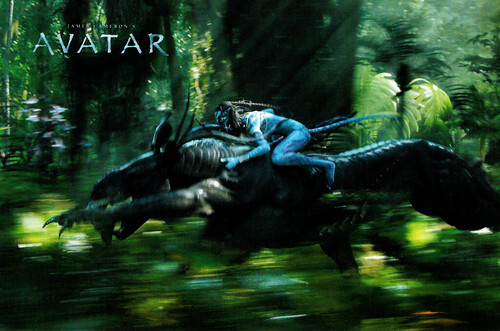
Chinese postcard by Oriental City Publishing Group Limited. Image of Avatar (James Cameron, 2009).
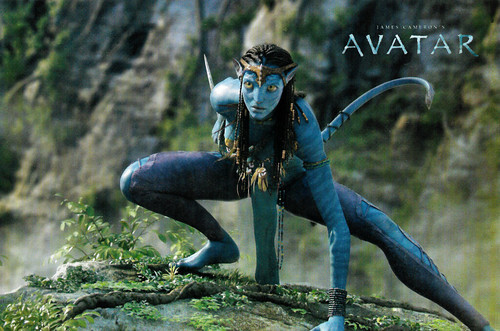
Chinese postcard by Oriental City Publishing Group Limited. Image of Avatar (James Cameron, 2009).
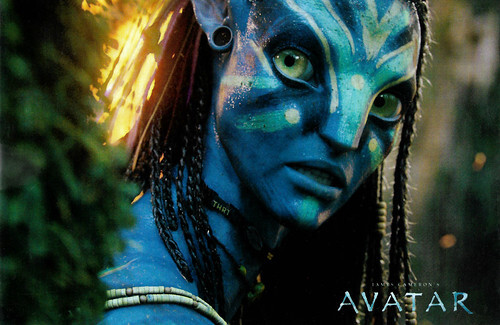
Chinese postcard by Oriental City Publishing Group Limited. Image of Avatar (James Cameron, 2009).
Sources: Jeremy Wheeler (AllMovie), Roger Ebert (RogerEbert.com), Wikipedia (Dutch), and IMDb.

Chinese postcard by Oriental City Publishing Group Limited. Sam Worthington in Avatar (James Cameron, 2009).

Chinese postcard by Oriental City Publishing Group Limited. Image of Avatar (James Cameron, 2009).
A precious mineral called unobtanium
Avatar (2009) is situated in 2154 on the fictional moon Pandora of the planet Polyphemus orbiting the star Alpha Centauri A. An Earth mining company, led by Parker Selfridge (Giovanni Ribisi), has a branch on Pandora to mine a precious mineral, unobtanium. For the interstellar space journey to and from Earth, fast spaceships are used that cover the four light-years in six years.
Moreover, people are transported in a frozen state, so the journey seems to be very short. On Pandora, there is an indigenous population of humanoid beings, the Na'vi. They are intelligent like humans but technologically less advanced. They walk on two legs like humans, are 10 feet tall, slender, agile, with a tail and skin with a zebra pattern of light and dark blue.
People have developed a technique to create a being that is a genetic hybrid between a particular human and the Na'vi, its so-called avatar. The human being can be mentally wirelessly connected to his/her avatar through equipment so that he/she can control it, and can see and feel through the avatar while his/her own body sleeps. When the avatar is sleeping the connection can be broken so that the driver can eat and report.
Through the avatars people can more easily make contact with the Na'vi, moreover, the avatar does not have to wear an oxygen mask as people do on Pandora. Sam Worthington plays Jake Sully, a paraplegic Marine who is dispatched to Pandora on a secret mission. There he learns of greedy corporate figurehead Selfridge's intentions of driving off the native Na'vi in order to mine for the precious unobtanium scattered throughout their rich woodland.
In exchange for the spinal surgery that will fix his legs, Jake gathers knowledge, of the Indigenous Race and their Culture, for the cooperating military unit spearheaded by gung-ho Colonel Quaritch (Stephen Lang), while simultaneously attempting to infiltrate the Na'vi people with the use of an avatar identity. While Jake begins to bond with the native tribe and quickly falls in love with the beautiful alien Neytiri (Zoe Saldana), the restless Colonel moves forward with his ruthless extermination tactics. Jake becomes torn between following his orders and protecting the world he feels now is his home.

Chinese postcard by Oriental City Publishing Group Limited. Image of Avatar (James Cameron, 2009).

Chinese postcard by Oriental City Publishing Group Limited. Image of Avatar (James Cameron, 2009).
A revolutionary motion-capture system
Avatar (2009) was the first major film production that James Cameron directed after his big success, Titanic (1997). Avatar is a large-scale, ambitious Science-Fiction film that uses many new techniques. The film consists partly of computer-generated objects, such as the Na'vi and avatars, for which motion capture was used.
This revolutionary motion-capture system allows the facial expressions of actors to be captured as a virtual camera system enables them to see what their computer-generated counterparts will be seeing in the film. The New Zealand company Weta Digital, known for Peter Jackson's The Lord of the Rings, produced extensive computer animation and effects. Cameron was given a budget of US$195 million by 20th Century Fox for the project, but this amount has been further increased.
The film was shot in 3D using two high-definition cameras in one housing, creating depth. Circularly polarised glasses are used in the screening, but the film has also been released in 2D. Just as for Titanic, Cameron selected young, relatively unknown but, according to him, talented actors, such as Sam Worthington. The music for the film was composed by James Horner, just as for Cameron's earlier films Aliens (1986) and Titanic (1997).
Cameron had wanted to make the film earlier. As early as 1995, he wrote an 80-page script for Avatar. In August 1996, Cameron announced that he would start working on Avatar immediately after Titanic. The plans were already at an advanced stage; six actors would play the leading roles, the budget would be 100 million dollars and Digital Domain would produce the special effects. This original plan did not go ahead, because it appeared that the technology was not yet so advanced.
The premiere date of Avatar was postponed again and again in 2006, originally it was 2007, later 2008, and finally 2009. Avatar (2009) became a massive hit worldwide and received three Oscars, for Best Cinematography - Mauro Fiore, for Best Art Direction - Rick Carter, Robert Stromberg, Kim Sinclair, and for Best Visual Effects - Joe Letteri, Stephen Rosenbaum, Richard Baneham, Andy Jones.
Jeremy Wheeler at AllMovie: "Sometimes a film comes along that pushes the boundaries of what moviemaking can yield - the kind of movie that reaches beyond the limits of the medium and blazes a new trail, subsequently allowing others with abundant resources to follow in its path. Despite any nitpicky flaws one might - or might not - find within the picture, James Cameron's Avatar is absolutely this kind of touchstone."
Roger Ebert: "At 163 minutes, the film doesn't feel too long. It contains so much. The human stories. The Na'vi stories, for the Na'vi are also developed as individuals. The complexity of the planet, which harbors a global secret. The ultimate warfare, with Jake joining the resistance against his former comrades. Small graceful details like a floating creature that looks like a cross between a blowing dandelion seed and a drifting jellyfish, and embodies goodness. Or astonishing floating cloud-islands."
James Cameron is working on several sequels to Avatar. The first sequel, Avatar 2, has already been postponed many times, but according to IMDb , it will be released in cinemas on 16 December 2022. Jake Sully (Sam Worthington) lives with his newfound family formed on the planet of Pandora. Once a familiar threat returns to finish what was previously started, Jake must work with Neytiri and the army of the Na'vi race to protect their planet. The cast will include Kate Winslet , Michelle Yeoh, and Sigourney Weaver.

Chinese postcard by Oriental City Publishing Group Limited. Image of Avatar (James Cameron, 2009).

Chinese postcard by Oriental City Publishing Group Limited. Image of Avatar (James Cameron, 2009).

Chinese postcard by Oriental City Publishing Group Limited. Image of Avatar (James Cameron, 2009).
Sources: Jeremy Wheeler (AllMovie), Roger Ebert (RogerEbert.com), Wikipedia (Dutch), and IMDb.
Published on February 22, 2022 22:00
February 21, 2022
Frankie Avalon
During the late 1950s, American singer and actor Frankie Avalon (1940) was a teen idol with big hits like 'Venus' (1958) and 'Why' (1959). Avalon had an authentic music background to go with the pretty boy looks. During the 1960s, he starred in five beach party movies and several other films. Avalon made a glorious come-back with Grease (1977).
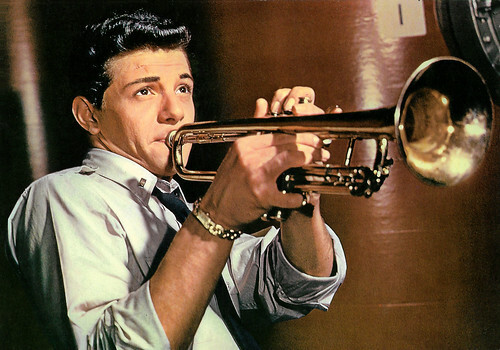
Spanish postcard by Oscarcolor, no. 360. Frankie Avalon on the set of Voyage to the Bottom of the Sea (Irwin Allen, 1961).
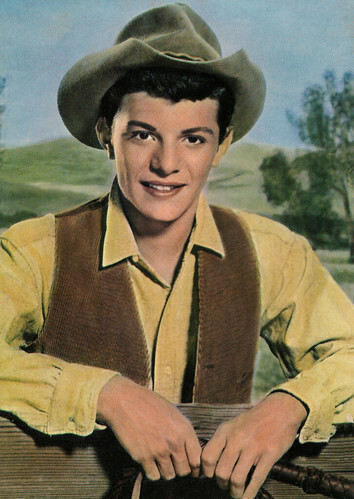
West-German postcard by ISV, no. H 77.
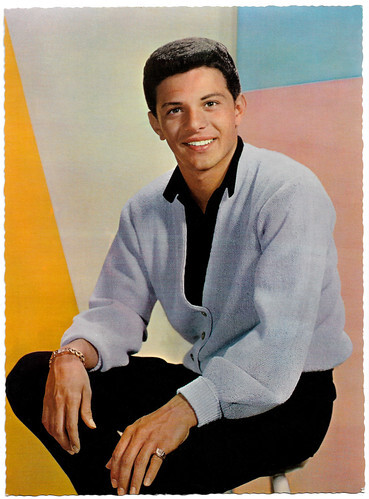
Big Dutch postcard, no. 618.
A piece of teen fluff
Frankie Avalon was born Francis Thomas Avallone in Philadelphia, Pennsylvania, in 1940. His parents were Nicholas and Mary Avallone. Inspired by his father's trumpet playing, he started to get involved with music at an early age. At the CR Club in Philadelphia, where parents were offered the opportunity to let their children perform, Frankie presented his musical skills for the first time with trumpet solos.
Performances in local talent shows followed and he won an amateur competition. The 12-years-old Frankie finally landed a spot on CBS's nationally syndicated 'The Jackie Gleason Show' in 1952. In 1954, he became a member of the dance band 'Rocco and the Saints', which participated in many local events and performed at youth clubs. One of the other members was drummer Robert Ridarelli, soon to call himself Bobby Rydell.
In 1957, the record company Chancellor Records was founded in Philadelphia. One of the owners, Bob Marcucci, knew Frankie Avalon and helped him get a recording contract with the new company. Avalon and the Saints did a cameo in the rock and roll film Jamboree! (Roy Lockwood, 1957)) where they played 'Teacher's Pet'. Frankie's first single only attracted attention in his hometown, but 'De De Dinah' of his third Chancellor single, released in December 1957, became Avalon's national breakthrough.
A piece of teen fluff, Avalon pinched his nose while singing the song to show how he felt about it. This nasal version was the one Chancellor released and Avalon performed the song on 'American Bandstand', a teen dance show hosted by Dick Clark. 'De De Dinah' soon sold a million copies. In the late 1950s, he became an idol for many teenage girls. In 1959, both his songs 'Venus' and Why reached the number 1 position in the Billboard Hot 100.
By 1962, almost all of his singles were on the charts. In total, he reached the Hot 100 of the US music magazine Billboard 25 times. He also made foreign charts with 'Venus' and 'Why'. As a result of the British Invasion, interest in the now 23-year-old, whose music was always targeted at the teenage audience, waned. In 1963, Frankie Avalon changed record companies and moved to United Artists Records, a subsidiary of the film studio United Artists.
However, he remained as unsuccessful as he did thereafter with a number of other companies. He only attracted attention on the record market again in 1976 with the disco version of 'Venus'. His last single, 'You're the Miracle' (1983), was released on the CBS Bobcat label. After that, he successfully toured America with his old colleagues Bobby Rydell and Fabian as 'The Golden Boys of Bandstand'. Their fifty-city tour was a huge success.
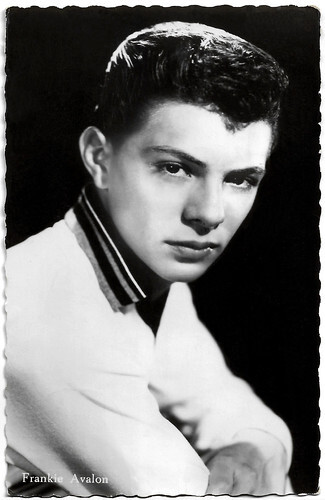
Dutch postcard. Sent by mail in 1963.
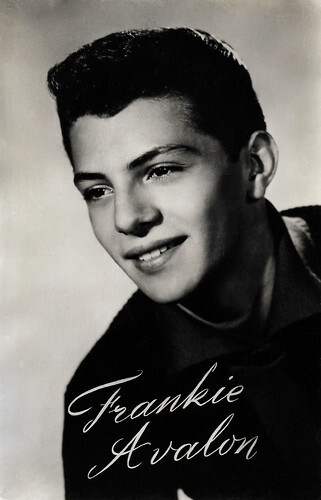
Dutch postcard by Uitg. Takken, Utrecht, no. AX 4177. Caption: Read 'Song Parade'.
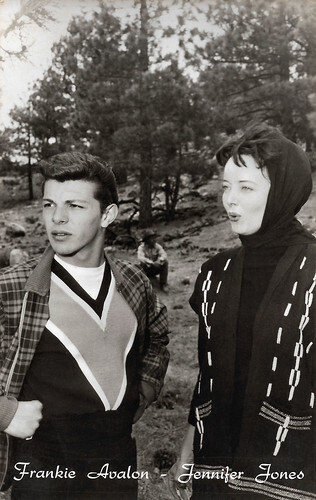
Dutch postcard by Drukkerij-Uitgeverij Int. Filmpers, Amsterdam (I.F.P.), no. 3189. Photo: Warner Bros. Photo: Frankie Avalon and Carolyn Jones (and not Jennifer Jones) on the set of Guns of the Timberland (Robert D. Webb, 1960).
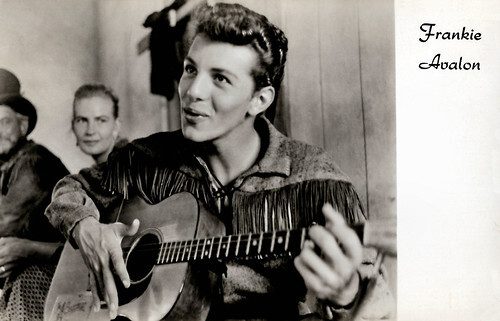
Dutch postcard by Gebr. Spanjersberg N.V., Rotterdam, no. 5691. Sent by mail in 1962. Frankie Avalon in The Alamo (John Wayne, 1960).
A nationwide surfing craze
Frankie Avalon turned increasingly to the cinema in the 1960s. In the late 1950s, teen idols were often given roles in films, supporting older male stars in order to attract a younger audience. Alan Ladd 's daughter was a Frankie Avalon fan, who recommended that he co-star with her father in the Western Guns of the Timberland (Robert D. Webb, 1960). Avalon sang two songs, 'The Faithful Kind' and 'Gee Whiz Whillikins Golly Gee'; both were released as singles.
Frankie also had a supporting role in the John Wayne Western The Alamo (John Wayne, 1960), where he also sings 'Ballad of the Alamo'. He then appeared and sang the title song in the Sci-Fi adventure Voyage to the Bottom of the Sea (Irwin Allen, 1961). His first major film role was in an adventure film set in Africa, Drums of Africa (James B. Clark, 1963).
In the early sixties, there was a nationwide surfing craze and Avalon and Annette Funicello were the leading stars in the wildly successful Beach Party (William Asher, 1963). It was the first of the five official American-International 'Beach Party' surfer movies, directed by William Asher and written by Lou Rusoff.
Soon followed Bikini Beach (William Asher, 1964), Muscle Beach (William Asher, 1964), Beach Blanket Bingo (William Asher, 1965), and How to stuff a wild bikini (William Asher, 1965). Frankie also starred in Skidoo (Otto Preminger, 1968) and The Million Eyes of Sumuru (Lindsay Shonteff, 1967).
Later he invested in the 1950s-themed stage musical 'Grease', which reportedly made him a millionaire. In the film version, Grease (Randal Kleiser, 1978), starring John Travolta and Olivia Newton-John, he took on a small role himself and performed the song 'Beauty School Dropout'.
In 1986, Avalon and Funicello made another film, Back to the Beach (Lyndall Hobbs, 1987), a parody of their earlier beach movies. Avalon appeared in nearly two dozen TV episodes, including The Bing Crosby Show, The Patty Duke Show, and Full House, appearing often as himself. In 1990 he made a cameo as himself in the film Casino (Martin Scorsese, 1995), starring Robert De Niro and Sharon Stone .
He made further cameo appearances in the film Chicks (James Melkonian, 1994) and in the TV series Sabrina the teenage witch (2001). In the meantime, as the owner of the health and beauty care line Frankie Avalon Products, he made a considerable fortune. His most recent film is Papa (Dan Israely, 2018). Frankie Avalon lives in Thousand Oaks with his wife Kathryn Utices Deibel. The couple has eight children.
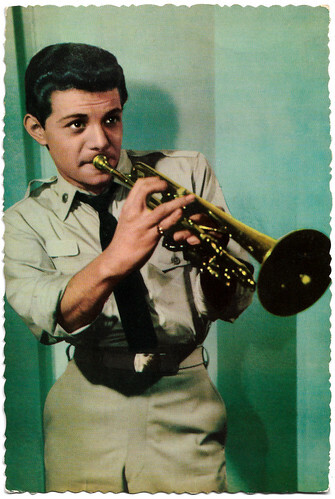
Spanish postcard by Archivo Bermejo, no. C-94, 1963. Photo: 20th Century Fox. Frankie Avalon on the set of Voyage to the Bottom of the Sea (Irwin Allen, 1961).
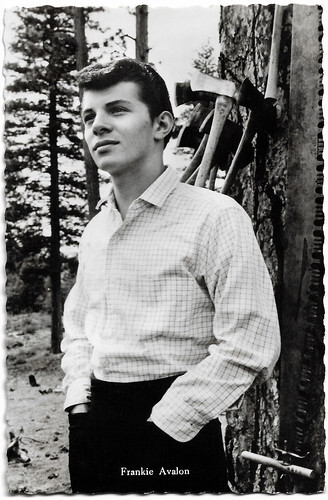
Dutch postcard. Sent by mail in 1962.
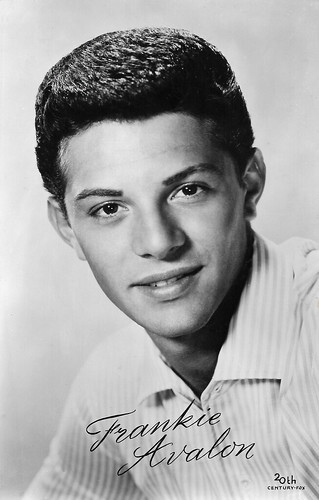
Dutch postcard by Muziek Parade, Hilversum. Photo: 20th Century Fox.
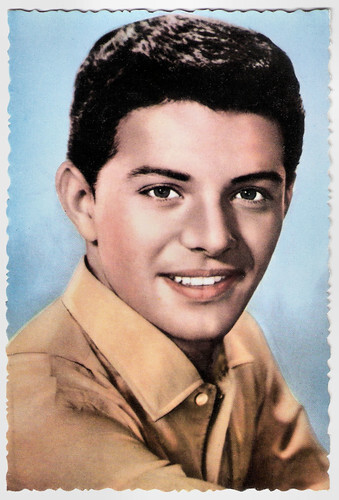
Spanish postcard by Raker, no. 1014.
Sources: History of Rock, Biography.com, Wikipedia (Dutch, German and English), and .

Spanish postcard by Oscarcolor, no. 360. Frankie Avalon on the set of Voyage to the Bottom of the Sea (Irwin Allen, 1961).

West-German postcard by ISV, no. H 77.

Big Dutch postcard, no. 618.
A piece of teen fluff
Frankie Avalon was born Francis Thomas Avallone in Philadelphia, Pennsylvania, in 1940. His parents were Nicholas and Mary Avallone. Inspired by his father's trumpet playing, he started to get involved with music at an early age. At the CR Club in Philadelphia, where parents were offered the opportunity to let their children perform, Frankie presented his musical skills for the first time with trumpet solos.
Performances in local talent shows followed and he won an amateur competition. The 12-years-old Frankie finally landed a spot on CBS's nationally syndicated 'The Jackie Gleason Show' in 1952. In 1954, he became a member of the dance band 'Rocco and the Saints', which participated in many local events and performed at youth clubs. One of the other members was drummer Robert Ridarelli, soon to call himself Bobby Rydell.
In 1957, the record company Chancellor Records was founded in Philadelphia. One of the owners, Bob Marcucci, knew Frankie Avalon and helped him get a recording contract with the new company. Avalon and the Saints did a cameo in the rock and roll film Jamboree! (Roy Lockwood, 1957)) where they played 'Teacher's Pet'. Frankie's first single only attracted attention in his hometown, but 'De De Dinah' of his third Chancellor single, released in December 1957, became Avalon's national breakthrough.
A piece of teen fluff, Avalon pinched his nose while singing the song to show how he felt about it. This nasal version was the one Chancellor released and Avalon performed the song on 'American Bandstand', a teen dance show hosted by Dick Clark. 'De De Dinah' soon sold a million copies. In the late 1950s, he became an idol for many teenage girls. In 1959, both his songs 'Venus' and Why reached the number 1 position in the Billboard Hot 100.
By 1962, almost all of his singles were on the charts. In total, he reached the Hot 100 of the US music magazine Billboard 25 times. He also made foreign charts with 'Venus' and 'Why'. As a result of the British Invasion, interest in the now 23-year-old, whose music was always targeted at the teenage audience, waned. In 1963, Frankie Avalon changed record companies and moved to United Artists Records, a subsidiary of the film studio United Artists.
However, he remained as unsuccessful as he did thereafter with a number of other companies. He only attracted attention on the record market again in 1976 with the disco version of 'Venus'. His last single, 'You're the Miracle' (1983), was released on the CBS Bobcat label. After that, he successfully toured America with his old colleagues Bobby Rydell and Fabian as 'The Golden Boys of Bandstand'. Their fifty-city tour was a huge success.

Dutch postcard. Sent by mail in 1963.

Dutch postcard by Uitg. Takken, Utrecht, no. AX 4177. Caption: Read 'Song Parade'.

Dutch postcard by Drukkerij-Uitgeverij Int. Filmpers, Amsterdam (I.F.P.), no. 3189. Photo: Warner Bros. Photo: Frankie Avalon and Carolyn Jones (and not Jennifer Jones) on the set of Guns of the Timberland (Robert D. Webb, 1960).

Dutch postcard by Gebr. Spanjersberg N.V., Rotterdam, no. 5691. Sent by mail in 1962. Frankie Avalon in The Alamo (John Wayne, 1960).
A nationwide surfing craze
Frankie Avalon turned increasingly to the cinema in the 1960s. In the late 1950s, teen idols were often given roles in films, supporting older male stars in order to attract a younger audience. Alan Ladd 's daughter was a Frankie Avalon fan, who recommended that he co-star with her father in the Western Guns of the Timberland (Robert D. Webb, 1960). Avalon sang two songs, 'The Faithful Kind' and 'Gee Whiz Whillikins Golly Gee'; both were released as singles.
Frankie also had a supporting role in the John Wayne Western The Alamo (John Wayne, 1960), where he also sings 'Ballad of the Alamo'. He then appeared and sang the title song in the Sci-Fi adventure Voyage to the Bottom of the Sea (Irwin Allen, 1961). His first major film role was in an adventure film set in Africa, Drums of Africa (James B. Clark, 1963).
In the early sixties, there was a nationwide surfing craze and Avalon and Annette Funicello were the leading stars in the wildly successful Beach Party (William Asher, 1963). It was the first of the five official American-International 'Beach Party' surfer movies, directed by William Asher and written by Lou Rusoff.
Soon followed Bikini Beach (William Asher, 1964), Muscle Beach (William Asher, 1964), Beach Blanket Bingo (William Asher, 1965), and How to stuff a wild bikini (William Asher, 1965). Frankie also starred in Skidoo (Otto Preminger, 1968) and The Million Eyes of Sumuru (Lindsay Shonteff, 1967).
Later he invested in the 1950s-themed stage musical 'Grease', which reportedly made him a millionaire. In the film version, Grease (Randal Kleiser, 1978), starring John Travolta and Olivia Newton-John, he took on a small role himself and performed the song 'Beauty School Dropout'.
In 1986, Avalon and Funicello made another film, Back to the Beach (Lyndall Hobbs, 1987), a parody of their earlier beach movies. Avalon appeared in nearly two dozen TV episodes, including The Bing Crosby Show, The Patty Duke Show, and Full House, appearing often as himself. In 1990 he made a cameo as himself in the film Casino (Martin Scorsese, 1995), starring Robert De Niro and Sharon Stone .
He made further cameo appearances in the film Chicks (James Melkonian, 1994) and in the TV series Sabrina the teenage witch (2001). In the meantime, as the owner of the health and beauty care line Frankie Avalon Products, he made a considerable fortune. His most recent film is Papa (Dan Israely, 2018). Frankie Avalon lives in Thousand Oaks with his wife Kathryn Utices Deibel. The couple has eight children.

Spanish postcard by Archivo Bermejo, no. C-94, 1963. Photo: 20th Century Fox. Frankie Avalon on the set of Voyage to the Bottom of the Sea (Irwin Allen, 1961).

Dutch postcard. Sent by mail in 1962.

Dutch postcard by Muziek Parade, Hilversum. Photo: 20th Century Fox.

Spanish postcard by Raker, no. 1014.
Sources: History of Rock, Biography.com, Wikipedia (Dutch, German and English), and .
Published on February 21, 2022 22:00
February 20, 2022
Martine Carol
One of the French cinema's most beautiful women was Martine Carol (1920-1967). During the early 1950s, the French sex symbol was a top box office draw as an elegant blonde seductress in many films and was often compared to Marilyn Monroe. Her private life was filled with turmoil including a suicide attempt, drug abuse, a kidnapping, and her mysterious death at only 46.
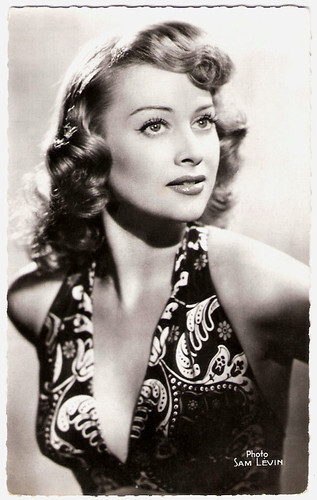
French postcard by Editions du Globe (E.D.U.G.), Paris, no. 132. Photo: Sam Lévin.
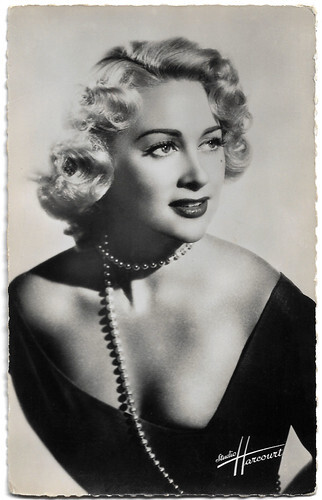
French postcard by Editions du Globe (E.D.U.G.), Paris, no. 162. Photo: Studio Harcourt.
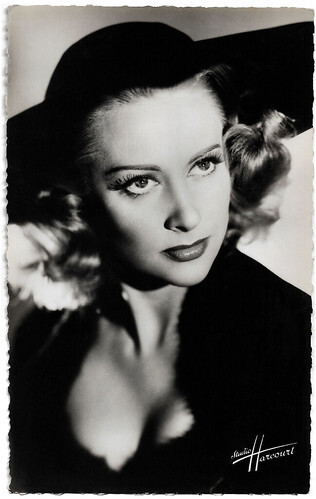
French postcard by Editions du Globe (E.D.U.G.), Paris, no. 222. Photo: Studio Harcourt.
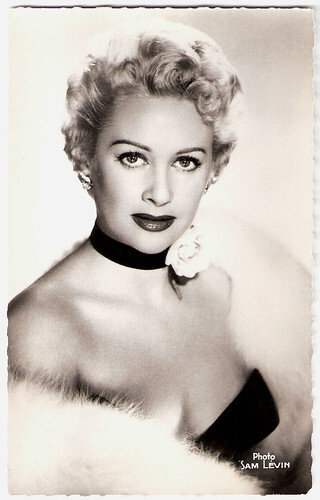
French postcard by Edition du Globe (E.D.U.G.), Paris, no. 320. Photo: Sam Lévin.
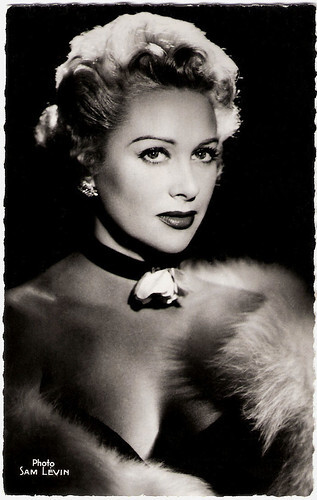
French postcard by Edition du Globe (E.D.U.G.), Paris, no. 321. Photo: Sam Lévin.
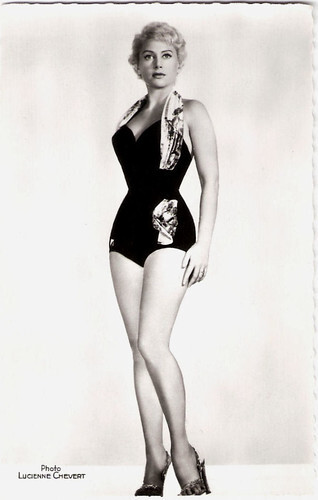
French postcard by Editions du Globe (E.D.U.G.), Paris, no. 357. Photo: Lucienne Chevert.
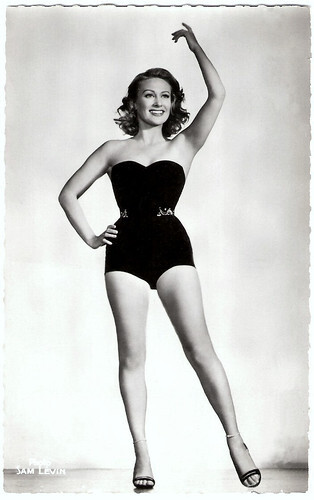
French postcard by Editions du Globe (E.D.U.G.), Paris, no. 432. Photo: Sam Lévin.
Anti-semitic propaganda
Martine Carol was born in 1920 as Marie Louise Jeanne Nicolle Mourer in Saint-Mandé, near Paris. 'Maryse' was the daughter of the freight forwarder Marcel Mourer and his wife (maiden name: Arley). She attended the Dominican School of Neuilly. Later Maryse studied at the École des Beaux-Arts in Paris and then earned a living as a model.
A chance meeting with comedian André Luguet steered her toward a career in the theatre. Carol joined the theatre company led by Gaston Baty, where she received acting lessons from Robert Manuel and later from René Clair and Jean Wall. She adopted the stage name Maryse Arley (after her mother's name) and made her 1940 stage debut with 'Phèdre' by Jean Racine. She appeared at the Théâtre de la Renaissance and Théâtre Montparnasse in Paris in plays such as 'La Route du tabac' (Tobacco Road) after Erskine Caldwell alongside Marcel Mouloudji , Alfred de Musset's 'Les Caprices de Marianne' and William Shakespeare's 'The Taming of the Shrew'. She also attended the acting classes of René Simon.
She made her first film appearances during the Occupation. She caught the eye of film director Henri-Georges Clouzot who hired her for his film Le Chat/The Cat, based on the novel by Colette , but the project was scrapped. In 1941, she appeared in a bit role alongside Pierre Fresnay and Jean Tissier in Le Dernier des six/The Last One of the Six (Georges Lacombe, 1941), which was based on a screenplay by Clouzot.
Like many French actors, she played in films financed by the German company Continental, directed by Alfred Greven. Carol appeared for Continental in Les Inconnus dans la maison/Strangers in the House (Henri Decoin, 1942), with Raimu , and in an openly anti-Semitic and anti-American propaganda film, the short Les Corrupteurs/The (Pierre Ramelot, 1942).
She first attracted attention in La ferme aux loups/Wolf Farm (Richard Pottier, 1943), which takes advantage of her photogenic beauty and ease in front of the camera despite a limited acting ability. Her co-actor François Périer invented her stage name Martine Carol as a tribute to Carole Lombard .
Carol was kidnapped by gangster Pierre Loutrel aka ‘Pierrot le Fou' (Crazy Pete), who tried to rape her in the Bois de Boulogne and afterwards sent her flowers and steaks (!) to apologise. After the liberation, she took a blonde haircut so that she looked even more like her idol Lana Turner . She was held captive, almost literally, by a new lover, John Ringling North of the Barnum Circus, but she escaped his golden cage.
In 1947 a torrid affair with handsome actor Georges Marchal , who was married to actress Dany Robin at the time, ended disastrously and she attempted suicide by taking an alcohol/drug overdose and throwing herself off a bridge into the Seine River. She was saved by a taxi driver who accompanied her there. Ironically, the unhappy details surrounding her suicide attempt renewed the fascination audiences had with Martine up until that time.
Throughout the 1940s, Martine Carol was a pin-up goddess and supporting actress in films like the comedy Voyage surprise/The Bride's Surprise (Pierre Prévert, 1947) and Les amants de Vérone/The Lovers of Verona (André Cayatte, 1949). She also appeared on the stage of the Theatre of the Renaissance. In 1949, she married Steve Crane, Lana Turner 's former husband and nicknamed "Mister Gigolo". She was obsessed with her appearance: she even had a new nose fitted by the legendary Dr. Claoué ("Le nez Claoué, le nez chic de la vraie Parisienne") to better resemble Turner. She lost a child in a water-skiing accident when she wanted to see the wedding of Rita Hayworth and Aga Kahn "from afar", as she was not invited.
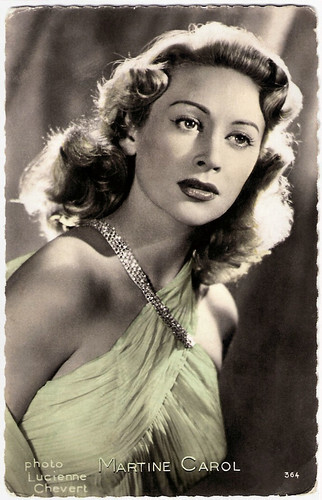
French postcard by Editions P.I., Paris, no. 364. Photo: Lucienne Chevert.
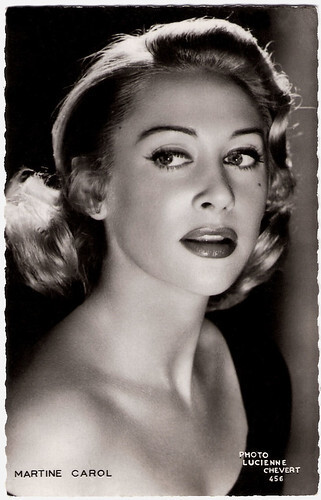
French postcard by Editions P.I., Paris, no. 456. Photo: Lucienne Chevert.
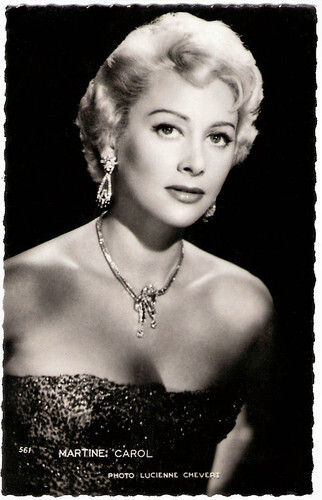
French postcard by Editions P.I., Paris, no. 561. Photo: Lucienne Chevert.
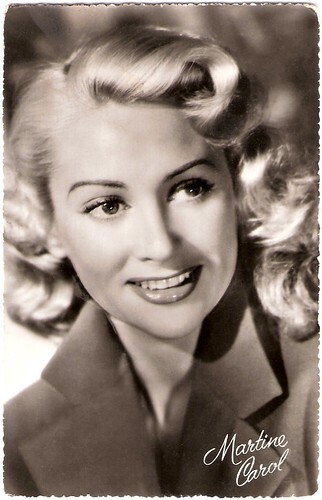
Dutch postcard by DRC, no. F192-657, posted in 1958.
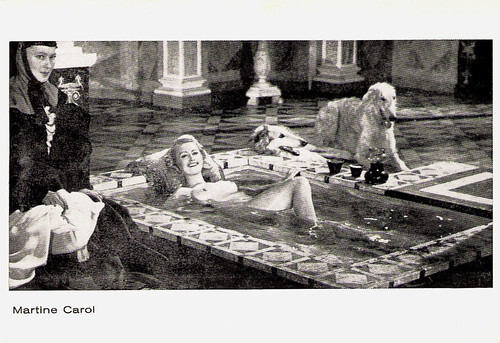
Vintage card. Photo: still for Lucrèce Borgia/Lucretia Borgia (Christian-Jaque, 1953).
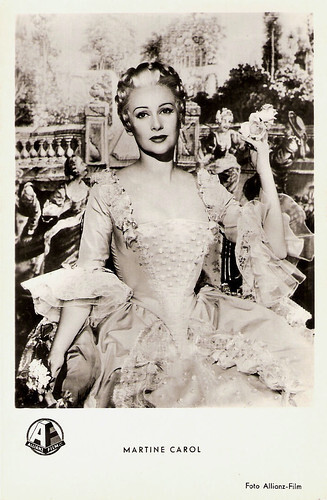
German postcard by Kunst und Bild. Berlin, no. A 1146. Photo: Allianz-Film. Publicity still for Madame du Barry/Madame Dubarry (Christian Jacque, 1954).
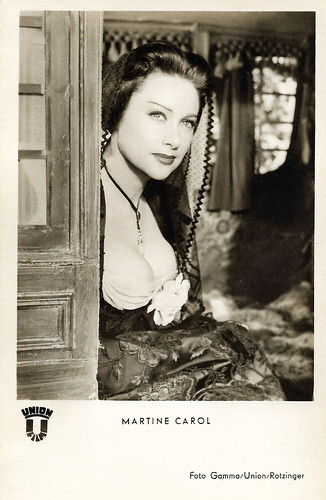
West-German postcard by Kunst und Bild, Berlin, no. V 357. Photo: Gamma / Union / Rotzinger. Martine Carol in Lola Montès/Lola Montez (Max Ophüls, 1955).
Taunting, Kittenish Sexuality
In 1950 Martine Carol scored her first huge film success with the historical epic Caroline Cherie/Dear Caroline (Richard Pottier, 1950) - no doubt prompted by her nude scene, six years before Brigitte Bardot . The film was adapted from the popular novels of Cécil Saint-Laurent. Carol played a young aristocrat during the French Revolution who loves one man, but who, to save her life, often has to sacrifice her virtue and lend her body, which, however, does not always displease her. Martine Carol was off and running at the box office.
Caroline Cherie/Dear Caroline was a great public success: attracting 3.6 million spectators, it ranked ninth at the French box office for the year 1951. France had a new sex symbol. Two years later, filmmaker Jean Devaivre made a sequel, Un caprice de Caroline Chérie/Caroline Cherie (1952), in which Carol again displayed her taunting, kittenish sexuality. The sequel was also a great success with 2.8 million viewers.
The next important step in Carol's career was her meeting in 1952 with the much older filmmaker Christian-Jaque, who called on her for Adorables créatures/Adorable Creatures (Christian-Jaque, 1952), a comedy in which Daniel Gélin recalls all his conquests. It was love at first sight between Christian-Jaque and Carol. And the film was well received.
The couple continued spectacularly with costumed teasers such as Lucrèce Borgia/Sins of the Borgias (1953), Madame du Barry (1954), and the Emile Zola adaptation Nana (1954), all directed by Christian-Jacque who became her second husband in 1954. These starring roles made her France's equivalent of Marilyn Monroe . Her film romps were also typically done tastefully with an erotic twinge of innocence and gentle sexuality plus an occasional bubble bath thrown in as male bait.
Martine later divorced the director due to professional conflicts and long separations. She also starred in Belles de Nuit/ Beauties of the Night (René Clair, 1952) opposite Gérard Philipe , and in the last comedy directed by Preston Sturges, Les Carnets du Major Thompson/The Diary of Major Thompson (1955), based on the best-seller by Pierre Daninos.
One of her last major roles was as the title character in Lola Montés/Lola Montez (Max Ophüls, 1955), the tragic and true story of the great adventurer, circus attraction, and lover of various important men. Finally, she was taken seriously by the film critics. The story of the end of life of the fallen and impoverished courtesan Lola Montès, however, did not appeal to the public. Later, the work nevertheless became a classic of French cinema.
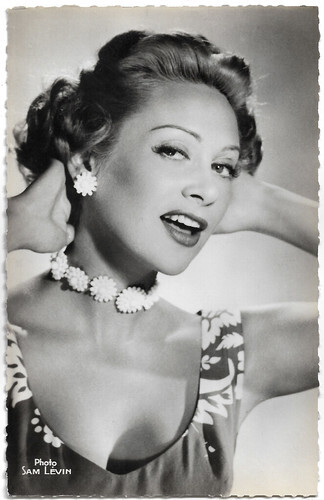
French postcard by Editions du Globe (E.D.U.G.), Paris, no. 365. Photo: Sam Lévin.
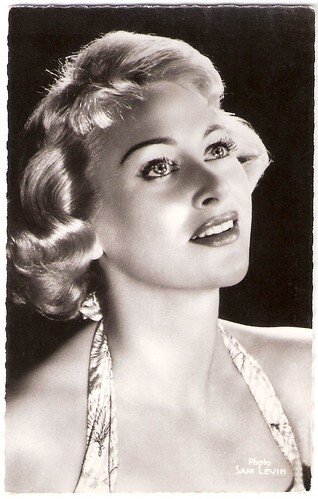
French postcard by Editions du Globe (E.D.U.G.), Paris, no. 564. Photo: Sam Lévin.
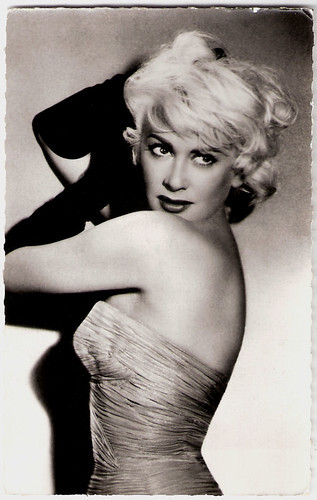
French postcard by Editions du Globe (E.D.U.G.), Paris, no. 690. Photo: Sam Lévin.
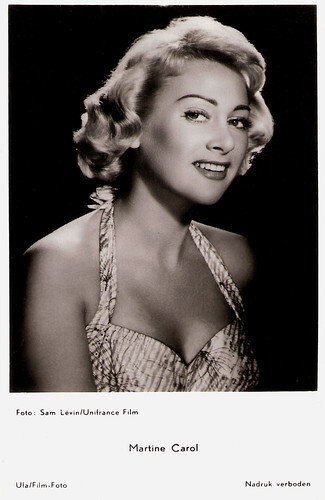
Dutch postcard by Gebr. Spanjersberg N.V., Rotterdam (Dutch licency holder for Ufa/Film-Foto, Berlin-Tempelhof), no. 3611. Photo: Sam Lévin / Unifrance Film.
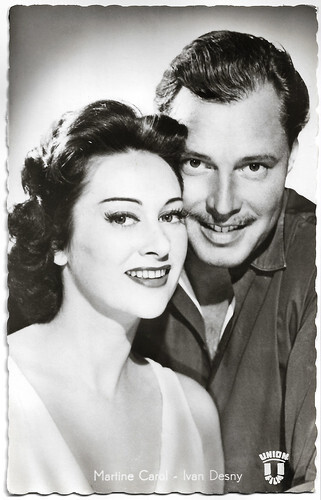
German postcard by Kolibri-Verlag G.m.b.H. Minden/Westf., no. 1719. Photo: Gamma / Union / Vogelmann. Publicity still for Lola Montès (Max Ophüls, 1955) with Ivan Desny .
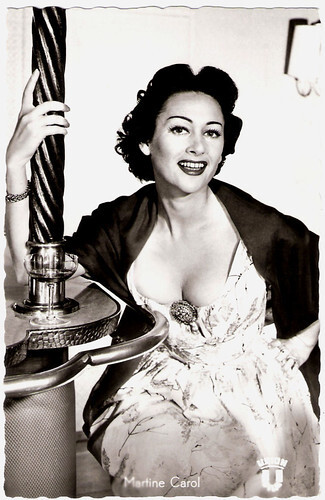
German postcard by Kolibri-Verlag, Minden-Westf., no. 1723. Photo: Gamma / Union / Vogelmann. Publicity still for Lola Montès (Max Ophüls, 1955).
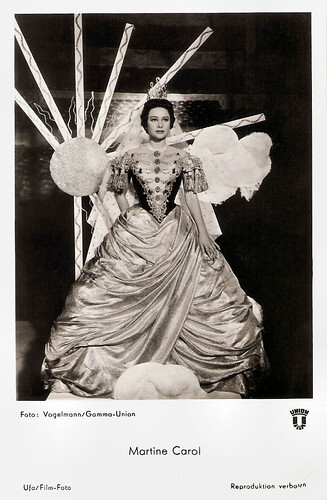
West-German postcard by Ufa/Film-Foto, Berlin-Tempelhof, no. FK 2160. Photo: Vogelmann / Gamma / Union. Martine Carol in Lola Montez (Max Ophüls, 1955).
Severe Decline
By the mid-1950s, Brigitte Bardot had replaced Martine Carol as the national Sex Siren, and the voluptuous blonde's career went into a severe decline. In the crime comedy Nathalie (Christian-Jaque, 1957), she played a coquettish, clever haute couture mannequin, a role that was made for her. This last film with Christian-Jaque still made the film box-office ring, although the film had to do with much less budget than usual. That limited budget was the direct consequence of Carol's decreased prestige due to the Lola Montès fiasco.
In 1960, she successfully played Joséphine de Beauharnais, Napoleon's first wife, in the historical fresco Austerlitz/The Battle of Austerlitz (Abel Gance, 1960). In the next two years, she worked several more times with classically trained filmmakers such as Georges Lautner and Gilles Grangier. Grangier engaged her for his police comedy Le cave se rebiffe/The Counterfeiters (Gilles Grangier, 1961) at the intercession of Jean Gabin , who had fond memories of his collaboration with Carol in Miroir/Mirror (Raymond Lamy, 1947). Le cave se rebiffe was her last commercial success.
Her last significant role was as Contessa Vitelleschi who supports a young revolutionary on the run from government troops in Roberto Rossellini's historical drama Vanina Vanini/The Betrayer (1961) with Laurent Terzieff . This mature role did not revive the audience's interest. Depressed, she turned alarmingly reclusive while a third marriage to French doctor Andre Rouveix also soured by 1962. She sought refuge in alcohol and narcotics and followed impossible slimming regimes. For five years she stayed away from the big screen.
She returned in the little-seen Italian production Lasciapassare per l'inferno/Passport to hell (George Fuller, 1966) opposite Guy Madison and Klaus Kinski . Her last film was Hell Is Empty (John Ainsworth, Bernard Knowles, 1967). Production was briefly halted due to her illness. This is why the film had two directors. Although filmed in 1963 it was not released until 1967. By the time of the release of the film, two of the leading ladies, Patricia Viterbo and Martine, were already dead.
Martine Carol’s last marriage to fourth husband Mike Eland, an English businessman, had seemed hopeful. Eland was a friend of her first husband, Steve Crane, and had been in love with her for a long time. Eland tried to put her luxury life and career back on track but in 1967, he found her dead in the bathroom of her room in the Hotel de Paris in Monaco.
Martine Carol died of a heart attack. She was only 46. Newspapers hinted at a possible drug overdose but nothing was ever proven. She was initially buried in the Père Lachaise Cemetery of Paris. But her grave was violated - some media reported that she had been interred with her jewels. Martine Carol was then buried in the Grand Jas Cemetery of Cannes.
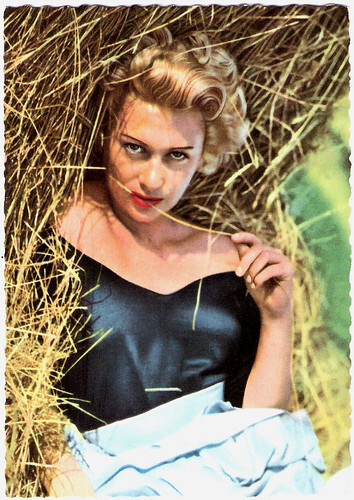
German postcard by Universum-Film Aktiengesellschaft, Berlin-Tempelhof, no. CK-2. Retail price: 30 Pfg. Photo: Gérard Décaux / Ufa.
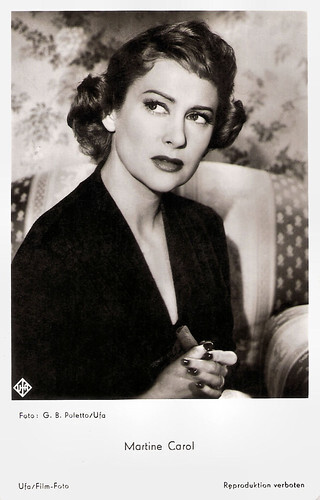
West-German postcard by Ufa/Film-Foto, Berlin-Tempelhof, no. FK 3478. Photo: G.B. Poletto / Ufa.
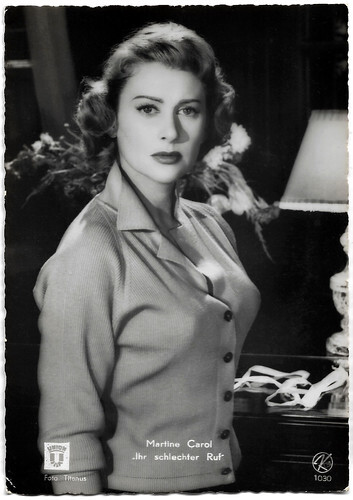
Austrian postcard by Kellner Fotokarten, Wien, no. 1030. Photo: Titanus / Union. Martine Carol in Difendo il mio amore/Defend My Love (Giulio Macchi, 1957).
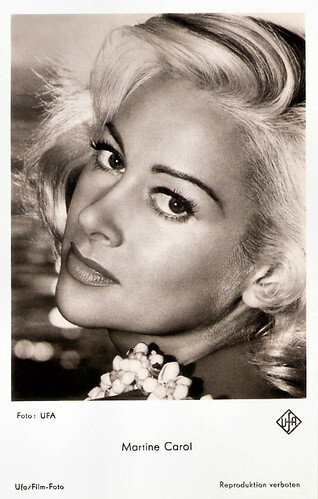
West-German postcard by Ufa/Film-Foto, Berlin-Tempelhof, no. FK 4064. Retail price: 25 Pfg. Photo: Ufa. Publicity still for The Stowaway (Ralph Habib, Lee Robinson, 1958).
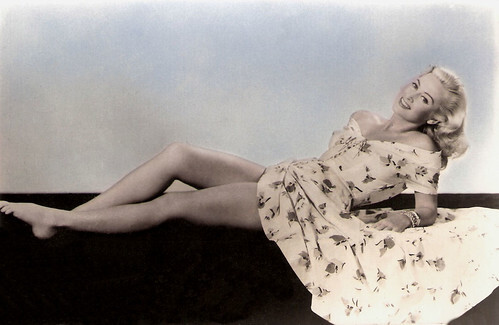
Yugoslavian postcard by Studio Sombor, no. 314.
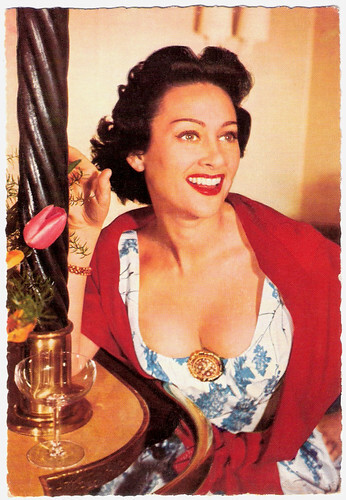
German postcard by WS-Druck, Wanne-Eickel, no. F 5. Photo: Collignon. Publicity still for Lola Montès (Max Ophüls, 1955).
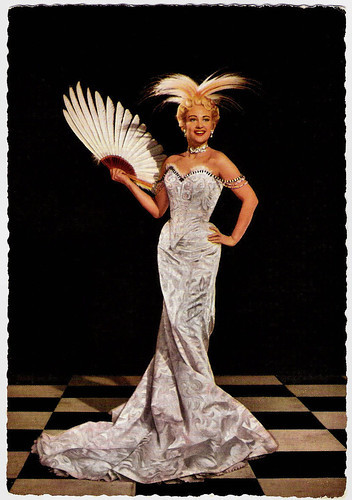
German postcard by Ufa, Berlin-Tempelhof, no. 58. Retail price: 50 Pfg. Photo: G.B. Poletto / Ufa.
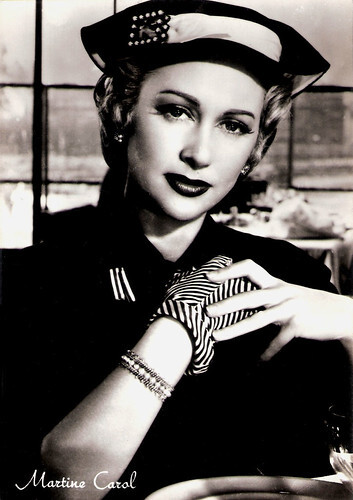
Italian postcard by Rotalfoto, Milano, no. 267. Photo: Cei Incom.
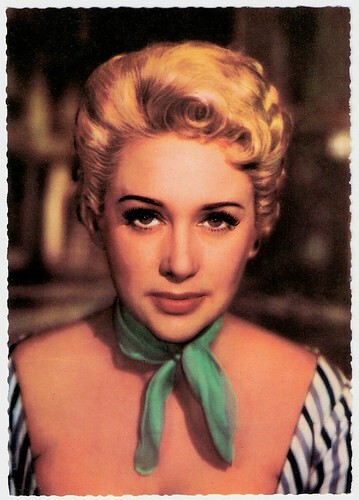
German postcard by ISV, no. D 9. Photo: Farabola.
Sources: (IMDb), Ronny de Schepper (Writer's Blog - Dutch), Wikipedia (English, French, and Dutch), and .

French postcard by Editions du Globe (E.D.U.G.), Paris, no. 132. Photo: Sam Lévin.

French postcard by Editions du Globe (E.D.U.G.), Paris, no. 162. Photo: Studio Harcourt.

French postcard by Editions du Globe (E.D.U.G.), Paris, no. 222. Photo: Studio Harcourt.

French postcard by Edition du Globe (E.D.U.G.), Paris, no. 320. Photo: Sam Lévin.

French postcard by Edition du Globe (E.D.U.G.), Paris, no. 321. Photo: Sam Lévin.

French postcard by Editions du Globe (E.D.U.G.), Paris, no. 357. Photo: Lucienne Chevert.

French postcard by Editions du Globe (E.D.U.G.), Paris, no. 432. Photo: Sam Lévin.
Anti-semitic propaganda
Martine Carol was born in 1920 as Marie Louise Jeanne Nicolle Mourer in Saint-Mandé, near Paris. 'Maryse' was the daughter of the freight forwarder Marcel Mourer and his wife (maiden name: Arley). She attended the Dominican School of Neuilly. Later Maryse studied at the École des Beaux-Arts in Paris and then earned a living as a model.
A chance meeting with comedian André Luguet steered her toward a career in the theatre. Carol joined the theatre company led by Gaston Baty, where she received acting lessons from Robert Manuel and later from René Clair and Jean Wall. She adopted the stage name Maryse Arley (after her mother's name) and made her 1940 stage debut with 'Phèdre' by Jean Racine. She appeared at the Théâtre de la Renaissance and Théâtre Montparnasse in Paris in plays such as 'La Route du tabac' (Tobacco Road) after Erskine Caldwell alongside Marcel Mouloudji , Alfred de Musset's 'Les Caprices de Marianne' and William Shakespeare's 'The Taming of the Shrew'. She also attended the acting classes of René Simon.
She made her first film appearances during the Occupation. She caught the eye of film director Henri-Georges Clouzot who hired her for his film Le Chat/The Cat, based on the novel by Colette , but the project was scrapped. In 1941, she appeared in a bit role alongside Pierre Fresnay and Jean Tissier in Le Dernier des six/The Last One of the Six (Georges Lacombe, 1941), which was based on a screenplay by Clouzot.
Like many French actors, she played in films financed by the German company Continental, directed by Alfred Greven. Carol appeared for Continental in Les Inconnus dans la maison/Strangers in the House (Henri Decoin, 1942), with Raimu , and in an openly anti-Semitic and anti-American propaganda film, the short Les Corrupteurs/The (Pierre Ramelot, 1942).
She first attracted attention in La ferme aux loups/Wolf Farm (Richard Pottier, 1943), which takes advantage of her photogenic beauty and ease in front of the camera despite a limited acting ability. Her co-actor François Périer invented her stage name Martine Carol as a tribute to Carole Lombard .
Carol was kidnapped by gangster Pierre Loutrel aka ‘Pierrot le Fou' (Crazy Pete), who tried to rape her in the Bois de Boulogne and afterwards sent her flowers and steaks (!) to apologise. After the liberation, she took a blonde haircut so that she looked even more like her idol Lana Turner . She was held captive, almost literally, by a new lover, John Ringling North of the Barnum Circus, but she escaped his golden cage.
In 1947 a torrid affair with handsome actor Georges Marchal , who was married to actress Dany Robin at the time, ended disastrously and she attempted suicide by taking an alcohol/drug overdose and throwing herself off a bridge into the Seine River. She was saved by a taxi driver who accompanied her there. Ironically, the unhappy details surrounding her suicide attempt renewed the fascination audiences had with Martine up until that time.
Throughout the 1940s, Martine Carol was a pin-up goddess and supporting actress in films like the comedy Voyage surprise/The Bride's Surprise (Pierre Prévert, 1947) and Les amants de Vérone/The Lovers of Verona (André Cayatte, 1949). She also appeared on the stage of the Theatre of the Renaissance. In 1949, she married Steve Crane, Lana Turner 's former husband and nicknamed "Mister Gigolo". She was obsessed with her appearance: she even had a new nose fitted by the legendary Dr. Claoué ("Le nez Claoué, le nez chic de la vraie Parisienne") to better resemble Turner. She lost a child in a water-skiing accident when she wanted to see the wedding of Rita Hayworth and Aga Kahn "from afar", as she was not invited.

French postcard by Editions P.I., Paris, no. 364. Photo: Lucienne Chevert.

French postcard by Editions P.I., Paris, no. 456. Photo: Lucienne Chevert.

French postcard by Editions P.I., Paris, no. 561. Photo: Lucienne Chevert.

Dutch postcard by DRC, no. F192-657, posted in 1958.

Vintage card. Photo: still for Lucrèce Borgia/Lucretia Borgia (Christian-Jaque, 1953).

German postcard by Kunst und Bild. Berlin, no. A 1146. Photo: Allianz-Film. Publicity still for Madame du Barry/Madame Dubarry (Christian Jacque, 1954).

West-German postcard by Kunst und Bild, Berlin, no. V 357. Photo: Gamma / Union / Rotzinger. Martine Carol in Lola Montès/Lola Montez (Max Ophüls, 1955).
Taunting, Kittenish Sexuality
In 1950 Martine Carol scored her first huge film success with the historical epic Caroline Cherie/Dear Caroline (Richard Pottier, 1950) - no doubt prompted by her nude scene, six years before Brigitte Bardot . The film was adapted from the popular novels of Cécil Saint-Laurent. Carol played a young aristocrat during the French Revolution who loves one man, but who, to save her life, often has to sacrifice her virtue and lend her body, which, however, does not always displease her. Martine Carol was off and running at the box office.
Caroline Cherie/Dear Caroline was a great public success: attracting 3.6 million spectators, it ranked ninth at the French box office for the year 1951. France had a new sex symbol. Two years later, filmmaker Jean Devaivre made a sequel, Un caprice de Caroline Chérie/Caroline Cherie (1952), in which Carol again displayed her taunting, kittenish sexuality. The sequel was also a great success with 2.8 million viewers.
The next important step in Carol's career was her meeting in 1952 with the much older filmmaker Christian-Jaque, who called on her for Adorables créatures/Adorable Creatures (Christian-Jaque, 1952), a comedy in which Daniel Gélin recalls all his conquests. It was love at first sight between Christian-Jaque and Carol. And the film was well received.
The couple continued spectacularly with costumed teasers such as Lucrèce Borgia/Sins of the Borgias (1953), Madame du Barry (1954), and the Emile Zola adaptation Nana (1954), all directed by Christian-Jacque who became her second husband in 1954. These starring roles made her France's equivalent of Marilyn Monroe . Her film romps were also typically done tastefully with an erotic twinge of innocence and gentle sexuality plus an occasional bubble bath thrown in as male bait.
Martine later divorced the director due to professional conflicts and long separations. She also starred in Belles de Nuit/ Beauties of the Night (René Clair, 1952) opposite Gérard Philipe , and in the last comedy directed by Preston Sturges, Les Carnets du Major Thompson/The Diary of Major Thompson (1955), based on the best-seller by Pierre Daninos.
One of her last major roles was as the title character in Lola Montés/Lola Montez (Max Ophüls, 1955), the tragic and true story of the great adventurer, circus attraction, and lover of various important men. Finally, she was taken seriously by the film critics. The story of the end of life of the fallen and impoverished courtesan Lola Montès, however, did not appeal to the public. Later, the work nevertheless became a classic of French cinema.

French postcard by Editions du Globe (E.D.U.G.), Paris, no. 365. Photo: Sam Lévin.

French postcard by Editions du Globe (E.D.U.G.), Paris, no. 564. Photo: Sam Lévin.

French postcard by Editions du Globe (E.D.U.G.), Paris, no. 690. Photo: Sam Lévin.

Dutch postcard by Gebr. Spanjersberg N.V., Rotterdam (Dutch licency holder for Ufa/Film-Foto, Berlin-Tempelhof), no. 3611. Photo: Sam Lévin / Unifrance Film.

German postcard by Kolibri-Verlag G.m.b.H. Minden/Westf., no. 1719. Photo: Gamma / Union / Vogelmann. Publicity still for Lola Montès (Max Ophüls, 1955) with Ivan Desny .

German postcard by Kolibri-Verlag, Minden-Westf., no. 1723. Photo: Gamma / Union / Vogelmann. Publicity still for Lola Montès (Max Ophüls, 1955).

West-German postcard by Ufa/Film-Foto, Berlin-Tempelhof, no. FK 2160. Photo: Vogelmann / Gamma / Union. Martine Carol in Lola Montez (Max Ophüls, 1955).
Severe Decline
By the mid-1950s, Brigitte Bardot had replaced Martine Carol as the national Sex Siren, and the voluptuous blonde's career went into a severe decline. In the crime comedy Nathalie (Christian-Jaque, 1957), she played a coquettish, clever haute couture mannequin, a role that was made for her. This last film with Christian-Jaque still made the film box-office ring, although the film had to do with much less budget than usual. That limited budget was the direct consequence of Carol's decreased prestige due to the Lola Montès fiasco.
In 1960, she successfully played Joséphine de Beauharnais, Napoleon's first wife, in the historical fresco Austerlitz/The Battle of Austerlitz (Abel Gance, 1960). In the next two years, she worked several more times with classically trained filmmakers such as Georges Lautner and Gilles Grangier. Grangier engaged her for his police comedy Le cave se rebiffe/The Counterfeiters (Gilles Grangier, 1961) at the intercession of Jean Gabin , who had fond memories of his collaboration with Carol in Miroir/Mirror (Raymond Lamy, 1947). Le cave se rebiffe was her last commercial success.
Her last significant role was as Contessa Vitelleschi who supports a young revolutionary on the run from government troops in Roberto Rossellini's historical drama Vanina Vanini/The Betrayer (1961) with Laurent Terzieff . This mature role did not revive the audience's interest. Depressed, she turned alarmingly reclusive while a third marriage to French doctor Andre Rouveix also soured by 1962. She sought refuge in alcohol and narcotics and followed impossible slimming regimes. For five years she stayed away from the big screen.
She returned in the little-seen Italian production Lasciapassare per l'inferno/Passport to hell (George Fuller, 1966) opposite Guy Madison and Klaus Kinski . Her last film was Hell Is Empty (John Ainsworth, Bernard Knowles, 1967). Production was briefly halted due to her illness. This is why the film had two directors. Although filmed in 1963 it was not released until 1967. By the time of the release of the film, two of the leading ladies, Patricia Viterbo and Martine, were already dead.
Martine Carol’s last marriage to fourth husband Mike Eland, an English businessman, had seemed hopeful. Eland was a friend of her first husband, Steve Crane, and had been in love with her for a long time. Eland tried to put her luxury life and career back on track but in 1967, he found her dead in the bathroom of her room in the Hotel de Paris in Monaco.
Martine Carol died of a heart attack. She was only 46. Newspapers hinted at a possible drug overdose but nothing was ever proven. She was initially buried in the Père Lachaise Cemetery of Paris. But her grave was violated - some media reported that she had been interred with her jewels. Martine Carol was then buried in the Grand Jas Cemetery of Cannes.

German postcard by Universum-Film Aktiengesellschaft, Berlin-Tempelhof, no. CK-2. Retail price: 30 Pfg. Photo: Gérard Décaux / Ufa.

West-German postcard by Ufa/Film-Foto, Berlin-Tempelhof, no. FK 3478. Photo: G.B. Poletto / Ufa.

Austrian postcard by Kellner Fotokarten, Wien, no. 1030. Photo: Titanus / Union. Martine Carol in Difendo il mio amore/Defend My Love (Giulio Macchi, 1957).

West-German postcard by Ufa/Film-Foto, Berlin-Tempelhof, no. FK 4064. Retail price: 25 Pfg. Photo: Ufa. Publicity still for The Stowaway (Ralph Habib, Lee Robinson, 1958).

Yugoslavian postcard by Studio Sombor, no. 314.

German postcard by WS-Druck, Wanne-Eickel, no. F 5. Photo: Collignon. Publicity still for Lola Montès (Max Ophüls, 1955).

German postcard by Ufa, Berlin-Tempelhof, no. 58. Retail price: 50 Pfg. Photo: G.B. Poletto / Ufa.

Italian postcard by Rotalfoto, Milano, no. 267. Photo: Cei Incom.

German postcard by ISV, no. D 9. Photo: Farabola.
Sources: (IMDb), Ronny de Schepper (Writer's Blog - Dutch), Wikipedia (English, French, and Dutch), and .
Published on February 20, 2022 22:00
February 19, 2022
Film Star Autograph Portrait Series
Film stars have always had a great appeal for autograph collectors from the pioneers of Silent Movies to the Hollywood Legends of the Golden Age of the 1930s to 1950s and through to the celebrity A-list stars of the present day. Publishers sometimes printed autographs on postcards of the stars. A typical example is the Film Star Autograph Portrait Series, published in Great Britain in the 1950s by L.D. LTD, in London.
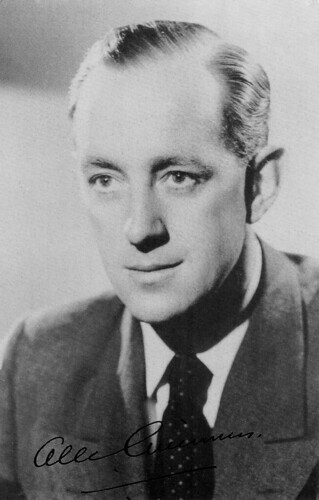
British postcard in the Film Star Autograph Portrait Series by L.D. LTD., London, no. 53.
English actor Sir Alec Guinness (1914-2000) was one of the most versatile and subtle actors of his time, in the cinema and on television no less than on the stage. He was master of disguise in several of the classic Ealing Comedies, including Kind Hearts and Coronets (1949) in which he played eight different characters. He later won the Academy Award for Best Actor for his role as Colonel Nicholson in The Bridge on the River Kwai (1957), and he is probably even better known for playing Obi-Wan Kenobi in the original Star Wars trilogy (1977-1983).
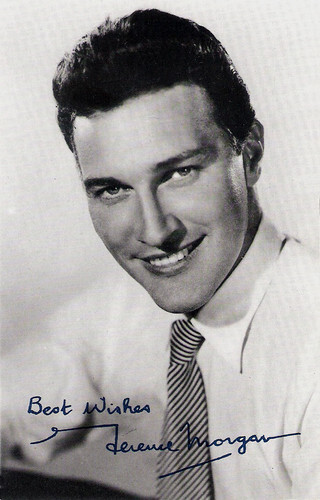
British postcard by L.D. LTD., London, in the Film Star Autograph Portrait series, no. 55. Photo: J. Arthur Rank Organisation LTD.
Tall, dark, and charming English actor Terence Morgan (1921-2005) played many attractive villains and criminals in British films. But he is probably best remembered for his starring role in the TV historical adventure series Sir Francis Drake (1961-1962), about the first Englishman to sail around the world. After this success, parts started to dry up as Morgan was no longer seen as ‘the bad guy’.
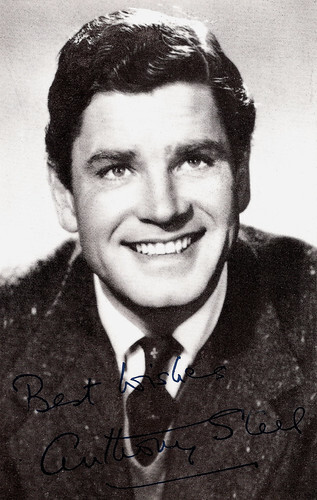
British postcard by L.D LTD., London in the Film Star Autograph Portrait Series, no. 57. Photo: J. Arthur Rank Organisation.
Tall and dashing Anthony Steel (1920-2001) was one of Britain’s most popular matinee idols during the early 1950s. He also was the stiff-upper-lipped star of many distinguished British war films and made more than 60 film appearances between 1948 and 1980. In the 1980s his once brilliant career collapsed into poverty and destitution.
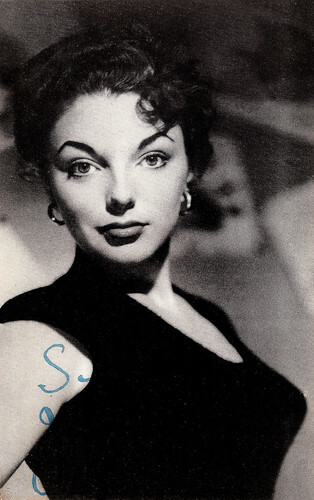
British postcard by L.D. LTD., London in the Film Star Autograph Portrait Series, no. 60. Photo: J. Arthur Rank Organisation.
Glamorous English actress Joan Collins (1933) is one of the great survivors of the cinema. She began in the early 1950s as a starlet of the British film. 20th Century Fox brought her to Hollywood as their answer to Elizabeth Taylor. In the 1970s she was the ‘Queen of the B-pictures’, but in the 1980s Joan became the highest-paid TV star, thanks to Dynasty.
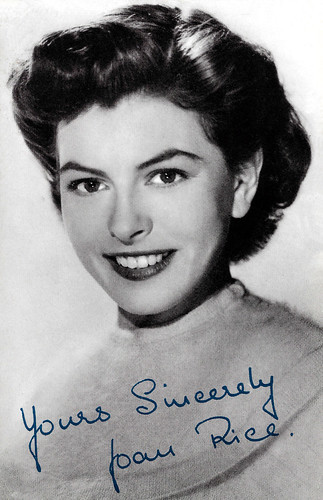
British postcard in the Film Star Autograph Portrait Series by L.D. Ltd., London, no. 64. Photo: J. Arthur Rank Organisation.
Joan Rice (1930-1997) was a pert, dark-haired leading lady, who enjoyed a brief flurry of popularity in British films of the early- to mid-1950s. She is probably best known as Maid Marian to Richard Todd's Robin Hood in Disney's The Story of Robin Hood and His Merrie Men (1952) and as Dalabo in His Majesty O'Keefe (1954) with Burt Lancaster.
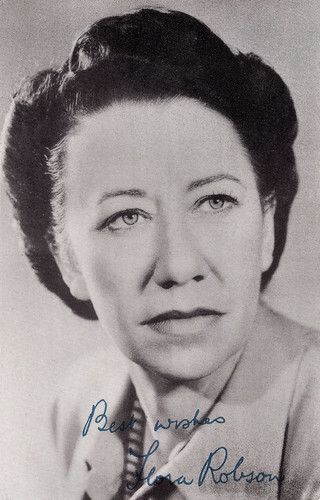
British postcard in the Film Star Autograph Portrait Series, no. 65, by L.D. Ltd., London. Photo: J. Arthur Rank Organisation.
British Flora Robson (1902-1984) was one of the half-dozen finest dramatic actresses of her generation. Her range extended from queens to murderesses and she was particularly renowned for her performances in plays demanding dramatic and emotional intensity. Her best-known film role was that of Queen Elizabeth I in both Fire Over England (1937) and The Sea Hawk (1940). However, her career was a constant struggle to achieve the roles worthy of her talents.
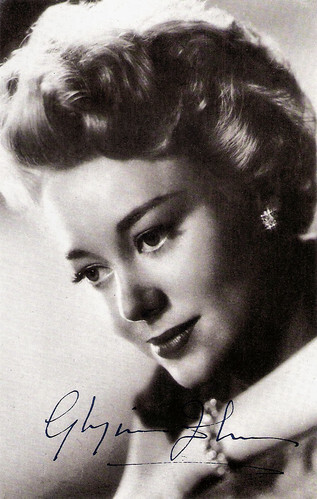
British postcard in the Film Star Autograph Portrait series by L.D. LTD., London, no. 66. Photo: J. Arthur Rank Organisation. Publicity still for The Seekers (Ken Annakin, 1954).
Husky voiced Glynis Johns (1923) is a retired Welsh stage and film actress, dancer, pianist and singer. She is best known for her film roles as a mermaid in the British comedy Miranda (1948) and as suffragette mother Winifred Banks in Walt Disney's Mary Poppins (1964). On Broadway, she created the role of Desiree Armfeldt in A Little Night Music, for which she won a Tony Award.
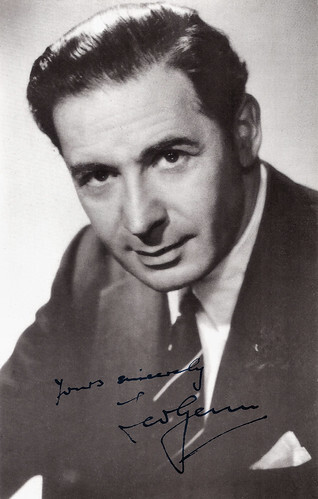
British postcard by L.D. Ltd., London in the Film Star Autograph Portrait Series, no. 72. Photo: J. Arthur Rank Organisation. Publicity still for Personal Affair (Anthony Pelissier, 1953).
Leo Genn (1905-1978) was a refined British stage and film actor - and barrister. Known for his relaxed charm and his deep black velvet voice, he also had success in Hollywood classics like Quo Vadis (1951) and Moby Dick (1956).
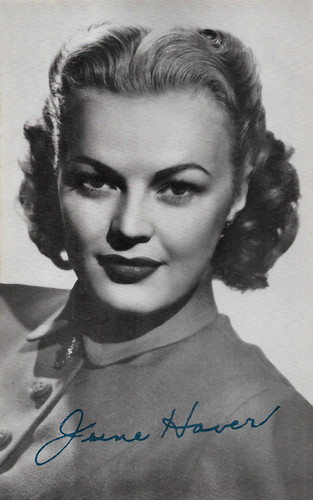
British postcard in the Film Star Autograph Portrait Series by L.D. Ltd, London, no. 88. Photo: 20th Century Fox.
American film actress June Haver (1926-2005) was a popular alternative to the musical film stars Betty Grable and Alice Faye in several musicals of the 1940s. Haver's second husband was the actor Fred MacMurray, whom she married after she retired from show business.
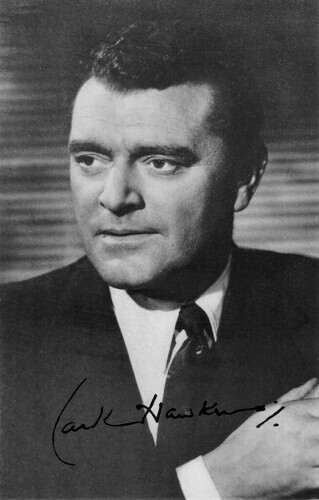
British postcard by L.D. LTD., London, in the Film Star Autograph Portrait series, no. 96. Photo: J. Arthur Rank Organisation LTD. Publicity still for The Seekers (Ken Annakin, 1954).
Square-jawed, craggy-looking Jack Hawkins (1910-1973) was an English actor who worked on stage and in film from the 1930s until the 1970s. One of the most popular British film stars of the 1950s, he often played coolly efficient military officers in such films as The Cruel Sea (1953), Bridge on the River Kwai (1957), and Lawrence of Arabia (1962).
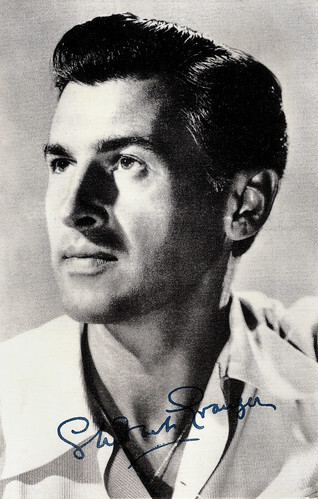
British postcard in the Film Star Autograph Portrait Series, by L.D. LTD., London, no. 122. Photo: M.G.M. Stewart Granger in Young Bess (George Sidney, 1953).
English actor Stewart Granger (1913-1993) made over 60 films but is mainly associated with heroic and romantic leading roles. He was quoted: “I've never done a film I'm proud of”. Tall, dark, dignified, and handsome, Granger became England's top box office star in the 1940s which attracted Hollywood's attention.
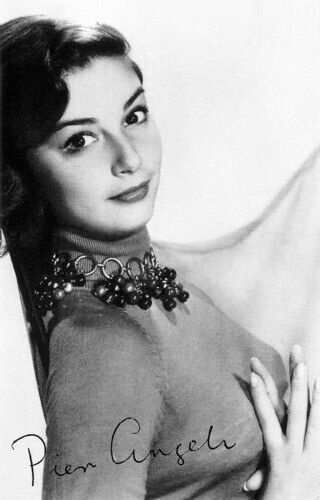
British postcard in the Film Star Autograph Portrait Series by L.D. Ltd., London, no. 133. Photo: M.G.M. Publicity still for Sombrero (Norman Foster, 1953).
Before she was 20, Pier Angeli (1932-1971) had starred with Vittorio de Sica in two Italian box office hits and was discovered by Hollywood. There she won a Golden Globe, had an affair with James Dean, and died before she was 40.
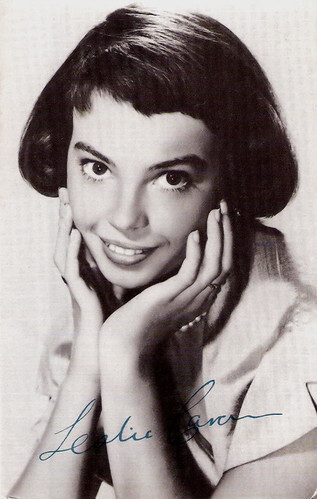
British postcard by L.D. Ltd., London in the Film Star Autograph Portrait Series, no. 138. Photo: MGM. Publicity still for Lili (1953).
French film actress and dancer Leslie Caron (1931) was one of the most famous Hollywood stars in the 1950s. She is best known for the waif-like gamines in musical films like Gigi (1958), Lili (1953), and An American in Paris (1951). Since the 1960s she’s also working in European cinema.
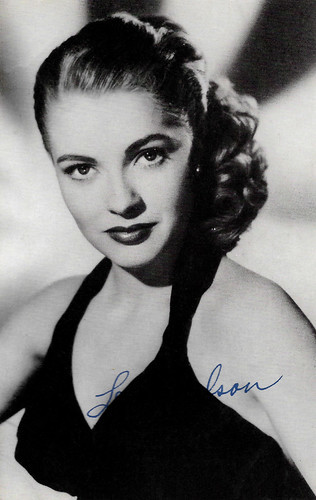
British postcard in the Celebrity Autograph Series by L.D. Ltd., London, no. 165. Photo: Universal-International.
Beautiful blonde American actress and former model Lori Nelson (1933-2020) started acting at the age of 2 and she was Miss Encino at age 17. Nelson played the lead in several Universal films of the 1950s and is best known for her roles in B-films like the 3D fantasy Revenge of the Creature (1955) and Day the World Ended (1955). After several years at Universal, she freelanced in films and TV.
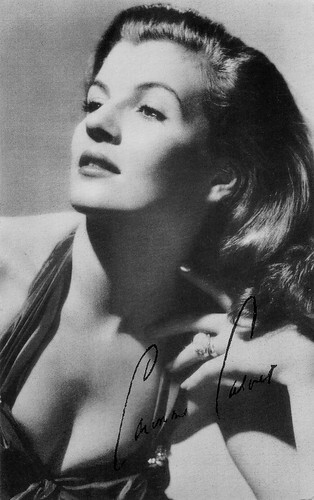
British postcard in the Celebrity Autograph Series by L.D. LTD., London, no. 172. Photo: Universal-International.
Alluring French leading lady Corinne Calvet (1925-2001) made a big splash in Hollywood in the early 1950s with her sultry looks and her highly publicised legal battles.

British postcard in the Film Star Autograph Portrait Series by L.D. LTD., London, no. 53.
English actor Sir Alec Guinness (1914-2000) was one of the most versatile and subtle actors of his time, in the cinema and on television no less than on the stage. He was master of disguise in several of the classic Ealing Comedies, including Kind Hearts and Coronets (1949) in which he played eight different characters. He later won the Academy Award for Best Actor for his role as Colonel Nicholson in The Bridge on the River Kwai (1957), and he is probably even better known for playing Obi-Wan Kenobi in the original Star Wars trilogy (1977-1983).

British postcard by L.D. LTD., London, in the Film Star Autograph Portrait series, no. 55. Photo: J. Arthur Rank Organisation LTD.
Tall, dark, and charming English actor Terence Morgan (1921-2005) played many attractive villains and criminals in British films. But he is probably best remembered for his starring role in the TV historical adventure series Sir Francis Drake (1961-1962), about the first Englishman to sail around the world. After this success, parts started to dry up as Morgan was no longer seen as ‘the bad guy’.

British postcard by L.D LTD., London in the Film Star Autograph Portrait Series, no. 57. Photo: J. Arthur Rank Organisation.
Tall and dashing Anthony Steel (1920-2001) was one of Britain’s most popular matinee idols during the early 1950s. He also was the stiff-upper-lipped star of many distinguished British war films and made more than 60 film appearances between 1948 and 1980. In the 1980s his once brilliant career collapsed into poverty and destitution.

British postcard by L.D. LTD., London in the Film Star Autograph Portrait Series, no. 60. Photo: J. Arthur Rank Organisation.
Glamorous English actress Joan Collins (1933) is one of the great survivors of the cinema. She began in the early 1950s as a starlet of the British film. 20th Century Fox brought her to Hollywood as their answer to Elizabeth Taylor. In the 1970s she was the ‘Queen of the B-pictures’, but in the 1980s Joan became the highest-paid TV star, thanks to Dynasty.

British postcard in the Film Star Autograph Portrait Series by L.D. Ltd., London, no. 64. Photo: J. Arthur Rank Organisation.
Joan Rice (1930-1997) was a pert, dark-haired leading lady, who enjoyed a brief flurry of popularity in British films of the early- to mid-1950s. She is probably best known as Maid Marian to Richard Todd's Robin Hood in Disney's The Story of Robin Hood and His Merrie Men (1952) and as Dalabo in His Majesty O'Keefe (1954) with Burt Lancaster.

British postcard in the Film Star Autograph Portrait Series, no. 65, by L.D. Ltd., London. Photo: J. Arthur Rank Organisation.
British Flora Robson (1902-1984) was one of the half-dozen finest dramatic actresses of her generation. Her range extended from queens to murderesses and she was particularly renowned for her performances in plays demanding dramatic and emotional intensity. Her best-known film role was that of Queen Elizabeth I in both Fire Over England (1937) and The Sea Hawk (1940). However, her career was a constant struggle to achieve the roles worthy of her talents.

British postcard in the Film Star Autograph Portrait series by L.D. LTD., London, no. 66. Photo: J. Arthur Rank Organisation. Publicity still for The Seekers (Ken Annakin, 1954).
Husky voiced Glynis Johns (1923) is a retired Welsh stage and film actress, dancer, pianist and singer. She is best known for her film roles as a mermaid in the British comedy Miranda (1948) and as suffragette mother Winifred Banks in Walt Disney's Mary Poppins (1964). On Broadway, she created the role of Desiree Armfeldt in A Little Night Music, for which she won a Tony Award.

British postcard by L.D. Ltd., London in the Film Star Autograph Portrait Series, no. 72. Photo: J. Arthur Rank Organisation. Publicity still for Personal Affair (Anthony Pelissier, 1953).
Leo Genn (1905-1978) was a refined British stage and film actor - and barrister. Known for his relaxed charm and his deep black velvet voice, he also had success in Hollywood classics like Quo Vadis (1951) and Moby Dick (1956).

British postcard in the Film Star Autograph Portrait Series by L.D. Ltd, London, no. 88. Photo: 20th Century Fox.
American film actress June Haver (1926-2005) was a popular alternative to the musical film stars Betty Grable and Alice Faye in several musicals of the 1940s. Haver's second husband was the actor Fred MacMurray, whom she married after she retired from show business.

British postcard by L.D. LTD., London, in the Film Star Autograph Portrait series, no. 96. Photo: J. Arthur Rank Organisation LTD. Publicity still for The Seekers (Ken Annakin, 1954).
Square-jawed, craggy-looking Jack Hawkins (1910-1973) was an English actor who worked on stage and in film from the 1930s until the 1970s. One of the most popular British film stars of the 1950s, he often played coolly efficient military officers in such films as The Cruel Sea (1953), Bridge on the River Kwai (1957), and Lawrence of Arabia (1962).

British postcard in the Film Star Autograph Portrait Series, by L.D. LTD., London, no. 122. Photo: M.G.M. Stewart Granger in Young Bess (George Sidney, 1953).
English actor Stewart Granger (1913-1993) made over 60 films but is mainly associated with heroic and romantic leading roles. He was quoted: “I've never done a film I'm proud of”. Tall, dark, dignified, and handsome, Granger became England's top box office star in the 1940s which attracted Hollywood's attention.

British postcard in the Film Star Autograph Portrait Series by L.D. Ltd., London, no. 133. Photo: M.G.M. Publicity still for Sombrero (Norman Foster, 1953).
Before she was 20, Pier Angeli (1932-1971) had starred with Vittorio de Sica in two Italian box office hits and was discovered by Hollywood. There she won a Golden Globe, had an affair with James Dean, and died before she was 40.

British postcard by L.D. Ltd., London in the Film Star Autograph Portrait Series, no. 138. Photo: MGM. Publicity still for Lili (1953).
French film actress and dancer Leslie Caron (1931) was one of the most famous Hollywood stars in the 1950s. She is best known for the waif-like gamines in musical films like Gigi (1958), Lili (1953), and An American in Paris (1951). Since the 1960s she’s also working in European cinema.

British postcard in the Celebrity Autograph Series by L.D. Ltd., London, no. 165. Photo: Universal-International.
Beautiful blonde American actress and former model Lori Nelson (1933-2020) started acting at the age of 2 and she was Miss Encino at age 17. Nelson played the lead in several Universal films of the 1950s and is best known for her roles in B-films like the 3D fantasy Revenge of the Creature (1955) and Day the World Ended (1955). After several years at Universal, she freelanced in films and TV.

British postcard in the Celebrity Autograph Series by L.D. LTD., London, no. 172. Photo: Universal-International.
Alluring French leading lady Corinne Calvet (1925-2001) made a big splash in Hollywood in the early 1950s with her sultry looks and her highly publicised legal battles.
Published on February 19, 2022 22:00
Paul van Yperen's Blog
- Paul van Yperen's profile
- 13 followers
Paul van Yperen isn't a Goodreads Author
(yet),
but they
do have a blog,
so here are some recent posts imported from
their feed.



